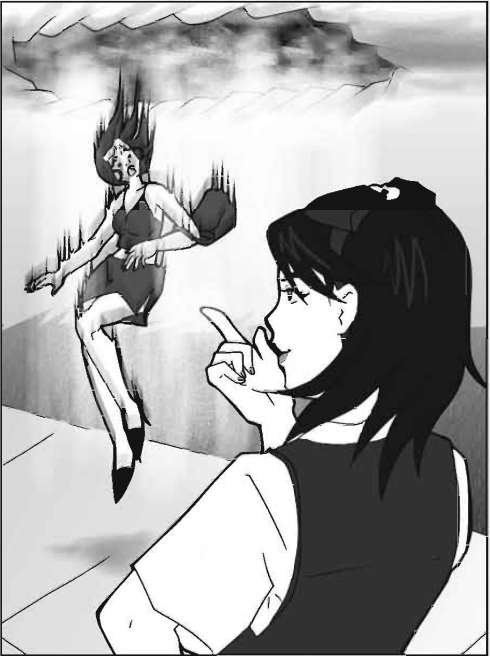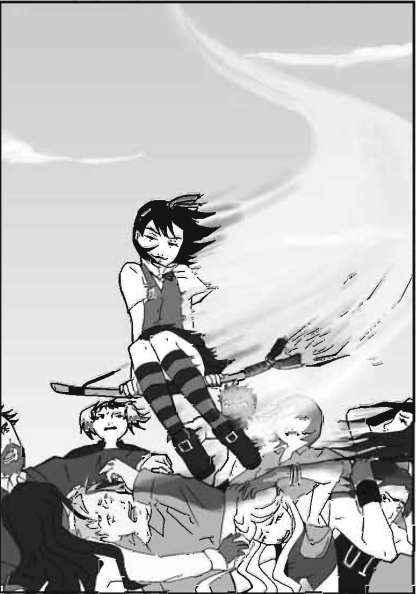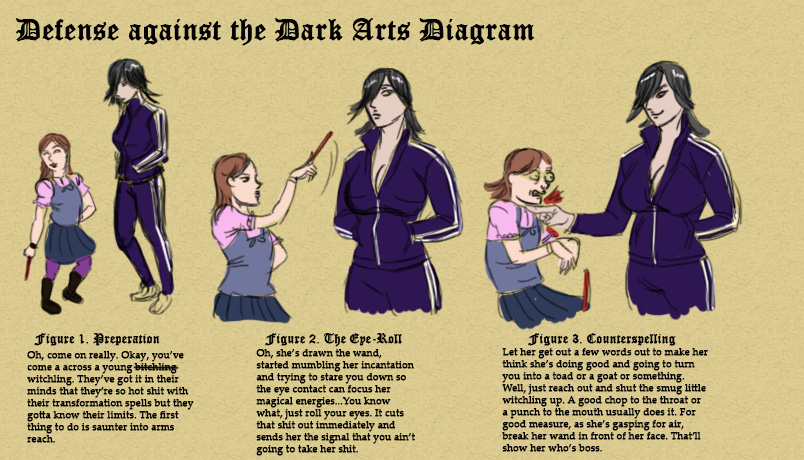Witch Girls Adventures by Adnachiel
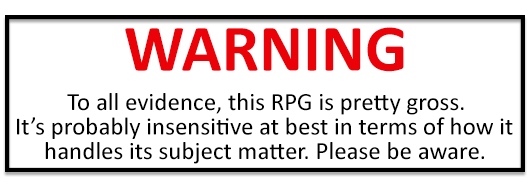
Background, Intro Comic, and Foreword
Original SA postAlien Rope Burn posted:
From what I know of it, it actually reminds me of Wraeteteheue, where a superior
magical race torments humanity becausefetishmight makes right. I'm morbidly curious to see how much of that shows in the RPG.
Yeah, this game's setting reminds me a lot of Wraethu too. It's pretty much an unholy combination of that, Harry Potter , and a Gaia Online roleplay.
Speaking of which...
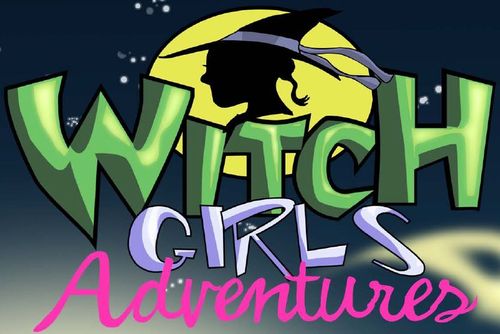
Part 1: Background, Intro Comic, and Foreward
Hey you, do you have a young daughter that you would like to share your love of tabletop RPGs with, but don't think Dungeons & Dragons or any of the other available fare will appeal to her? Do you wish that J.K. Rowling would release a Harry Potter RPG and don't mind settling for a really girly knock off until then? Do you get off to playing a little girl that transforms innocent people into inanimate objects and prey animals that are eaten shortly after? Well, the fine folks at Channel M Publishing have the perfect game for you.
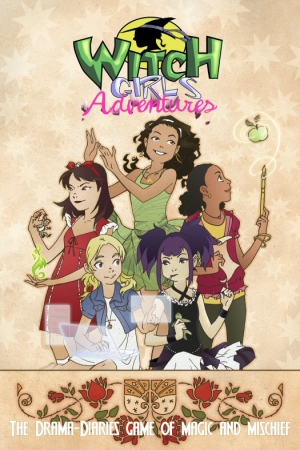
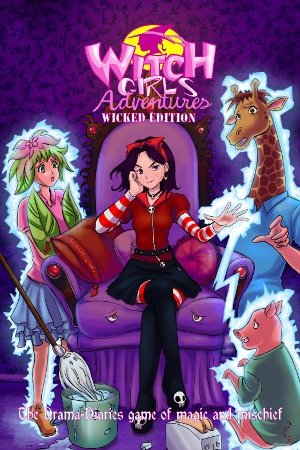
(And if the last statement applies to you, you're creepy.)
Published in 2009, Witch Girls Adventures is an indie game based on Witch Girls , Witch Girls Tales , and Princess Lucinda , three of Channel M owner Malcolm Harris' comic series that he originally published under the name of his old company, Mangagraphix/Manga Graphix/However he feels like formatting it at that particular moment. The premise of the game is that the players are young witches or "witch girls" who attend one of the many schools set up around the world to teach young witches the arcane arts, all the while making friends, getting back at catty mean girls, and deciding what to wear to the big dance. The goal of the series, according to Harris, is to get tween and teen aged girls (the official demographic is ages 11 and up) interested in tabletop RPGs. Taken at face value, it's a cute looking game and a decent attempt at such. However, if you dig deeper, you'll find a few eyebrow raising flaws.
For one, the official setting and NPCs are pretty horrible.
For two, Harris has a transformation fetish, and it's found its way into the game's art and contents. Not only that, but the setting itself comes from an old transformation fetish site/”e-zine”, “The Shrinking Sorceress”, that he used to run.
When I did research for this, I noticed that whenever the fetish thing was brought up on other forums, either Harris or some white knight would post and declare that it was just a rumor started by some asshole and no one has provided proof. It's not, I can prove it, and I'm going to just get it out of the way right now.
Here is archive.org's backup of The Shrinking Sorceress.
 (There's no porn. Just a bunch of creepy looking 3D poser images.) Notice the copyright info at the bottom of the page.
(There's no porn. Just a bunch of creepy looking 3D poser images.) Notice the copyright info at the bottom of the page.
quote:
All pictures and photos belong to their respective creators. Shrinking Sorceress and Shrinking Sorceress Magazine belong to Manga Graphix Corp.
Here is a screenshot of the “Stories” page.
 Two of the stories listed are titled “Witch girl”. One of the characters on some of the stories is named Denora. The character in the “Witch Girl” stories is named Claudia. In WGA, there is an adult witch named Denora Desade. She's a famous “wicked witch” who wrote a book about her life and how to properly be an asshole to everyone. It's available as an item.
Two of the stories listed are titled “Witch girl”. One of the characters on some of the stories is named Denora. The character in the “Witch Girl” stories is named Claudia. In WGA, there is an adult witch named Denora Desade. She's a famous “wicked witch” who wrote a book about her life and how to properly be an asshole to everyone. It's available as an item.
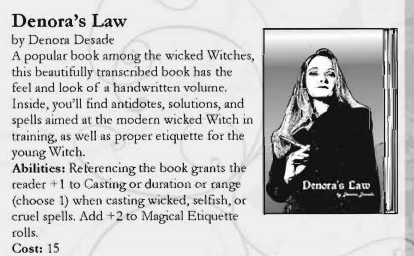
Here is her MySpace profile. Notice how she is friends with MANGA GRAPHIX, who uses a picture that can also be found on Channel M's main website. She also has a daughter named Claudia. Both mention appearing in the Witch Girls comic on the same page.
Here is a picture of Denora on Amazon Studios as a redhead , same as she is on the SS site. Note the author of the script.
The Stories page on TSS and some of the other pages I linked also mention witches named Ebony and Circe. In WGA, the former is also the name of the author of a book on voodoo that is also available as an item and a teacher at Willow-Mistt, and the latter shares her name with an NPC (who is also the mythical Circe) who runs a magical bookstore in New York City.
There you go. Mr. Harris let his fetish seep into his game for little girls and that's why a lot of the artwork is witches turning humans and other witches into things. Now for the game itself.
The game line consists of 5 books: The core rulebook, 3 supplements (the “Star Creation Guide”, “All About The Voodollars”, and “13 Magazine: Issue 1”), and a pre-made campaign (“The Pirates of Buccaneer Hill”). (A reprinting of the older Witch Girls comic also includes setting info about some of the NPCs and one of the magic schools.) A few months back, Channel M finished fund raising for a 2nd edition of the core titled Witch Girls Adventures: Book of Shadows , which supposedly contains improved rules and all that other good stuff. (Its release is currently delayed because, according to the official Facebook page , Harris is getting ready to sue someone.) Hopefully, the list of improvements includes getting rid of all of the horrible, stupid, and creepy shit I am going to go over. If that's the case, then more power to him.
The game also has its own theme song and a dumb little homemade movie about a bunch of witch girls taking a field trip to a convention and causing bodily harm to the unfortunate nerds that they come across. (This is actually the SECOND version of that movie. There used to be an older (full) video with even worse audio that was filmed at a different convention with different girls. It was taken off of Youtube a while ago. (This isn't the only time they've tried to make a movie based on the comics and universe . Most of the attempts have never seen the light of day.) If you don't feel like reading my posts, then at least click on those two links.
Now, there are actually two versions of the 1st edition core rulebook: “Nice” and “Naughty/Wicked”. The only difference between the two is the cover art and the opening comic. I have the Nice version, and the picture on the left at the top of the post is the cover for it. I have no idea what the comic in the Naughty version is about.
Intro Comic: “Witch Hunt”
The art in the book ranges from “Good” to “Badly Traced”. The intro comic's art falls into the former, in my opinion.
The comic (which was written by Harris and drawn by someone else) starts off with a group of students at the Maine based Willow-Mistt (sic) School of Magic being reprimanded by the school's headmistress, Amora Mistt, for raiding the school's kitchen. All four of the girls are main characters from the Witch Girls Tales comics. They are:
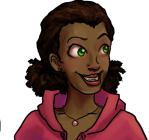
Amber Davis
The token black girl. Her mother is a witch and her father is a linebacker in the NFL (presumably for the Bears since she's from Chicago). She's athletic, likes shopping, and wants to be the best fashion designer ever. Like a lot of female black characters, she is the embodiment of

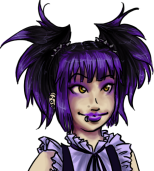
Lillian Tamako
The Anime who is pulling double duty as The Goth. Her family is descended from a long line of Japanese witches called "The Maho" who were thought to have died out until she came along. Her last name make me think of tomaccos from The Simpsons and, based on a Google search, is apparently a given name, not a surname.
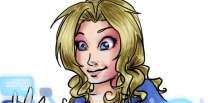
Monica Green
The super shy nerd with a dead father, new step family angst, perfect grades, and an affinity for computers. Meh.
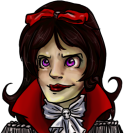
Princess Lucinda Nightbane
(To be honest, one of the reasons I did these little pointless bios was so I could have an excuse to post this picture. It's from the game's site.)
The 12 year old princess of a multi-world empire in some magical dimension who was sent to Earth along with her older sister, Millicent, after a bunch of heroes killed her evil tyrant parents. She's a little stuck up bitch and sees pretty much everyone, especially humans, as being beneath her. Lucinda is the unofficial “mascot” of the game and is usually the character responsible for turning people into shit in the artwork. (In fact, it's actually her specialty. I will explain later.)
Lucinda is, hands down, one of the most annoying and unlikable characters I have ever seen in anything. She's a big ol' Mary Sue, her personality is insufferable (i.e. She wants to rule the world and frequently tells people to bow and serve her, but she's a “cute” little girl so it's supposed to be endearing I guess), and even worse, she's fucking everywhere in the game's materials. I could go on for days about why she is a horrible character and I probably will later in a separate post.
After some banter to establish personalities, Headmistress Mistt says that she will overlook their crime if they go to Los Angeles and retrieve a new student and "late bloomer", Rosa Montoya, for her. (Witches can start their magical training as young as 6 years old. Rosa is 12.) See, Rosa has had a "hard existence" and doesn't believe in magic. If they don't get to her soon, she will will her budding powers away with her non-belief.
Why send a bunch of 12-15 year olds cross country to a major city alone to do an adult's job? It's a good lesson in teamwork, according to Ms. Mistt.
Once in LA, the group immediately gets lost despite knowing “Locator spells”. (Monica laments about not bringing her computer with the “GPS spell” on it.) A small Hispanic (you can tell because they use random Spanish phrases when they talk) gang with matching vests with wolf heads on the back ambushes them. After some more banter, the girls learn that the only named gang member, Juse, is Rosa's older brother. The guys demand that the girls give them their money. They get their asses handed to them. Lillian, who specializes in Necromancy (natch), somehow knows that the very alley they are standing in was built over a graveyard and summons up a bunch of skeletal arms to hold one of the guys down. Amber levitates Juse. Monica, who is scared shitless over being in the city, cowers behind an invisible shield, which another guy runs into and knocks himself out.
Lucinda turns one of the gang members into a frog and another into a cockroach. The frog eats the cockroach.
The cockroach guy dies.
It's played for laughs.
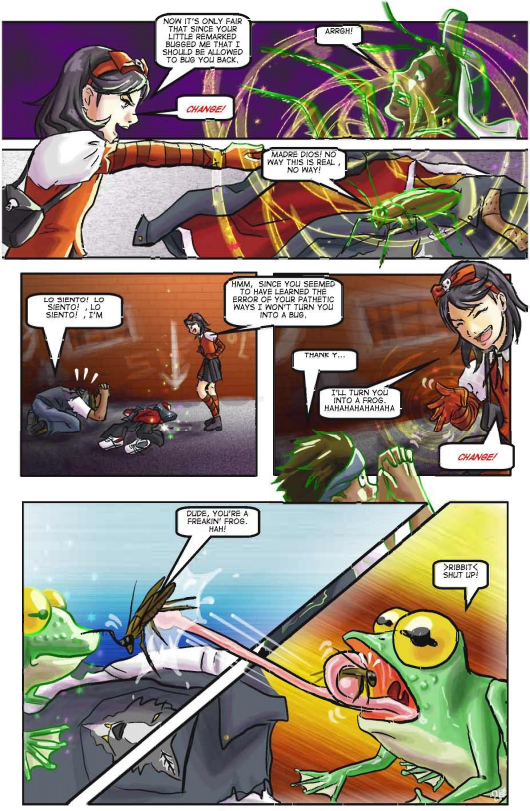
Did I mention that Lucinda is horrible and I hate her?
Juse's head is put in an energy cage. All of the girls threaten to do horrible shit to him if he doesn't tell them where Rosa is. This includes Monica, who suddenly grows a spine and threatens to rip his soul out and make it her slave.
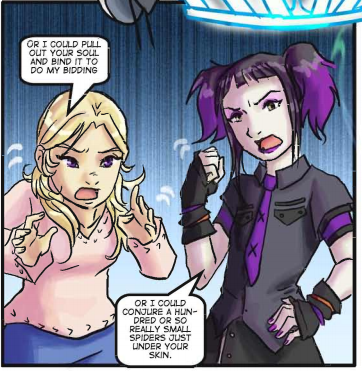
Consistency?! What's that?!
Cut to the girls showing up at Rosa's front door and carrying the now action figure sized Juse with them. Another cut later and the girls have explained everything to Rosa, who is immediately onboard when Lucinda tells her that she can use her powers to get back at people who call her "stupido", like her brother. No mess, no angst, no confusion. Headmistress Mistt watches from her crystal ball, pleased with the results, even if she thinks their methods were “a little unorthodox”. She doesn't bat an eye at the fact that someone died in the process.
Now, you're probably thinking to yourself, “They just revealed themselves to normal humans. Don't witches in this universe have some sort of secrecy law in place?” They do, but because of the way it's set up, the girls will not get in any sort of trouble for killing a relatively defenseless person, injuring another, and mentally scarring several others, nor are they or anyone else in the witch community obligated to undo the spells. (I will explain when the setting chapter comes up.)
This game is for kids!

After the comic and before the table of contents is a foreward by Emily Foster, one of Channel M's three full time employees, their "Assistant/Convection Organizer" and one of the book's proofreaders. A job she is not very good at, because the opening comic has at least 2 typos ("Tell that to the ice cream you ate you Amber", "I hope your 'beat down insurance" is bad up, kid") and 3 statements that were left unfinished because they ran out of space in the word bubbles.
She rambles on a bit about what an honor it is to be writing the “first page of the book” that “everyone opens up to read'. (Not true. Technically, that would be the intro comic.) Finally, she says that there is one sentence that she hopes that, by saying, will convince people to buy the book: “With imagination, anything is possible.”
Foster continues by saying that as people grow up, they lose their imagination and become boring due to the “weight and responsibilities of being a grown-up”. What's worse, society encourages teenagers to “give up their imagination and their individuality and become responsible grown-ups.” The book is a guide for one's imagination and that one doesn't necessarily need dice or a calculator (even though the game system requires a lot of different dice and some basic math) or “trade your cool shades for nerdy glasses.” In conclusion, the stupid boring adults will think that the rulebook is an instruction manual and that it's okay because the kids using it are learning math, teamwork, and responsibility, while it is actually allowing the player to use magic and “going to a school so much better than your own with teachers who are interested in each individual in their class.”
Foster seems to be forgetting the fact that she is working in an industry where a lot of the products are marketed towards older teens and adults. I am posting this on a very active forum dedicated to discussing and using those products that, thanks to a paywall, is mostly made up of adults. Products that requires an active imagination to get the most out of. I'm going to assume that she is either naïve or is just trying to appeal to the “too cool for you” teenage girls that this game is targeting.
After the foreward, there is a standard “Magic is not real and you can't cast anything with this book, stupid” disclaimer.
Up Next: Actual game stuff
Introduction and Cliques
Original SA postBieeardo posted:
I presume that Ebony the voudonista comes straight from New Orleans, care of Anne Rice?
Yup. Her last name is Le Rue and her bio says she's from New Orleans.

Witch Girls Adventures: Part 2: Introduction and Cliques
Chapter 1 starts off with a quote from a fictional textbook. I'm just going to quote the whole thing because it's... interesting.
”Initiate's Esoteric History Book, 3rd Edition, Bell and Candle Book Publisher, 1809” posted:
Magic is real...
It is in the wind and rain. It is in stone and fire. And occasionally, in the souls of people.
Lilith was the first. But women blessed by magic have since the dawn of time been a source of fear. However, despite that fear, some have sought her power for insight, knowledge, and healing.
Still, fear is a powerful thing, and among humans, it is a driving force for many atrocities – most of which they soon regret.
Her name is spoken with reverence throughout history. Priestesses, Oracles, Goddesses, and Queens. Circe, Medea, Yemaya, the Blue Corn Woman, and Amaterasu.
Her name is vilified and feared throughout time. Wise Woman, Shaman, Momba... Witch.
Once a protector and mother of civilization, she was soon hunted by the untrusting, the ignorant, and the arrogant. And though she may think she's alone, there were always others.
And together they showed the Mundanes they never were the masters of their world. They learned eventually that power comes in all shapes and sizes.
So be nice.
Or be a toad.
Man, I remember when my high school history textbook threatened another race with bodily harm if they didn't play nice with me.
Anyway, as stated, the first witch was named Lilith (who is not made out to be the biblical Lilith in the setting stuff in a later chapter) and every magical being in this messed up world is descended from her. A lot of historical and mythical female figures were also witches and not goddesses or priestesses.
Most of Chapter 1 is one of those “What is Roleplaying?” sections that is in every single rulebook and a basic rundown of the game's premise which I've already covered for the most part. GMs are called "Directors" and the PCs are "Stars", “Star Characters”, or “Cast Members”. The writeup also follows a theme of outsiders are awesome and are the only people capable of being themselves and causing changes and normies who follow the status quo are stupid and boring.
Next is a small list of things needed to play WGA. Along with all the other sort of things you would need to play a tabletop game (the rulebook, people, stuff to write on), they mention that the game requires a lot of different dice.
quote:
Dice: Those crazy ones you might have to pick up at a game or comic store. Just tell the geek (trust me; they are used to be calling geeks) behind the counter you need a D4, D6, D8, DiO , D12 and D20. If they look at you strangely, you have our permission to send them on a one-way trip to the moon via" Air-witchcraft." And don't worry; we'll explain what that means later.
Somebody giving you a weird look? Roll a Dio and end them to the moon where they will suffocate to death!
 (That typo looks correct in the book. It didn't show up until I copy/pasted it.)
(That typo looks correct in the book. It didn't show up until I copy/pasted it.)
Personally, I think if I were trying to make a game for teenage girls who weren't already into geek culture, I would go with a system that just uses D6s. They can be found anywhere and they're the size most people are familiar with. But that's just me.
The game also uses coins (a D2) for really bad die pools.
Next is a list of game terms. Some are self-explanatory and others I will touch on later as I go through the mechanics. The only two I'm going to mention right now are “mundane” and “otherkin”. Mundane is this universe's term for non-magical humans. According to the book, they make up 99.9 repeating % of the world's population and their pitiful, inferior world is known as “Mundania” to the supernaturals. Otherkin are any magical being that isn't a witch. This includes immortals, who are basically the male version of witches and, as far as I can see, not prone to hurting others for the hell of it, faeries, vampires, and the various types of shapeshifters. The list also mentions that all witches are female under its definition.
After that is a set of optional rules for people who want to turn the game into Harry Potter: The RPG . I don't know why this is at the front of the book before any of the mechanics are even explained, but I fully endorse it and if you ever have to play or run this game, you should use them because the default setting is crap. According to the blurb for the rules, most “real witches” think the books (which are called “Larry Spotter” for copyright reasons) are either funny or “backwards mortal untruths”.
Chapter 1 also has this picture:
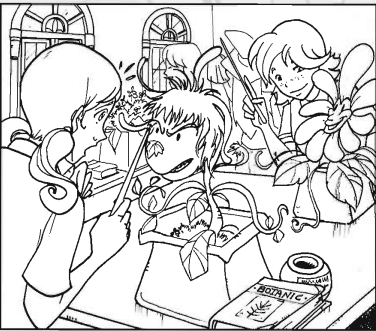
I don't know if the flowers are naturally that creepy or if somebody turned a bunch of humans into plants.
Chapter 2
The next six chapters go over character creation and the parts of Channel M's original “Drama Dice” or “Drama Diaries” system that concern it. Sadly, the bulk of the horrible setting stuff is in the back of the book after this and the other mechanics stuff. The writing in the mechanics chapters also has a tendency to skip around and sometimes goes over things that should be in earlier chapters in later ones.
The fluff at the beginning of the chapter is about Lillian and how her dead grandmother told her about her family's history when she was 7 years old. It's inoffensive and nobody gets turned into anything. Its accompanying picture is one of the first of many with the worst “competent” art style in the book.
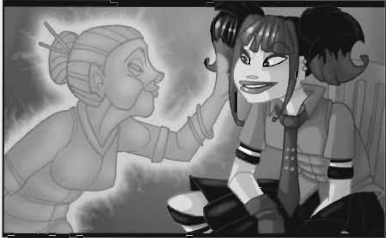
I hate this art style. Everyone has the same muppety looking face. And in this case, the top of Lillian's grandmother's face looks like a mask.
A standard starting character in WGA is an 11 to 13 year old witch who has had a few years of magical schooling. There is an optional rule set at the end of Chapter 4 that provides tweaks for starting characters that are as young as 6 and as old as 18. (“Younger Witches are not as powerful but have their own charm.”)
Characters have 6 basic Attributes: Body , Mind , Senses (perception), Will (mental defense and ability to focus), Social (“force of personality”), and Magic . Each Attribute is assigned a die size based on how good it is, ranging from “D0+1” (or just the number 1, "Insignificant") to D20 ("Cosmic"). A D6 is considered average. There are also 8 levels of D12 for Attributes that are stupid powerful but not quite Cosmic. Here's the chart:
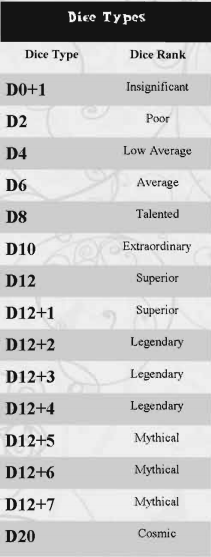
Along with the 6 Basic Attributes are 4 Secondary Attributes that are determined by the values of the Basic ones:
Life Points – HP. The max value of the Body die multiplied by 2.
Reflex - Physical Defense. You need to roll higher than this number to hit and damage someone with physical attacks. The max value of the Body die + 3.
Resist Magic - Magical Defense. Casting a spell on someone? You got to roll higher than this value. The max value of the Magic die + 3.
Zap – MP. Casting a spell always costs 1 point of Zap. Otherkin also use it to power their own special abilities. The max value of the Magic die multiplied by 2.
After this, the book goes over the basics of contested and difficulty rolls. During difficulty rolls, the GM assigns a rating based on a task's difficulty and the player rolls the appropriate attribute die and adds the number of ranks she has in the particular skill involved to the result. (For example, you got to perform some crazy circus routine and you haven't turned your instructor into a mime for annoying you yet. You have a D8 Body Attribute and Rank 4 Acrobatics. So you add 4 to the roll result for a maximum result of 12.) For contested rolls, it's against the results of two different characters. Simple stuff. The book provides a sample ranking chart for difficulty rolls. Though they don't give one for contested rolls until Chapter 8, and don't mention what to do in case of a tie until then. (Meeting the difficulty rank succeeds and the character with the highest attribute die size wins a tie.)
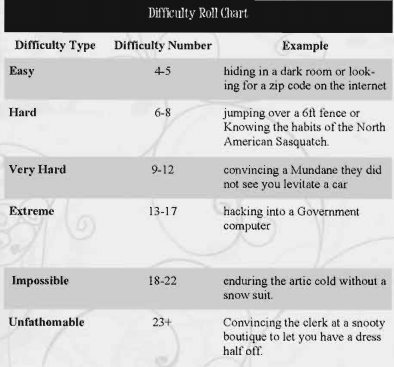
I'm surprised that they didn't just go with the “Lucinda Method” for dealing with that last example: Turn the clerk, security guards, and anyone else who stops you into something harmless, grab the dress, and teleport out of the store.
Die sizes are determined by a character's class or "clique". Cliques represent either a character's background in terms of their exposure to magic before attending a proper magic school or their views towards magic in general. Each of the 5 cliques has a set die size for their Magic Attribute (which is always a D8, except for Sorceresses who have D10s) and a pool of 5 other dice that the player can assign to the other Attributes as they see fit. (The pool is usually a D4, 2 D6s, and 2 D8s. Sorceresses have 2 D4s, 2 D6s, and a D8. Outsiders have 3 D6s and 2 D8s.) The only way to have an attribute at a lower or higher die size than what is listed for a clique is to take certain Heritages, which are explained in another chapter. The clique also determines the character's available pools of points that they can devote to skill ranks and magic type ranks, as well as some miscellaneous bonuses. (The Harry Potter tweak replaces the cliques with stat templates based on the four Hogwarts houses.) The cliques are:
Gothique (sic) - Goths, or as the book describes them, "witches who embrace the more cliche aspects of magic. She doesn't so much follow the real culture of the magical world but rather recreates what popular culture says the magical world is like." You'd think that that would include people who act like fluffy bunny wiccans or Harry Potter cosplayers. But nope. Everyone in this clique is a goth. The free rank in either Curses or Necromancy says so. If you couldn't guess by her clothes, Lillian belongs to this clique.
Insider - Someone who is familiar with both the mundane and magical world and spends time in both. They get bonuses in either the Mysticism, Focus, or Magical Etiquette skills along with 1 free mundane skill. Amber and Monica are part of this clique.
Outsider - A mundane that just discovered the magical world. They start out with less magic ranks (7 vs 8) and only get 2 free mundane skills at rank 1 for their bonuses. Rosa belongs to this clique.
Rustics - Country folk who are in tune with nature and may come from a tribal setting. They get a free magic rank in either Divination or Elementalism. The girl in the portrait for this one looks like she's high.
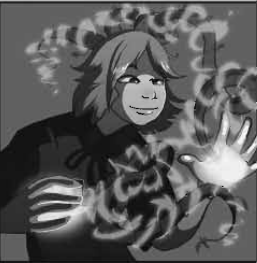
Sorceress - The opposite of an Outsider, someone who has spent all of their time in the magical world. They get a free magic rank in either Alteration or Conjuration. Princess Mary Sue is a part of this clique.
So, people who haven't been exposed to magic, were always exposed to it, were exposed to it half the time... people from the country... and goths. They didn't really think these through long enough.
The last bit of the Cliques chapter is in-character examples of what the different die sizes for the different Attributes could represent in a character's background. For example: Body D4 = "The character was a sickly child or parents thought physical activity was not a priority." and Body D8 = "The character worked hard at her hip-hop dance classes. Her grandfather taught her martial arts since she was 4." Magic die sizes correspond to how imaginative a character is and whether or not she “conforms to the norm”. My "favorite" description is Mind D4, which suggests that a character was raised by her werewolf relatives. (Yes, it is possible to be part werewolf in this game.) The fluff never outright states that shapeshifters are stupid, and going by what I've read, they basically act like you would expect a werewolf to act: They live in packs, they prefer rural areas to cities, and they don't trust people outside of their group. But then, they didn't put much thought into the otherkin races to begin with.
Up Next: Skills
Skills
Original SA post
Witch Girls Adventures: Part 3: Skills
Chapter 3 's fluff is a story about Amber and Monica being hunted by a group of witch hunters packing tranquilizer guns and devices that can detect magic. One of the hunters is wearing a colonial puritan hat.
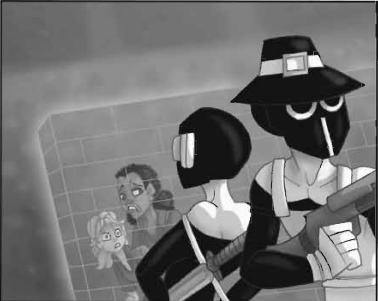
See, it's a reference to the Salem Witch Trials of the late 1600s and ahahaha this game.

The tranqus that they've both been shot with still allow them to move around, but they're too groggy and unfocused to use their magic. (Why didn't just splurge for something strong enough to knock them out completely? I'm pretty sure that the answer has something to do with mundanes being stupider than witches.) Amber decides to pretend that the darts didn't work and openly threaten the hunters with a fireball spell, hoping that they will believe her.
How did they get into this mess? They left school to go try to find a missing 6 year old witch. Amber is worried because if they don't get back by midnight, their day pass will no longer be good and they will get in trouble for being off school grounds without permission. There is no mention of the adults making any attempts to find the missing student or even knowing about it. But after the fluff, the book mentions that witches are naturally more brilliant, talented, and knowledgeable than mundane children their age. So they should be good because they won't get killed like a mundane child would.
So, skills...
There are two types of skills: Mundane and Magical. Each type has its own separate set of starting skill points or ranks, the amount of which is determined by the character's clique. (Gothiques and Insiders have 10 mundane and 10 magical. Outsiders have 12/8. Rustics have 8/8. Soceresses have 8/12.) If a character has any free skill ranks due to her clique, those are chosen/applied first. Skills can have a maximum of 10 ranks. Starting characters can have no more than a 6 in any one skill. (The book says that 6 ranks in a skill costs 4 points. That's incorrect. It's 1 for 1.) If a character ever has to make a roll for a skill that she has no ranks in, there is a -1 penalty to the roll result.
Here is a chart illustrating the amount of training each skill rank represents:
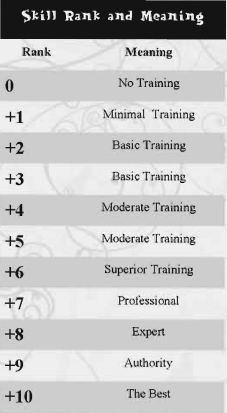
Before the skills list is another rundown of how difficulty rolls, which are called “non-contested rolls” here, and contested rolls work. (The book also mentions there being a difficulty rank chart in Chapter 8. It's not there. It's back in Chapter 2.) The only new information is that some skills have a resist attribute or skill associated with them that are used for contested rolls.
Every skill has a basic attribute that it is associated with, as shown on the lists, that is used to make rolls with it. (Going back to my example from the last post, an Acrobatics roll will always use the Body die.) Some skills also give the character a one-time bonus for having ranks in them.
Here are the skill lists. I would just put the two lists up and move on, but the skill names themselves are kind of vague and the book takes this opportunity to go over rules for different things. Also, there's a bit of overlap between skills where two skills can be used to perform one ability.
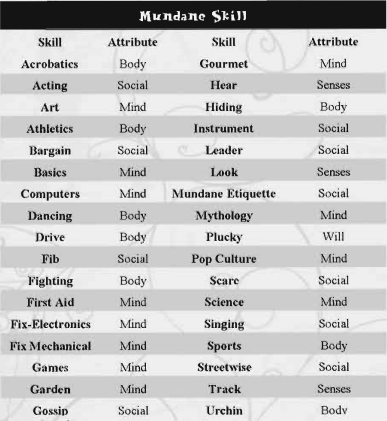
Acrobatics : Gymnastics or situations where balance is needed (e.g. walking on a rope). Bonus: +1 to Reflex
Acting : General knowledge of acting and various forms of theater, as well as faking emotions and lying.
Art : Knowledge of art and ability to create it. The skill requires the player to pick one type of art to specialize in. It doesn't mention whether or not you can take this several times for different types of art.
Athletics : Jumping, running, lifting, etc. Bonus : +1 to life points.
Bargain : Get things for cheap, determine the quality of items, and sales techniques. Bonus: +3 allowance to buy starting equipment with.
Basics : Advanced reading, writing, and math skills.
Computer : Anything to do with computers and the internet be it research, installing programs, making websites, or fixing computers.
Dancing : Doesn't require a specialty like the Art skill does. Bonus: +1 to Reflex
Driving : Car-driving. Also applies to motorcycles and electric scooters, which, as you'll see later, are really big with witches for some reason. This skill doesn't require the character to have a driver's license. So if you want to make an 11 year old girl who can work as a stunt driver, the rules allow it.
Fib : Lying, which can also be done with the Acting skill so there's no point in having ranks in this.
Fighting : Combat ability in all of its forms, unarmed or armed, trained or not. Reflex is used to resist it per the combat rules that are gone over later.
First Aid : Minor first aid. A successful difficulty roll with this skill heals 1 life point of damage with the difficulty representing the severity of the wound.
Fix-Electronics : Repair mundane electronics. May or may not also apply to fixing computers.
Fix-Mechanical : Repair magical devices.
Games : Gaming tactics, be it chess strategies or how to screw people over in Monopoly .
Garden : Growing and taking care of plants.
Gossip : Gathering info on other people. Resisted with Will.
Gourmet : Cooking ability and knowledge of area specific cuisine.
Hear : How acute the character's hearing is. I don't really get why this is a separate skill.
Hiding : Stealth. Resisted with Hear or Look.
Instrument : General knowledge of and ability to play music. Doesn't require a specific specialty if the character plays an instrument.
Leader : Leadership skills. Bonus : +1 to all rolls during combat if all the character is doing is telling others what to do.
Look : Seeing shit.
Mundane Etiquette : Knowledge of foreign customs and cultures.
Mythology : General knowledge of myths, other supernatural beings, and magical nonsense.
Plucky : Courage. Bonus : +2 to Resist Magic when faced with a spell that the character is scared of. Really easy to game since there's no rules for picking which spells a character is scared of or an indication that they need to specify this during creation.
Pop Culture : Knowledge of what's in and other tabloid fodder.
Scare : Frighten people. Resisted with Will. If the defending character fails, they have a -1 penalty to all of their rolls for an unspecified amount of time.
Science : What do you think?

Singing : Singing ability and knowledge of singers and songs. I don't know why this and Instrument are separate skills.
Sports : General knowledge of and the ability to play team sports. Again, doesn't require a specialty. Bonus: +1 to Life Points.
Streetwise : Knowledge of the mundane and magical underworld.
Track : Knowledge of navigating in the wilderness and finding people in it. Resisted with Tracking or Hide.
Urchin : Larceny and getting out of bonds. Resisted with Mind. Bonus : +1 rank to either Hide or Streetwise. This should be a Talent instead, in my opinion.
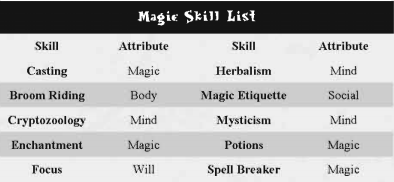
Yes, the magical skills pool is much smaller and that is how this game makes sure that your character is at least competent in magic.
Broom Riding: Self-explanatory. Bonus : +1 Reflex when on a broom.
Casting : Knowledge of spells and how to cast them. The basic dice pool for casting any spell in the game is the Magic die + this. If there's one skill you want to dump a lot of points in, this is it.
Cryptozoology : Knowledge of magical beasts.
 Bonus
+1 to Social rolls when dealing with monsters.
Bonus
+1 to Social rolls when dealing with monsters.
Enchantment : Knowledge of and ability to make, analyze, and repair magical devices; makes the Fix-Mechanical skill useless. The blurb also lays out rules for what to do when a magical device is found: Make a Hard difficulty roll to figure out what it does, then make another roll using the difficulty required to make the device to use it. The second roll has to be done for the first 10 times the item is used.
After that, it goes into the rules for creating and repairing said devices. Every item on the equipment list in a later chapter is given a difficulty. The difficulty corresponds to how much time is needed to make it, starting with 12 hours for Easy items and doubling with each category (so it's 24 hours (a day) for Hard items). The GM has to determine what the cost of materials are, but the book suggests that it be half of the listed price.
Fixing an item requires a difficulty roll with the difficulty set at one less than what is listed for the item. (So when repairing a Hard item, it is an Easy roll instead. Easy items are Easy to repair.) The time needed to repair it is suggested to be a quarter of how long it would take to make it at the most, but that is also left up to the GM to decide.
Focus : “Inner reflection” and the ability to meditate. Meditating allows a character to forgo having to sleep and increases the rate at which Zap points are recovered. A Focus roll is always a Hard difficulty roll and requires a quiet and calm place. A successful roll allows characters to recover 1 Zap a minute and an hour of meditation is considered 2 hours of sleep. Of course, people reading this book cover to cover won't know how beneficial that is yet because recovering Zap isn't talked about until Chapter 5.
Herbalism : Knowledge of magical plants and their medicinal uses. Bonus : If a character has ranks in this skill and First Aid, they can heal 2 points of damage per roll instead of 1.
Magical Etiquette : Knowledge of magical customs and traditions, as well as the laws of the witch community.
Mysticism : Knowledge of the history of the magical world and of the various spells and spell types and artifacts. (Yet another skill with some overlap.) This skill can be used to identify spells as they are being cast and by the evidence it leaves behind after it's been cast.
Potion : Potion-making, which uses the same mechanics as making other magical items.
Spell Breaker : Undoing spells. Doing so is a contested roll against the result of the Casting roll that was used to cast the spell.
Up Next: Talents and Heritages
Traits and Heritages
Original SA post
Witch Girls Adventures: Part 4: Talents and Heritages
Chapter 4
The title picture for this chapter is what looks like Lillian listening to her iPod in the fiery pits of Hell while skeletons dance behind her. I only mention it because I don't know what to make of it.
In the fluff, Monica is preparing for a test in one sentence, then in another a report on Cyber-spirits, which live inside computers and the internet. She confides in a little cyber fairy that her teacher, Ms. Scratch, doesn't believe that cyber-spirits are “proper magical folk” because they live inside something us filthy mundane scum came up with. Monica also doesn't fit her idea of what a witch should be and is looking for any excuse to fail her.
Pretending to go to a better school with better teachers indeed...
This chapter covers Talents and Heritages, which are collectively referred to as "Traits". Talents give minor bonuses and generally define a character's personality, interests, and... well, talents. Starting characters have 2 Talents and can gain more with the weird EXP system that is explained later.
Here, have a chart:
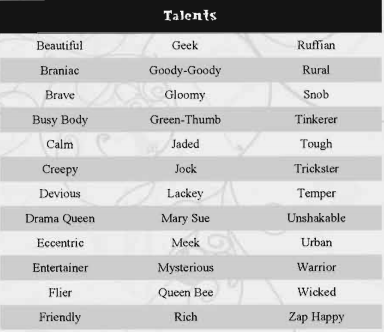
Beautiful : The blurb mentions that all witches are physically beautiful and are better looking than our filthy mundane actresses and models. This talent is for the really pretty ones. +1 modifier to Social rolls. (The book notates this on sheets as D[X] + 1.)
Brainiac : Witches are also much more smarter than us idiot mortals. This is for the stupidly smart ones. +1 to Mind rolls.
Brave : Also applies to characters who are “too naive” to realize they're in danger. (Remember: There is no such thing as a dumb witch.) +2 to rolls to not be scared of something and +2 to Resist Magic against fear creating spells... of which there are none.
Busy Body : +1 to Senses rolls
Calm : +2 to mundane skill rolls where being calm helps.
Creepy : +1 to Scare rolls “and to rolls when being scary”
Devious : +1 to rolls for controlling and manipulating others, including with spells.
Drama Queen : +1 to rolls when they're the center of attention.
Eccentric : You too can be Luna Lovegood! +1 to rolls to defend or while being true to the character's weird ass belief, which has to be specified when this talent is taken.
Entertainer : +1 to rolls when performing for and entertaining others.
Flier : +1 to any rolls that involve flying and casting spells that involve flight. (The book says “any Flying skill”, but there's really only one.) +1 to Reflex when flying.
Friendly : When not performing another action, the character can inspire someone and give them a +1 modifier to their next roll.
Geek : +1 to rolls associated with geek things, “like computers or science”.
Goody-Goody : +1 to rolls to use magic to be nice “or annoyingly sweet” to others.
Gloomy :
 “can spend an action on a target person in close proximity with -1 to a roll”. I have no damn clue what that's supposed to mean.
“can spend an action on a target person in close proximity with -1 to a roll”. I have no damn clue what that's supposed to mean.
Green Thumb : +1 to Garden and Herbalism rolls. +1 to First Aid if using medicinal plants.
Jaded : +1 to rolls already done during the game.
Jock : +1 to Body rolls.
Lackey : +1 to rolls when following instructions from someone.
Mary Sue : Yes, Harris is aware of the term. In fact, he pretty much admits that all characters in WGA are Mary Sues.
Malcolm Harris on the WGA Facebook page posted:
Lastly, another reason we star characters were we do is the “Slumber party situation”. With a lot of Stars you get one chance to really interest. With Witch girls it could be at a birthday party or slumber party. You want to give them cool Pre Gens they can like or allow them to build the character they want to play even if it’s a totally “ Mary sue” concept they have in the back of their head.
The “Mary Sue” gets a bad rep in writing, but in RPG’s almost everyone is playing one, has played one will play one. And the reason is as we stated before, everyone wants to be a hero and for most that perfect powerful character is just that especially among young players.
If you have a good system and good players, you can play a high level game and not necessarily have all of the PCs be Mary Sues. It's all a matter of balance. Hell, you can probably do it with this game too even though the entire witch community is made out to be a race of Mary Sues.
Anyway, I guess this talent is for the sueiest of them all. No, Lucinda does not have this on her sheet. +1 to rolls that make them stand out.
(By the way, that's the same Facebook post where I found that horrible vaginal goat head picture.)
Meek : +1 to all mundane skill rolls when alone and not being watched.
Mysterious : +1 to rolls involving keeping secrets, stealth, and “just being spooky”.
Queen Bee : +1 to rolls when a leader or surrounded by followers.
Rich : Common among witches, especially ones with magical relatives. Has an allowance rating of 6.
Ruffian : Troublemaker/criminal. +1 to rolls “being street-smart or roguish” and performing crimes.
Rural : +1 to rolls in rural areas.
Snob : Witches are, in general, snobbier than mundanes because “they actually have proof they are superior”. +1 to rolls dealing with high society and just being a douche to others.
Temper : +1 to punish people that annoy her. A Hard difficulty Will roll is required whenever the character is insulted to keep her from throwing a hissy fit.
Tinkerer : +1 rolls to build and repair things. The time required to make items is also halved.
Tough : +2 to Life Points
Trickster : +1 to rolls when playing pranks on people.
Unshakable : +1 to Will rolls
Urban : +1 to rolls while in a city.
Warrior : +1 to damage for unarmed attacks. +1 to Reflex during combat.
Wicked : The character is an asshole. (“Okay, that sounds like the average witch, I know”) +1 to cast harmful spells, cannot have the Goody-Goody talent.
Zap Happy : +1 to spell casting outside of combat.
Heritages deal with the character's background and have both Advantages (usually one or more bonuses) and Disadvantages (one or more penalties). All characters have 1 Heritage and cannot gain another.
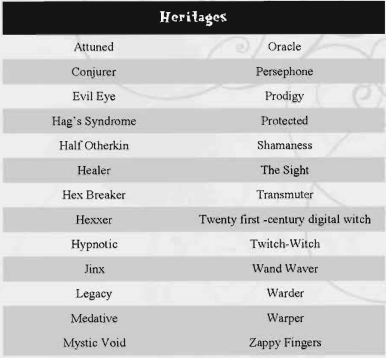
Attuned [to magic] : Advantages: +5 Zap, +1 Resist Magic, and the Magic Type Rank (MTR) for required procedures (whether or not you need a wand, an incantation, or a gesture) needed to cast spells is treated as a rank higher. Usually, it is solely based on how many ranks you have in a magic type. Disadvantages : -2 Life points, -2 Reflex.
Conjurer : Advantages : Another MTR bonus (+1), this time for the size of items that are created using Conjuration spells. 1 free rank in Conjuration and +1 to casting rolls for Conjuration spells. Disadvantages: -2 to casting rolls for every other spell type, any living thing that they conjure up will not show favoritism toward them, which can be avoided by simply not conjuring up predator animals.
Evil Eye : The character's eyes glow and they have to wear sunglasses to hide it, lest they end up on reality TV, which, according to the book, is a worse fate than being burned at the stake. Advantages: +1 to Senses rolls, Character never has to use a gesture, incantation, or wand because they can shoot rainbow beams of magic out of their eyes . Yes, this heritage turns the character into Cyclops from X-Men , only without those pesky control issues that he has. Disadvantages: Character recovers Zap at half the normal rate.
Hag's Syndrome : The character looks like the Wicked Witch of the West: green skin, black hair, and red eyes. This manifests the same time that her powers do. Advantages: +1 to Casting, Potions, and Enchantment rolls. Anyone who tries to undo their spells suffers a -2 penalty. Disadvantages: -2 to all Social rolls. Any spells designed to alter their appearance always fails. Water makes their skin melt, causing 1 Life point of damage for every minute they are exposed to it. They are also required by witch law to hide their appearance from mundanes. Though considering how loophole happy the witch community is, that probably doesn't mean much.
Half-Otherkin : The character's father or someone in their immediate family is an otherkin. This heritage is divided into 4 sub ones for each of the types of otherkin, each with their own sets of advantages and disadvantages and physical character traits. You can only pick one. (Note that otherkin have their own sets of heritages, but those have no bearing on what the PC gets from this heritage.)
Fae : Taller than most and thin, pointed ears, big expressive anime eyes. Advantages: Can spend 1 Zap to give themselves a more human appearance. “For up to one hour, they are also extremely charismatic and attractive”. I'm not sure if that only applies to changing their appearance or if it can be activated at any time, but either way, it just a +1 to Social rolls. 1 free rank in Illusion spells. Disadvantages: They're weak to iron and steel. Iron and steel weapons do double damage to them in combat, they can't use magic if their hands are bound in either one, and their magic will not work on items made from them.
Immortal: Like I said before, an Immortal is basically a male witch, except a bit more focused on physical prowess and doesn't get a hard-on by screwing defenseless mortals over. Think Hercules or Beowulf and you've basically got a good idea of what these guys are all about. Taller than most and muscular. Advantages: Body die is increased by 1 size. 2x speed on foot. Ignores 1 point of damage every time she's injured. Disadvantages: -2 to Resist Magic. Social die is decreased by 1 size (because “her large size makes her socially awkward”).
Werewolf: Bristly hair, pointed ears, and small fangs. Advantages: Senses die is increased by 1 size. Can spend 1 Zap to turn into a wolf for an hour. +1 to Body rolls. Disadvantages: Will die is decreased by 1 type. Silver weapons do double damage to them. They turn into wolves during the full moon and stay that way until the moon sets. (They don't lose control and go on a rampage.)
Vampire: Pale skin, red eyes, small fangs, don't have to drink blood. Advantages: +2 to all rolls performed at night. Ignores 1 point of damage when injured. Can grow bat wings and fly up to 50 MPH. Disadvantages: -1 to all rolls during the day. -2 to Reflex rolls during the day. Direct sunlight does 5 life points of damage every hour they are exposed to it. They can't come into a house or someone's room without being invited.
Healer : Advantages: +1 to casting rolls for Healing spells. Undead creatures (except for half-vampire witches) have a -1 penalty for rolls when around the character and -2 for rolls against them. Disadvantages : -2 to all other casting rolls. Harmful spells have 2 Zap added to their cost.
Hex Breaker : Advantages: 2 free ranks in the Spell Breaker skill. +2 to resist Curse spells. Disadvantages: -1 to all starting magic types after they have been spent. Any helpful spells cast on them are treated as contested rolls.
Hexer : 1 free rank in Curse spells. Curse spells last 1 rank longer in duration than they normally would. They can spend 1 Zap to give one target other than themselves a +1 or -1 modifier to all of their rolls for a scene. Disadvantages : -2 to all non-Curse casting rolls. “-1 to all rolls in situations where they really need to be successful”.
Hypnotic : Advantages: 1 free rank in Mentalism. +1 to Casting rolls for Mentalism spells. +1 to Will rolls. Disadvantages: -2 to casting rolls for non-Mentalism spells. -1 to Body rolls.
Jinx : Advantages: Ignores 1 point of damage when injured. Can spend up to 10 Zap to ignore up to 10 points of damage if it was caused by them being a jinx. Any nearby allies gain a +1 to all of their rolls. Disadvantages: -1 to all rolls. If they fail a roll, something “comical” will happen. -1 to Social rolls. -1 to rolls requiring them to be graceful or agile. It doesn't say whether or not the penalties stack.
Legacy : The character is the Chosen One or is related in some way to a famous witch. Advantages: +2 to rolls used to keep the character alive. +2 to Social rolls when dealing with people in the magical community. Disadvantages: The character has an enemy NPC “of equal or greater power” that is out to get them. -1 to rolls “dealing with her Legacy”.
Mediative : Common in Eastern witches. Advantages: Will die is increased by 1. 1 free rank in the Focus skill. Can restore life points during meditation at the same rate that Zap is restored. Disadvantages: -1 to all starting magic ranks after they have been spent. Can only restore life points and Zap through meditation.
Mystic Void : The character's presence negates magic. Advantages: +2 to Resist Magic. Anyone casting a spell around her does so at a -1 penalty. Can spend 1 Zap to remove a Zap point from another character or item. (They don't gain it themselves.) Disadvantages: -1 to all Casting, Potion, and Enchantment rolls. Other characters gain +2 to their Resist Magic against the character's spells.
Oracle : +2 to any rolls requiring knowledge of magical people or the magical world. Mind die is increased by 1. Disadvantages: Body die is lowered by 1. -1 to rolls about learning physical or social matters.
Persephone : The gothiest of goths. Don't necessarily have to be part of the Gothique clique. Advantages: 1 free rank in Necromany and +1 to Necromancy casting rolls. Capable of seeing, hearing, and physically interacting with ghosts and spirits. Disadvantages: -2 to all other casting rolls. -1 to all Social rolls. Animals other than her pet react negatively to her.
Prodigy : Characters whose powers manifested at a very young age or is just really really good at magic. Advantages: Magic die is increased by 1. 4 free ranks to spend on magical skills. Disadvantages: Body die is lowered by 1. Rank pool for mundane skills is decreased by 4. Note that Outsiders can have this heritage.
Protected : The character has wards cast on her by a family member. Advantages: +1 to Magic Resist. +1 to Reflex. Ignores 1 point of damage from attacks. Disadvantages: -1 to rolls “that an overprotective parent or family member might find dangerous”. Performing dangerous acts will also inform the person that put the ward on them.
Shamaness : Advantages: 1 free rank in Elementalism. +1 to Social rolls for dealing with animals and monsters that live in the wilderness. Can talk to animals and plants without having to cast a spell. Disadvantages: Yes, you guessed it, -2 to all other casting rolls. -1 to Social rolls for dealing with people.
The Sight: Advantages: +1 Reflex. 1 free rank in Divination. GM also has the option to give the character glimpses of the future at random. Disadvantages: -1 to Senses rolls. -2 to non-Divination casting rolls.
Transmuter: Want to create spank bait for Malcolm Harris? Take this heritage. “Easily the last witch you would ever want to cross. She is the bane of mundane and non-mundane alike.” Oddly enough, Lucinda doesn't have this on her sheet. Advantages: 1 free rank in Alteration and +1 to Alteration casting rolls. Spell duration and size modifiers are treated as 1 rank higher. Disadvantages: -2 to all other casting rolls. -1 range rank to non-Alteration spells.
Twenty First Century Digital Witch : Abbreviated to 21CDW. Advantages: 1 free rank in Cybermancy. 1 free rank in the Computers skill. (Nope, no bonus to casting rolls.) They can speak a computer language called “3L33T” that only Cybermancy nuts know. Disadvantages: Character uses a computer to cast all spells. -2 to non Cybermancy casting rolls. -1 to casting rolls done without the computer. Those two sound like they do stack.
Twitch Witch: Character has a signature “twitch” gesture that she uses to cast spells. Think Samantha from Bewitched . Examples given are nose-twitching, blinking, and tugging on your ear ala Carol Burnett. Advantages: Character uses the twitch instead of a wand when it's called for. All spell costs are reduced by 1, but it can't be reduced to 0. Disadvantages: -1 to all casting rolls. Wands do not work when wielded by the character. Cannot cast spells if the twitch can't be performed.
Wand Weaver: +1 to casting rolls when using a wand. Range and duration of spells is considered 1 rank higher when a wand is used. Character gets 20 free allowance points to build a custom wand with at creation. Disadvantages: -1 to casting rolls without a wand. Spells cast without a wand cost 1 Zap, which I think is supposed to say that it costs 1 Zap extra. Character takes 5 damage if her wand is broken.
Warder: Advantages: 1 free rank in Protection spells. Can spend 1 Zap to ignore 1 point of damage or add 1 point to her Resist Magic, can only be done once per attack. Disadvantages: -2 to all other casting rolls. Any Protection spells cast on the character are only half effective.
Warper: Advantages: “1 free rank in Time and Space magic for free”. +1 to casting rolls for T&S spells. +1 to rolls to find people, places, and things. Disadvantages: -2 to all other casting rolls. Never show up on time for anything, they are always either early or late.
Zappy Fingers: Character likes to blow shit up. Advantages: 1 free rank in Offensive spells. +2 to casting rolls for Offensive spells. +2 modifier to damage others take from the character's spells. Disadvantage: -2 to other casting rolls. Non-Offensive spells cost 1 Zap extra.
God, my fingers hurt... The chapter ends with the optional rules for playing younger or older characters that I mentioned earlier. They mostly involve raising and lowering the characters' Body and Will dies and adding or subtracting from the pool of skill and magic ranks, as well as the allowance rank that they start out at.
Now, some of you are probably wondering where all of the horrible pictures of witches being assholes that I talked about in my first post are. Well, Harris managed to rein himself in until now. Chapter 4 is where they start showing up.
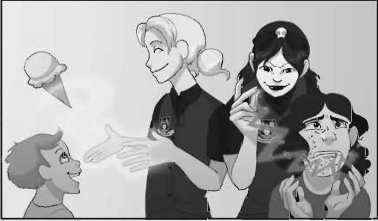
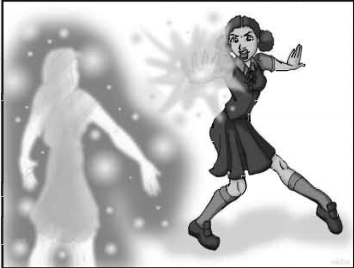
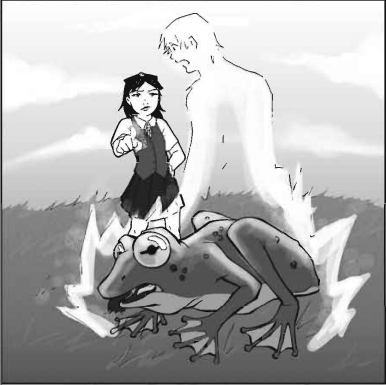
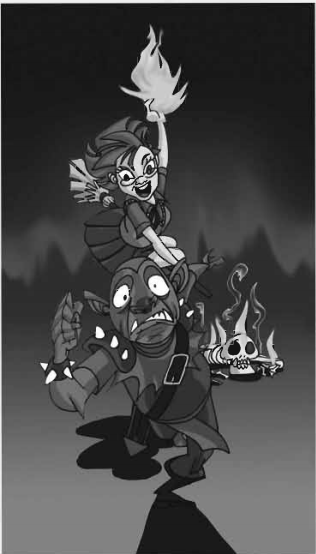
And if that's not enough pictures of Princess Mary Sue for you, the next chapter's got even more of them.
Up Next: Magic
Magic
Original SA postI love it.


Witch Girls Adventures: Part 5: Magic
Chapter 5. Fluff. Two Willow-Mistt students mock Lucinda for her hysterics, such as calling them “peasants”. She gloats about being nothing like all other princesses who sing and talk to animals and fart rainbows before she turns them into a snake and a mouse. Then she takes the two off to a quiet area to see which one of them is faster. It is the longest chapter opener in the book, takes up 3/4th of the first page, and has two pictures devoted to it instead of just one. Yeah, totally a coincidence, I'm sure...
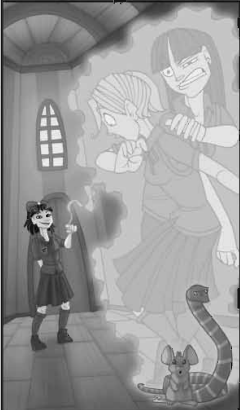
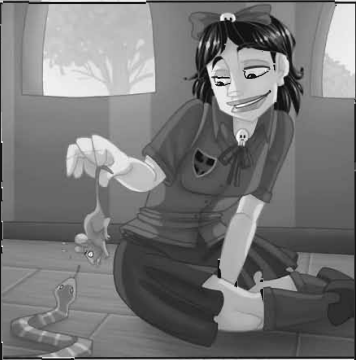
The chapter cover is also of Lucinda.
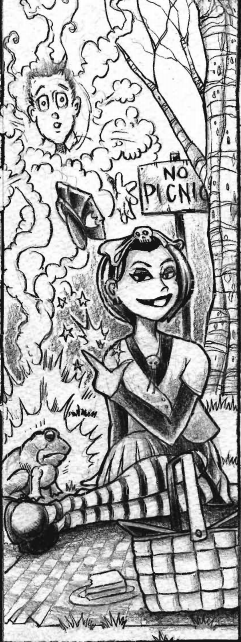
Magic is described as “the energy that connects all things”. Everyone who is not a mundane can manipulate it in some way, but witches are the best at it. Casting spells is a matter of forming a connection to something or someone and changing the connections that they have with other things. (Eye contact is not necessary, unlike what the vagina goat picture states.) That's apparently the reason why there is always a physical component to spells (e.g. sparks, colored beams, whatever) unless the witch attempts to suppress them, but most don't. I have no idea why forming a connection = sparkles, but I'm starting to accept the fact that Harris is a terrible writer and learning to overlook it.
Witch law states that once a witch's powers manifest for the first time, they are required to begin some form of formal study in how to use their powers. This usually happens at around ages 6 and 7 and occurs when they cast a spell accidentally while experiencing a strong emotion. This is known as The Becoming. (As a bit of an aside, one of the supplement books mentions a young witch in India (named Kali
 ) who is homeschooling herself because her mundane parents won't let her go to a magic school. I find it highly odd that the governing body of the witch community hasn't killed or turned them into animals and just dragged her ass off to a school themselves.)
) who is homeschooling herself because her mundane parents won't let her go to a magic school. I find it highly odd that the governing body of the witch community hasn't killed or turned them into animals and just dragged her ass off to a school themselves.)
A character's knowledge of a type of magic is represented by how many ranks they have in it. (Abbreviated as MTR). Ranks can go from 1 to 10 and determines the maximum damage, range, duration, the number of targets that can be affected at one time, and what the character needs to do to cast a spell of that type (whether they need a gesture, incantation, and a wand to perform it, just one or two of those things, or nothing at all). Most cliques have a base pool of 8 ranks to spend on magic at creation. (Outsiders have 7.) Starting ranks are capped at 4 for one type of the character's choice (usually one where they have bonus points in, since the book says you can't spend more than 3 points in any one type) and 3 for all of the others. (The cap isn't changed in the optional rules for older/younger characters.) Each rank has its own set of spells. A spell's cost in Zap to cast is the rank number it falls under. When doing a casting roll, if it is not contested, it is considered an Easy difficulty roll. Some spells also have optional qualities that can be applied to them called “Augmentations”. Adding an augmentation to a spell raises its MTR by 1.
Characters can also pick one spell from their highest ranked type to use as their “signature spell”. Signature spells get a +1 bonus to casting rolls for it and cost 1 Zap less (but can't be reduced to 1).
So what does 3 ranks get you? Spells that can last up to an hour, do up to 10 points of damage, can be cast at a "near" distance and within eye sight, and affects 1 person. Four ranks gets you spells that can last up to a day, do up to 15 points of damage, affects up to 2 things at a time, and can be cast from up to "far away" as long as the witch can see the target and make out its details.
As for the required items...
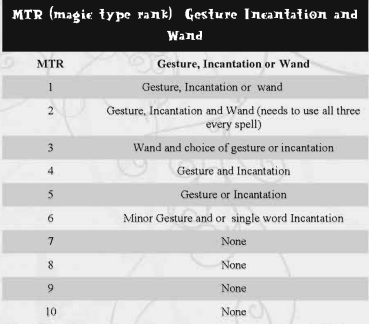
(Hint: Look at ranks 1 and 2.)
I'm starting to suspect that Harris just sent this thing off to the playtesters, proofreaders, and printers the minute he was finished writing it.
The book doesn't explain why a young witch can cast a spell without a wand, gesture, or incantation when they first start manifesting powers but can't afterward. But to be fair, that happens in Harry Potter too and I assume it's like a power surge.
Now the thing I'm sure some of you have been waiting for: What exactly can these little shits do with their powers? Well, the spell lists are short and only give examples up to Rank 6 (with one exception). The GM is the one expected to make up and approve the player's spell ideas. Unfortunately, the book doesn't give a guideline or ruleset for doing this, nor does it really define the general characteristics of spells in each individual rank like nWoD Mage does to help GMs come up with stuff. So you're basically just expected to look at the lists and wing it.
And at the top of the list we have...
Alteration
Turn shit into other shit! The bread and butter of witches in this universe. According to the book, it is one of the oldest types of magic and the one that mundanes are most likely to think off. Gee, I wonder why.
A character's rank in Alteration also determines the size change limits of the spells that they can perform and the size of objects she can affect.
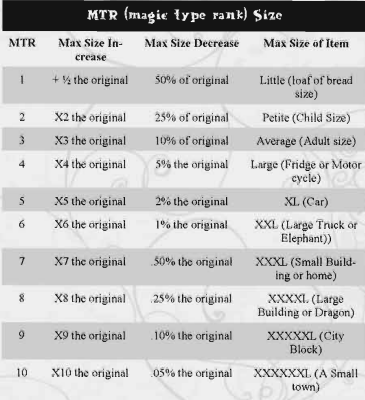
Rank 1: Turn an animal into another animal; disguise everything about themselves except their fingerprints; change an object into something smaller or the same size as its original form; turn a non-living object into a grey goo.
Rank 2: Turn an object into an animal and vice versa (in the later case, they can still think); disguise others; shrink things.
Rank 3: Turn a human or humanoid monster into an animal and vice versa; grow things; increase the attributes of a character or object; merge two living beings or objects together. (“The targets are merged haphazardly with the results almost always being unsettling and far from enjoyable.”)
Rank 4: Divide a target up into smooth pieces (like puzzle pieces); increase the attributes of a target by a higher modifier; turn a human or animal into a monster; turn a human into an object.
Rank 5: Turn a living thing piece by piece into gas; increase all of the attributes of a character or object at the same time; make a clone of anything by dividing it in half.
Rank 6: Teleport a person or animal or themselves into a fictional world (book, TV show, whatever); the former can only leave by “surviving to the end of the story” or if the witch allows it. If you think about it hard enough, I'm sure you can come up with a reason for why this is under Alteration.
Conjuration
Create and summon things. Things created with these spells are always lower in quality than their non-conjured counterparts and living things have less life points. The Size considerations also apply to this type.
Yes, you can conjure money with these spells and can use it to buy things just fine. I'll go into detail why later, but for now I'll just reiterate that witch law loves its loopholes.
Rank 1: Wrap things in gift wrap; create a “tick” smoke; create a pound of “candy, fruit, or pasty”; create a swarm of nonpoisonous insects; create an item of low value made of one material that weighs a pound or less.
Rank 2: Create a non magical item with simple moving parts (examples include a lamp, despite saying a sentence before that electronics don't count); create a 3 course meal for one person, utensils and all; creates a length of rope to tie a target in; destroy a living being or object made with a Conjuration spell.
Rank 3: Create an Imaginary (basically an imaginary friend, only actually alive and better because a magical child thought it up) which gets full health for some reason; create a monster that is equal in rank to the number of ranks the caster has in Conjuration; summon a length of chain and some locks to bind a target; create a normal animal; create non-magical complex electronics and mechanical items; create a stone wall.
Rank 4: Create a 10 x 10 ft metal cage; create a clone of an object or living being; create a guardian (a furry with armor that protects the witch basically); create a stream of metal needles.
Rank 5: Create a clone of a magical item; create a mundane human (that thinks it's real, can have a full life story, and it essentially an unquestioning slave to the witch); furnish a room with mundane items up to a certain combined cost.
Rank 6: Create 2 mundane humans per Conjuration rank that the witch has (so it goes from just 1 at Rank 5 to 12 at Rank 6...); create a full sized house with working utilities.
Curse
Play with the forces of luck and fate for fun and profit.
Rank 1: Give a person warts, moles, or acne; make a person drop whatever s/he holds; give a person the exact opposite of their preferred hairstyle or make them go bald; re-roll a failed roll or allow another character to do so (the latter spell is called “Quick Curse”); make a person speak gibberish.
Rank 2: Give a target a bonus or penalty to rolls based on how many ranks in Curse the witch has; make a magical or electronic device not function properly; make a person suffer a physical transformation whenever they lie (ala Pinocchio , also mentions that witches are known for their honesty (“when you can just blow up people who disagree with you, you never have to lie”)); make two targets feel each others' pain; seal a person's mouth shut.
Rank 3: Make a person's bones brittle and prone to breaking; make a structure collapse in a neat matter (i.e. walls fold in on themselves instead of crumbling); turn an item into a good luck charm; make a voodoo doll of a person and cast spells (Curse, “Mentalist”, or Offensive) on it to affect the person. (“Witches really into this spell spend a lot of time making dolls of family, friends, enemies, and even total strangers... just in case.”)
Rank 4: Reduce a target's allowance rank; give a Reflex bonus to a target; give a target a bonus to resist Curse spells based on the number of ranks the caster has in it; make a living thing feel excruciating pain, causing a -4 penalty to all of their rolls; make clay voodoo dolls that don't require an item from the target and can only have Alteration spells work on it; give a target a bonus on their allowance rank equal to the caster's Curse rank.
Rank 5: Destroy any item so completely that it is unrepairable; instantly and permanently kill someone; enchant a stone so that whoever holds it gets the same resist Curse spells bonus in Rank 4.
Rank 6: Turn someone into vampire, the “icky” kind that are essentially blood thirsty zombies; turn someone into a werewolf, the kind who goes on a murderous rampage on a full moon; instantly and permanently kill someone AND a number of their immediate family members equal to the number of ranks a witch has in Curse.
Cybermancy
Manipulate and take advantage of computers, the internet, and other electronics. Most of the lower ranked spells are for people who are just too damn lazy or too stuck up to use a filthy primitive physical mundane computer, despite specializing in a set of spells that requires an invention of ours to work.
Rank 1: Transfer files from one computer to another; enchant an email so that it casts a spell when the receiver opens it (Fun Fact: Spells are 100 MB per rank in size.); control a computer with your mind; cut off signals to any electronic device (e.g. internet connection, cell service); write a “text message” in the air and have it display on any sort of medium to anyone who the witch knows the phone number of; use a cell phone for free and without data or minute restrictions.
Rank 2: Damage an electronic with an EMP pulse; turn an image or text document into a hologram (Goatse people in 3D!); instantly repair a computer and remove harmful spells from it; create a virus that bricks any device that “can't resist it” by magically scrambling the processes required to run it (and can't be unscrambled without magic); create simple computer programs with your mind.
Rank 3: Create an intelligent computer file that does the witch's bidding; gain a bonus to your computer skill equal to the number of ranks in Cybermancy; travel between computers via the internet; cause an electronic device to explode; protect a computer from both mundane and magical hacking attempts.
Rank 4: Create a clone of yourself; “the witch or a target's mind is connected to the internet for the spell's duration giving them a single Mind, Will or Social based mundane sill at the spells Magic type rank for the spells duration.”; fire a Pong block size of a brick at someone.
Rank 5: Store a living being or object on a computer as a file (erasing the file doesn't kill them); fire pop-up ads at someone and make them repeat the text of it.
Rank 6: The Rank 6 Alteration spell, except it only mentions computer games. A target can only leave if they win or the witch lets them out. So they're pretty much fucked if it's an MMORPG without a main storyline.
Divination
See the future and spy on people. Visions come in vague symbols and not as a clear image.
Rank 1: Allow the caster or a target to know when they're in danger (via a Reflex bonus); create a blue burst over a character's head when they lie; connect oneself or others to the collective unconsciousness (frequently used to cheat on tests); see magic in an area as different colored auras.
Rank 2: Find a person or object; allow others to see magic as colored auras; remotely view/scry someone via a crystal ball or mirror or any other divination medium; protect self or an item from being scryed.
Rank 3: Create a false image for a scryer to see; know the basic powers or magical knowledge of a target; see into the past up to 1 day per number of ranks in Divination.
Rank 4: Cast spells on a target while scrying them; see into the near future up to 1 day per number of ranks in Divination; see into the far past up to 1 year per rank in blah blah.
Rank 5: See into the far future, same rules; see basic information on a target's life up to when the spell was cast.
Rank 6: See into a person's future.
Elementalism
Control of the elements and weather... and also over animals for some reason.
Rank 1: Create a small rain cloud; create a “tick” fog; create a bright light, either an orb or at the tip of a wand; talk to animals and plants.
Rank 2: Give a broom the ability to fly; control a plant's rate of growth; influence the speed and spread rate of a fire; create a burst of sunlight; control the rise and flow of any amount of water within the caster's range; cause vines to appear and wrap around someone.
Rank 3: Create a strong gust of wind; cause or stop an earthquake and create sink holes; move or shape any earth, air, fire, or water within the caster's range; end any sort of inclement weather; restore an area's natural balance or cause it to overtake an urban area.
Rank 4: Start fires; create snow, ice, or frost; give a normal animal or plant special abilities (used to create flying monkeys and talking cats, amongst other things); call down a lightning bolt; make it rain small animals; create a large thunderstorm.
Rank 5: Create a blizzard no matter what temperature it is out; create a drought; create a tornado.
Rank 6: Create a tropical storm or weak nor'easter, which can grow into a hurricane if given the right conditions.
I'll get the rest later.
More Magic
Original SA post
Witch Girls Adventures: More Magic
More magic types and hastily constructed spells!
Healing
Heal and repair things. Tends to work better on magical damage because it's also magic.
Rank 1: Remove and cure poisons both ingested or contaminating an object; “permanently” restore 2 points of health; repair or restore non-electronic objects, including shredded documents; unspoil rotten and moldy food; sanitize and clean a person or object (I guess this is how witches with Hag's Syndrome bathe.).
Rank 2: Cure mental illnesses brought on by magic; cure any disease (Yes, you can make an 11 year old girl capable of getting rid of HIV, Ebola, and every other horrible ailment on the planet,); “permanently” heal 5 points of magical damage.
Rank 3: Heal 10 points of non-magical damage; returned a person or object affected by an Alteration spell to normal (for living beings, the roll result has to meet or exceed the roll result of the original spell); restore an object to working condition; restore a person “to her best physical appearance . (For the duration, she doesn't age or get sick, her skin and hair are perfect, and no matter what she wears, it looks the best it could possibly look.)”
Rank 4: Restore a living being to peak health; regrow lost body parts “within a matter of seconds” permanently; stabilize a person who has been reduced to 0 life points.
Rank 5: Revive anyone who was killed by magic to full health (or, as it says two sentences later, stabilizes them and grants 1 health), provided they've been dead for less than a day and the body is 90% intact and still has its head; damage an undead creature up to as many points as equal to the character's rank in Healing.
Yes, in this game, a spell that cures someone of HIV/AIDS is easier to cast than one that damages (not kills) a damn zombie. Nevermind the fact that there's a Rank 2 Elementalism spell that makes this spell useless if the target is a vampire and a Rank 1 spell coming up later that does exactly the same thing as this one. (I didn't mention it, but that sun spell only has rules for blinding the target. I'm assuming it's meant to do damage to vampires just like any ol' direct beam of sunlight does. But then, I'm applying common sense. Something this game is lacking.)
Rank 6: “Repair anyone who destroyed or consumed while transformed into an object.”
Rank 7: Revive anyone from the dead who was killed by non-magical means. This is listed because Harris wanted “to show how powerful it is, and that it does exist but isn't common.”
Illusion
Create illusions, be they visual, aural, or anything else related to the five senses.
Rank 1: Throw your voice; make a person or thing stink; make a bright flash of light to blind people with; make a person feel itchy or as if she's being tickled.
Rank 2: Remove illusions created by spells; make a sound; make a person feel something that isn't there.
Rank 3: Create a visual illusion; turn yourself or someone else invisible; create a single complete illusion that involves all 5 senses.
Rank 4: “This major illusion is a full sensory illusion. A person can smell it, see it, taste it, hear it, and touch it.” So basically the same spell as the last one; create an illusion that can interact with living beings; create a fake wound that does damage like an actual wound.
Rank 5: Create “an illusionary area”; make yourself or a target or anyone within a 10 foot radius invisible.
Rank 6: Create an illusionary area that feels solid and has creatures who can do damage.
Mentalism
Telepathy, telekinesis, and all that other good stuff.
Rank 1: Give someone a -5 penalty to all rolls; raise or lower a person's Mind die by one type; speak and understand any language; levitate things, also used to make brooms fly.
Rank 2: Make someone forget something other than a spell or skill; make a person love or hate someone or something; read peoples' minds; remove a skill from someone and give it to yourself; put someone to sleep until the spell is lifted by a witch or a certain condition is met (e.g. kissed by a prince).
Rank 3: Take over a person's mind and make them to your bidding; remove multiple memories or erase an entire person's mind or return them.
Rank 4: Alter or give a person new memories; trap a person within their mind and alter it as you see fit; communicate telepathically and share knowledge with up to 10 people per number of ranks in Mentalism.
Rank 5: Control the minds of everyone within range; place a person's mind in an object.
Rank 6: Change or erase the memories of everyone within range.
Necromancy
Death and the dead. The blurb for this also takes the time to mention that there is no such thing as “light” and “dark” magic and that it's the intent of the witch casting the spells that counts. Mind you, the blurb for Healing specifically states that it is Light magic (“The magic of healing is one of pure kindnesses and light.”) and requires a benevolent state of mind to cast.
Rank 1: Appear dead indefinitely; talk to the dead, (limited by the time it's been dead by the number of days equal to the witch's rank in Necromancy); damage an dead creature up to as many points as equal to the character's rank in
 ; “take two dead creatures and animate them as one creature with the best qualities of both creatures. A Witch could for instance sew a dead mouse and fish together, creating a mouse-fish that could breath underwater and burrow.” (Why would you want to do this?)
; “take two dead creatures and animate them as one creature with the best qualities of both creatures. A Witch could for instance sew a dead mouse and fish together, creating a mouse-fish that could breath underwater and burrow.” (Why would you want to do this?)
Rank 2: Summon a ghost; cause a living being to rot; reanimate an animal's corpse as a zombie.
Rank 3: Turn into a spirit and possess a corpse; trap a ghost in an item or confine them to an area; reanimate and control a human corpse.
Rank 4: Control an undead creature (including vampires); suck out a person's soul and store it in an object if the attack kills the person; allow a ghost to interact with the real world.
Rank 5: Turn someone into a ghost; kill a person for a length of time equal to the duration of the spell.
Rank 6: The Rank 6 vampire Curse spell.
Offense
Move and blow shit up.
Rank 1: The Rank 1 Mentalism levitate spell; blind a target (lowers the Senses die by one type, takes a -2 penalty onto Senses rolls, and a -4 penalty to any involving seeing); remove weapons and wands from a target's hands; make a target deaf (does the same thing as the blindness spell).
Rank 2: Freeze a target; make a target experience excruciating pain; fire a red bolt of damaging energy (does “standard damage for its rank” and causes a -1 penalty to the target's next roll).
Rank 3: Create an invisible bond that holds a target in place and damages them; destroy all or part of an object; fire a blast of blue energy that lowers the Body die by one type for each hit.
Rank 4: Send a target flying into the air (this is the “Air Witchcraft” spell mentioned in the 1st chapter); fire a fireball; fire a “screaming” bolt of green energy that puts the target in excruciating pain.
Rank 5: Turn someone into ashes, which instantly kills them; drain a target of Zap (a D6 roll's worth) and give it to yourself; do the previous spell on multiple targets.
Rank 6: Fire off a magical nuclear warhead (“minus the nasty radiation”)! “It can strike an area up to 100ft wide per Offense rank of the caster. The central quarter of the spell's blast radius is completely disintegrated. The middle half is consumed by fire, as per the Dragon Fire spell. The last, outer quarter is hit by a shock wave, doing standard damage for the caster's Offense magic rank.” The caster is immune to the spell.
Protection
Protects a witch from all of the awful things her classmates can do to her. Each spell can only be cast on a person once and the caster's rank in Protection determines the maximum amount of defense points applied with the spell. The numbers for it was pretty much the same as they are for damage, except it starts at 1 and ends at 40 as opposed to starting at 3 and ending at 45.
Rank 1: +1 bonus to Resist Magic; +1 to Body rolls to resist damage; double the health of an inanimate object.
Rank 2: +1 per MTR of Protection to protect against a specific element or creature; create an invisible shield; create a “brain shield” that gives you a +4 bonus to Will rolls and against Mentalism magic; give someone a +5 bonus to their Resist Magic.
Rank 3: Absorb the next spell the caster is hit by and convert it into Zap; make a bigger invisible shield; reverse a spell so that it strikes the caster instead; make an invisible shield that protects against all types of attacks.
Rank 4: Make an even BIGGER shield or barrier; ignore any spells that will move the target.
Rank 5: Make a shield that allows the caster to ignore any mundane attack; make a shield that protects against a certain type of monster; make a barrier that negates the next spell cast at the caster.
Rank 6: Create a stone circle that protects the caster or someone else from everything, including death.
Time and Space
Become a Time Lady! The blurb says that this type requires knowledge of math and abstract thinking about bending space-time to grasp. It also mentions that skilled players can use these spells to screw over the GM and that they should be prepared to “manage it” if necessary.
Rank 1: Make a space or room bigger on the inside than the outside; increase or decrease the space between two points, making travel between them faster or slower; speed up time around the caster (for +5 Reflex).
Rank 2: Age a person forwards or backwards and change their attribute dies to match. Adult witches, “immundanes”, and fae can't be aged past their current age and their child counterparts can't be aged past the prime of their life (which the book defines as being between 25 and 30 years old); increase the speed the caster works at; stop time.
Rank 3: Teleport somewhere; put a shield around yourself or others that keeps people from teleporting near you or them; remove yourself from reality completely and reappear some time later.
Rank 4: Remove someone from reality; increase or decrease the size of a target.
Rank 5: Travel back in time far as the maximum duration for the witch's T&S spells will allow; open a two way gate to another dimension that you have either visited or researched extensively.
Rank 6: There are no Rank 6 spells listed.
And that's it for the list of spells in the core and the end of the chapter. Time for a...
 HORRIBLE PICTURE ROUND-UP
HORRIBLE PICTURE ROUND-UP

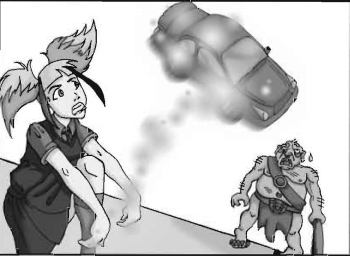
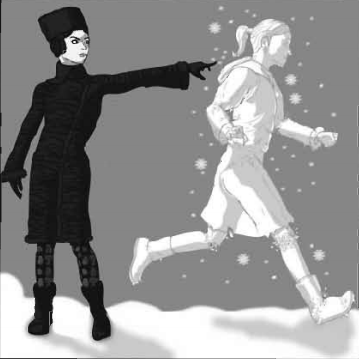
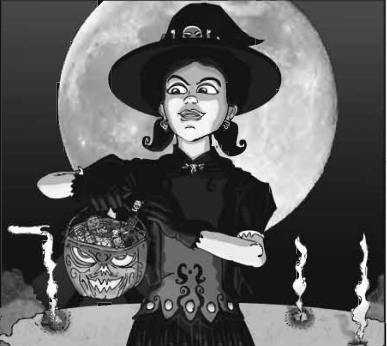
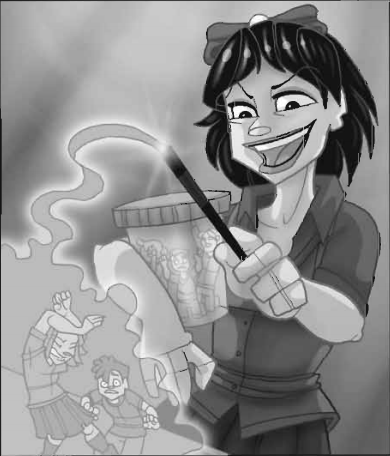
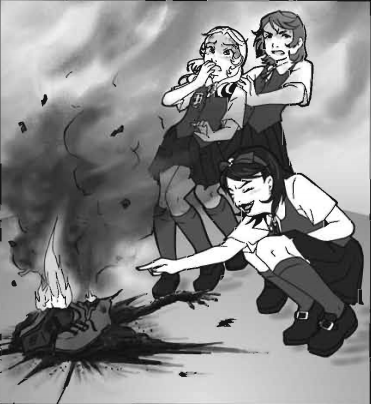
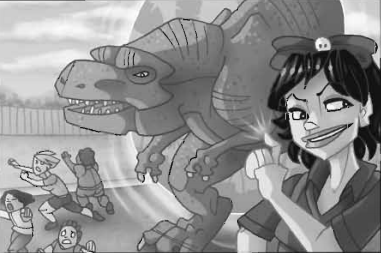
Oh Lucinda, why aren't you in Hell?
Up Next: Equipment
Equipment
Original SA post
Witch Girls Adventures: Equipment
Chapter 6 starts off with Amber going shopping at a magical mall for a gift for Rosa to welcome her to the magical world. She's at a bit of a loss as to what to get her at first. But eventually, she whips out her magic bank card from a magical bank and buys her a broom... as well as a shit ton of stuff for herself. (Lucinda, if you care, gave Rosa a wand, something even the book admits is out-of-character for her.)
Also, Baby Phat sells broom oil. Go figure.
Chapter 6 is mostly an item list and is the reader's first look at how dumb the setting can be. There are a few running themes throughout all of the setting stuff (aside from the transformation shit) and I'm sure some of you have already noticed one: Everything associated with witches is either always better than the stuff our mundane pea brains come up with or perfect in nearly every conceivable way, even when they so obviously aren't in execution.
The chapter starts off by mentioning one of the major Laws of Interaction set by the witch community's governing body, the Witches' World Council (or WWC): “A witch cannot interfere with the mundane world economy.” It goes on to say that, while witches “don't need much”, they need to find a way to make money other than just conjuring it, which is what this law forbides them from doing. So I was wrong about the conjuring thing. But honestly, there's really nothing to stop witches from doing this as long as it doesn't cause hyper inflation, crash the stock market, or cause any other sort of damage on a large scale. It is also possible to use Curse spells to make yourself come into money via luck. And even if the WWC did come down on people for this, you can argue that it contradicts another law set by them. And I imagine such deputes end in someone or a bunch of people getting killed or turned into bugs instead of months long shouting matches and filibusters ending in a vote.
Witches don't have their own currency and use whatever currency is used in their country of origin. Magical banks exist to bridge the gap between mortal banks and the magical world, allowing one to withdraw money for magical purchases and I assume to perform currency exchanges when they're needed. (Hence Amber's magical bank card.) Keeping with the theme of perfection here, I imagine they don't have to deal with overdraft fees, transaction fees, and the like because witches are better than us.
Money and the cost of items are represented by points. The amount of money a character has is represented by their Allowance. The amount of points a character has to buy starting equipment represents their savings, the rank of which also determines how many points of money they get every week in the form of an allowance from their parents. Like so:
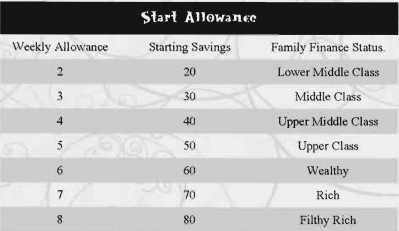
Players all start out at 3/30 and can only raise it via Traits (The Rich talent bumps it up to 6/60.), certain spells, or by “begging their parents”. (A Hard difficulty Social roll that gives you a D4 result's increase. The difficulty of the roll raises each time you do it.)
The items list also doubles as an introduction to Moon Shadow Circle or Moon Shadow Mall or the Moon Shadow Circle Magical Mall (depending on what you're reading), the witch world's premier shopping mall. The list is divided up into sections complete with a blurb for the different stores in the mall that sells those types of items. The book also promises that there will be a more in depth description of the mall in an upcoming supplement book.
Let me talk about WGA supplements for a bit: Not including the comics, there have been 7 supplements advertised or talked about in the various WGA materials, complete with covers and product descriptions and in at least one case, a line in one book telling you to see them for more information on a subject. Out of those 7, only 3 have actually been released based on my reckoning. (One was supposed to have its own book, but was stuffed in the back of one of the comics instead.) The Moon Shadow Circle supplement is not one of those. So you don't get to hear how awesome witch malls and towns (which the book was also supposed to cover) are in depth.
The first section of the items list is about pets. The pet store in Moon Shadow is run by a woman in traditional African garb with a “melodious accent”. The store smells like lilacs instead of like a filthy mundane pet store. The store sells cats and dogs, so I'm sure there's also an explanation about how witches don't run pet mills or some shit in there too.
Familiars, like their owners, are also better than your run of the mill mortal animal. They can talk, have a telepathic link to their owner, and can share health and zap points with their owner and vice versa. They are also smarter, amongst other things.
The book gives generic stats for birds (which are rising in popularity due to Harry Potter , despite the fact that a lot of witches hate the books), canines (you can also buy wolves, coyotes, and jackals along with domesticated dogs), cats (who the book claims are the most “innately magical” of all creatures, and are always opinionated and vain jerks because, you know, magic), fish (who can survive for 10 minutes out of water and just need small glass bowl, filtered tanks are for mundane fish), “furballs” (mice, hamsters, gerbils, hedgehogs, and sugar gliders), and reptiles. A witch's pet also gives her a stat bonus or special ability if she's close to them. (Birds: +1 to mundane skill rolls; Dogs: +1 to Senses rolls; Cats: Night vision; Fish: Can breathe underwater; Furballs: +1 to Social rolls; Reptiles: +1 to health.)
The picture for canines is one of my favorite pieces of art in the book.

Seriously, how do you fuck up at tracing?
Of course, this is just all the stuff that the pet store sells. The book says that you can pretty much have any animal you want as a pet and directs you to a stat chart in a later chapter.
It then goes on to talk about pet magic! Your hyper intelligent talking animal friend not special enough for you? Well, for a fee (usually 3 or 4 points), you can give it a bunch of other special abilities. Like regular magic, players and GMs are encouraged to come up with their own abilities, but here are the ones listed.
Breathe Fire – Not just limited to reptiles, causes 10 points of damage.
Call Kind – Call a D4 result's worth of other animals.
Fast Healer – Gain health back in an hour.
Grow – The animal and grow to a bigger size, increasing its Body die.
Invisibility – Guess.
Levitate – Guess.
Rugged - +2 to Body rolls dealing with it surviving and can ignore 2 points of damage.
Shapeshift – To an animal or object its size or smaller.
Wings – Flying cats and dogs anyone?
The next store is the clothing store. It looks more like an Egyptian temple than a proper shop and is staffed by cat people wearing “trendy” clothes and frantically running around with tape measures and such ready to wait on a customer at a moment's notice. (The store's name is Bast's Boutique.)
The blurb explains that witches themselves rarely have clothing styles that are conventionally trendy. In fact, a lot of them just seem to dress like they live in a sci-fi or anime convention.
WGA posted:
Witches have their own sense of style. It's rare to find a Witch who dresses in a manner that would consider trendy.(sic) In fact, most dress in whatever style they feel best expresses their attitude. Some choose to dress in styles decades or centuries old; others, in styles that they call neo-gothic, B-movie sci-fi, or anime cliché.
Want to wear cosplay 24/7? Got a bunch of gear-riddled steampunk outfits that you want to break out more often? One of those asshole furries who wears cat ears and tails to school and work? Go ahead! Let your freak flag fly! The witch community understands you, and anyone who doesn't can just be blown up or turned into an animal.
Under clothing, we have...
Bigger-bag – A bag of holding, except living beings don't suffocate inside it and food never spoils. Comes in backpack, purse, and messenger bag styles.
Change Clothing – An outfit that can change into 12 other full outfits complete with accessories, all staying within the witch's messed up sense of style.
Cape of Winds – Wear it to fly. It also has a charm on it to prevent mundanes of seeing the user.
Graceful Shoes – Wear them to be graceful.
Invisibility Cloak – Guess.
Mini-Mirror – Makeup compact that allows you to communicate with others while you “keep your face pretty”. It can also be used for Divination spells.
Polarized Glasses – Sunglasses for those with the Evil Eye heritage. They also protect against petrification abilities from things like gorgons and basilisks.
School Uniform – A school uniform that is always clean and pressed and changes into the appropriate style for the current season.
Shadow Hat – A bag of holding that doubles as a hat. The picture for it is a stereotypical pointed witch hat.
Winged Dress – Comes in devil, fairy, and angel styles. Let's the user fly and either start small fires, shrink down to 10 inches in height, or glow, respectively.
Witch Gloves – A pair of gloves that changes colors to match the wearer's outfit and makes it so that a small gesture such as a point or a finger snap is considered a regular gesture for the purpose of casting spells.
Next up is the hobby shop. It's run by identical twin witches who talk in unison. Meh. These items are DIY kits for making other items.
Build-A-Monster – Remember that Necromancy spell that lets you stitch different animals together? This is pretty much that in item form, except you use inanimate parts and you can make monsters with it. This kit has enough materials to make one small abomination against God. It also requires at least 1 rank in Necromancy to use.
Arcane Art Kit – Makes 2 magical paintings that function the same way that pictures and paintings in Harry Potter do.
Go-Glue – A two use tube of silvery glue that requires either 20 points of damage, an Impossible difficulty Body roll, or a Hard difficulty Hex Breaker spell roll to break apart. It's mentioned that the tube has multiple warning labels on it.
Holding Jars – Specimen jars for witches who like to collect humans.
...No, really.
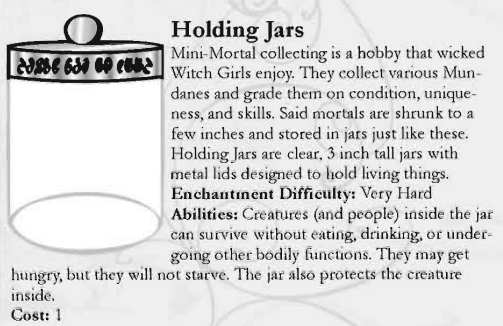
Somewhere a brilliant scientist was taken from their family and the world deprived of their discoveries because some little shit needed to complete her human collection, and no one will stop her because it's allowed under witch law.
Fuck you, WGA.
Fairy Glitter – Glitter made from actual fairy dust that makes people and things look better when it's sprinkled on them. It doesn't say whether or not the dust used to make it was offered or paid for or they just took it.
Potion Kit – Makes 10 points worth of potions. Woo.
Scroll Parchment – Notebook paper sized sheets of parchment that come in packs of 10. You can make the writing on it scramble or disappear until the intended reader gets to it too. Just use regular notebook paper. It's cheaper, you get more in a pack, and I'm sure you can find some way to enchant it.
Voodoo Doll Kit – Makes voodoo dolls.
Wand-Making Kit – Makes wands that cost 10 points at the most.
Writer's Quill – A quill that floats near its owner, dictates what they say, and doesn't require ink. Seen Goblet of Fire? Remember Rita Skeeter? There you go.
The jewelry store has a sign over the jeweler's table that says they disintegrate shoplifters, and the blurb describes the reader seeing a pile of ash by the door to prove it. Oh, and the stands rotate magically. Woo.
Characters are only allowed to wear 2 pieces of jewelry at a time.
Aegis Ring – Ignore 1 damage
Babble Ring – Understand any “non-animal” language.
Charm Bracelet – Only has animal charms, touching one of them turns you into that animal. Unlike the Alteration spells, however, they can still talk and cast spells.
Crimson Teardrop – Made from crystalized dragon blood. +1 to casting rolls, +3 health, and is a ward against scrying.
Friendship Bracelet – Can telepathically communicate and share health and zap with people also wearing bracelets and have their names engraved on them. (They're made of metal, not string.)
Guardian Amulet – Summons a guardian.
Invisibility Ring – Makes you invisible.
Rise-and-Shine Ring – Functions as an alarm clock and lets the wearer always wake up clean, refreshed, and well fed. It's dirt cheap (3 points), so I wouldn't be surprised if every witch had one of these and no ever showered or ate breakfast.
Skull Cameo – Not the thing on Lucinda's bow. (Hers is a special item that only she has.) +1 zap and life.
Spooky Ring – See and talk to ghosts. It has another name, but this is the name it's more commonly known by by witches.
Spy Ring – Hear every sound within a 20 ft radius.
The electronics store looks like any other electronics store and the only thing special about it is the owner has a character sheet. Like all things in the WGA universe, magical electronics are just like regular electronics, only better. You also need at least one rank in Cybermancy to use any of them. Naturally, a lot of witches hate them because they're new and are built on things us mundanes came up with.
Celestial Cell – A flip-style feature cell phone that can change its color once a day, can connect to any cell phone on any cell service on Earth and some alternate dimensions, and has a high resolution camera, space for 1000 mp3s, and a battery that lasts 48 hours and can be recharged with a zap point. (Phhf, my crappy mundane feature phone can last for a week and it is always turned on. Beat that, witches.
 )
)
Data Goggles – Neon goggles that let you see computer connections, wireless signals, and radio and TV signals.
Electra Cube – A cube with 4 electrical plugs on it that never runs out of power, provided it's charged with zap every week.
Eye of Net – A round webcam that can walk around on its own and doesn't need a cable.
Ghost Top Computer – A laptop with an invisible frame. It is twice as fast and can hold twice as much info as our best laptops, will run any type of software regardless of OS and system specs needed, can connect to any sort of hardware without a cable, and always connects to the internet regardless of location.
Mona Lisa Drive Computer – Yeah, that's the actual name of the item. It's the desktop version of the Ghost Top, except its casing isn't invisible.
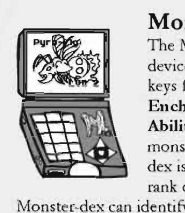
Monster-dex – An obvious trace of an old school Pokedex. Gives +4 to Cryptozoology rolls.
Spell Pod – An mp3 player, but twice as better than any normal mp3 player. It can also hold up to 10 spells.
Witch Widget – A pen looking object that displays information on other witches and the spells they know and the presence of spells.
Zap-Gun – A raygun gothic style gun that functions as a wand and can store 2 spells for use at a later time. I'll admit this thing is kind of cool. But anyone who uses it probably looks like a tool.
More later.
More Equipment
Original SA post
Witch Girls Adventures: More Equipment
Oh my god you guys, more shopping!

Next up is potions and cosmetics. The potion/make up store is run by faeries. One is a feminine man who goes around spraying people with the more helpful potions like a perfume seller. Of course...
Potions come in a wide variety of uses. They can be medicinal, poisonous, stat-boosters, or act as cosmetics. According to the book, they are “quite powerful and almost always useful.” Potions can either be drunk or sprayed on a person.
Alms of Aphrodite - +1 to the Social die type and gives the character the Beautiful talent for one hour, if they didn't have it already. It smells and sounds like the ocean and tastes salty.
Brain in a Bottle - +1 to the Mind die type and gives the character 5 skill ranks to improve any skill the character has except Casting. Lasts for one hour. It's blue, odorless, and tastes like an old book. Yummy.
Changing Blood – The Polyjuice Potion from Harry Potter . It's made from (donated) fae blood.
Dahl's Delight – Turns the person drinking into a mouse for either an hour, a day, or for the entire storyline depending on how many “doses” they take. (The bottle holds 3.) When it's not added to something, it smells like cotton candy. It's a reference to The Witches .
Do and Dye – Change your hair color at will for a day. It's made from distilled rainbows.
Glow Gloss – Have you ever thought to yourself, “This lip gloss is nice, but I wish it turned my lips into a flashlight”? Well, here you go. The tube itself also glows and vibrates to some invisible music for some reason.
Mind Mint – Makes any person who eats one forget every magical event that they saw within the past day if they fail a Hard difficulty Will roll. It only works on mundanes.
Nightingale – Heals 5 health and removes magical mental problems. The potion pulsates at the same rate as a beating heart.
Nocturnal Nights - -2 to all rolls and the person who drinks it gets bad gas and smells like rotten eggs for a day. It smells like the air after a thunderstorm.
Pretty in Pink - +1 to rolls to make the character seem cool or popular and gives the character the Queen Bee talent. Lasts for an hour.
Princess Kiss – Antidote for Alteration spells. Smells like sour apple candy.
Truth Brew – Makes the drinker unable to lie for an hour if they fail a Hard difficulty Will roll. It tastes like roses.
The broom shop is connected to the electronics shop. Its owner "ran the Equator Rally in 32 hours" and "broke the broom speed record at Atlantis Gorge", which I guess would be impressive if the reader had a frame of reference for it.
Brooms aren't just a way to get around according to the book, they're a "fashion statement". Just grabbing a random broom won't do. When riding a broom or any other flying object, the rider has to spend a Zap point per hour to keep it going. All objects in this section have 15 HP, allow the rider to ignore 5 points of damage from accidental crashes, give a -4 penalty to mundanes to see the flying object when its being used, and are charmed to allow the rider to breathe at high altitudes and speeds and keep objects like bird poop and bugs from getting on her. All brooms are made to carry only one passenger, maybe two if you're lucky.
Getting a broom or other flying object to actually fly requires casting a Rank 2 Elementalism spell. The maximum base speed that the object can travel is 50 MPH times the number of ranks the character has in Elementalism. Some models increase this top speed.
Bewitched Basic - A ratty, handmade looking broom. The straw for the bristles was grown in moonlight.
Black Racer - Uses lacquered black wood and has a curved handle that the rider sits in. The bristles are made from "night swamp" straw and black pegasus feathers. The mundane penalty is increased to -6, the rider gets +1 to broom riding rolls, and the top speed is tripled.
Flying Carpet - Popular in Africa and the Middle East, flying carpets are dirt, stain, and flame resistant (up to 5 points worth) and can hold from 4 to 8 people, depending on the model.
Heaven's Harpy V - This broom model dates back to World War II, when it was used by Allied witches. (Yeah, witches were involved with both the Allies and the Axis. There's a whole section about that in the setting fluff so I'll go over that later.) This particular model is the fifth version of it. It flies at double the base top speed and can ignore 1 point of damage.
Laser-beam (sic) - A broom made from plastic and "mystical metals" with fiber optic cables for the bristles. Flies at triple the base speed, but can travel at quadruple the base speed for a half hour at the cost of extra Zap. Also grants the rider +2 Reflex.
Sky-board (sic) - A surfboard or snowboard that can fly. +1 Reflex and travels at double the top base speed.
Silver Streak - A silver handled broom with bleached white bristles, for witches who want to be smug about how much money they have (even though there are more expensive brooms). +2 to broom riding rolls.
Training Broom - Baby's first broom, can fly without a spell and flies at half the base speed.
Vespa-Flyer (sic) - A vespa scooter that can fly. It never need refueling and runs entirely on magic.
Zoom-Broom (sic) - A broom model that originated in the 60s. It has a jet engine on it in place of bristles (though the picture doesn't reflect this; the engine is on the side and the bristles are shaped like a cone). Flies at triple the base speed, ignores 1 point of damage in any situation, and is capable of being flown in space, physics be damned.
The section then talks about flying accessories, specifically flight goggles, helmets, and key charms that are used with a magical key to "lock" brooms when they aren't in use. The goggles give +2 to Senses rolls, helmets increases the protective crash shield on brooms and extends it to the witch, and I already explained what the key charms do.
Up next is wands! The owner of the wand shop is described as "fashionable", despite that not meaning anything in the witch community because they all either wear centuries old styles or dress like whatever counter-culture fashion template strikes their fancy.
Wands in WGA work similarly to Harry Potter wands. They are very personal items and contain some of the owner's life force. Unlike Harry Potter however, they don't have to bond with their owner and will work for whoever grabs them right out of the box. If a wand is broken, the witch will repair it instead of buying a new one. Despite all this, other witches can still use another person's wand; they just don't get the special abilities of that wand. Mundanes can't use them at all.
All wands reduce the Zap cost of spells by one (but can't reduce it to zero), "can levitate up to one pound at close range", have 10 HP, and ignore 5 points of any type of damage.
Black Crystal - +1 to cast Curse spells, all spells are treated as being one rank higher.
Dragon Bone - Dragon bones apparently look like "red marble with blackish veins". All "damaging spells" except fire-based ones do +2 damage. Fire spells do +3.
Ivory - +1 to Alteration spell rolls. It's made of cockatrice bones and gold and is modeled after the one wielded by the legendary witch Circe.
Jade - Shaped to look like a dragon, only made by a company called Fong Exclusive outside of Asia. +1 to Resist Magic, +1 to Mentalism spell rolls, and gives the owner an extra 2 Zap every 24 hours.
Magician's - Looks like a black and white magician's wand. Can levitate up to 20 pounds for 1 Zap.
Neon - The wand equivalent of the Laser-beam broom. The blurb mentions that spell casting is always accompanied by neon beams of light or sparkles when this wand is used, but that happens regardless of how a spell is cast or what you use to cast it with. It can change the color of things with a touch for free.
Rustic - Made of carved wood, +1 to Elementalism spell rolls.
Silver - -1 Resist Magic penalty to targets of spells cast with this wand, and it can function as a flashlight.
Standard - Lacquered wood, considered a beginner's wand, can also be used as a flashlight.
Star - This wand has a big ol' crystal star at the end of it. +1 to Healing spell rolls and the durations of any spell cast is considered one rank higher.
Tech - Looks like a tiny radio antenna, can collapse to half its size, and doubles as a USB drive (that holds twice as much as our best inferior mundane USB drives). +1 to Cybermancy spell rolls and can store 2 spells.
The next part is rules for making custom wands. Custom wands cost 22 points at the least to make, making them more expensive than all but one of the pre-made ones (the jade wand). So you're probably better off with one of those unless you don't mind blowing nearly all of your starting points or have the Rich talent.
Creating a custom wand is done in 5 parts. The first part, selecting the base wood/crystal, doesn't give any special abilities and always costs 3 points. The second is picking the coating that the wand is covered in. I don't feel like typing all of this out, so here's a screenshot.
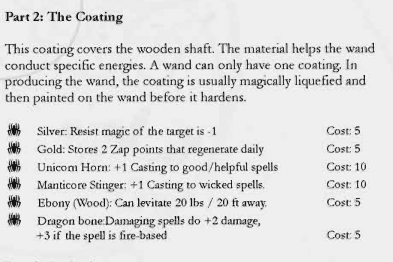
The next step is picking the two magic types that the wand will give the caster a +1 casting bonus to. This is represented as applying liquified gems to the tip of the wand. (10 points per type). Next comes deciding on a focus, which isn't physically represented by anything. A wand can have two focuses, one for range and one for duration, and each is treated as being one rank higher in whatever magic type they affect. (5 points per focus.)
Lastly, you can pick up to three special abilities for the wand. They are, from cheapest (1 point) to most expensive (5 points)
- Turn the wand into a bracelet when it's not in use.
- Conjure up a full course meal for one person.
- Change the color of items with a touch.
- Have the wand function as a flashlight.
- +1 to Spell Breaker rolls.
- The ability to float toward the owner's hand if they're close by.
- Let the owner ignore 1 point of damage.
- Give mundanes a -2 penalty to notice when spells are being cast.
- Turn the wand into a staff and lower the Zap cost for spells by two instead of one.
- +1 to Resist Magic when the wand is being held.
Last is the bookstore. It's really narrow and takes up two stories. The owner's description reminds me of Ms. Frizzle from The Magic School Bus (frizzy red hair, big nose, purple clothing). Except while Ms. Frizzle was pleasantly eccentric and taught children cool science facts, this lady has a permagrin attached to her face and is an asshole for no reason.
WGA posted:
"Text books to the right," she says in an annoyed tone. You feel the need to ask a question, but she points at the curious gathering of half a dozen toads on the counter and floor. "Any questions?" she asks, looking at you with a wicked grin.
Books give stat and casting bonus when they are read while either casting an applicable spell, or before casting one if it is read during combat.
1001 Magical Jokes and Puns - Oh look, another transformation picture... I think.
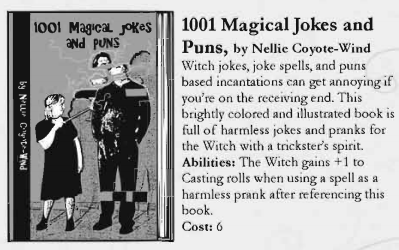
The Complete Guide to Mythical Cryptids - Written by Artemis Olympia, bound in wood and written on green recycled parchment paper. +2 to Cryptozoology and Mythology rolls.
The Big Book of Voodoo - Written by Ebony Le Rue, ribbed with bone and smells like old wood and burnt meat. Lovely. Presumably meant to make voodoo dolls more effective by allowing the caster to use more magic types on it (Curse, Healing, Mentalism, or Necromancy, but not Offensive for some reason) for an extra Zap point, and a +2 bonus to rolls concerning knowledge of famous witches who used voodoo (which is also referred to as "sympathetic magic".)
Denora's Law - A big bitch teaches little bitches how to be proper and more effective bitches. I already posted a screenshot of this book and its blurb in my intro post, but here it is again.

The Imbecile's Guide to Basic Magic - Published by the same Bell and Candle company that made the history textbook from the intro chapter. +1 to casting rolls for rank 1 or 2 spells. It's a play on the "... for Dummies" book series.
Lilith's Song: the History of Witches (sic) - Written by Minerva Stone. Usually used as a textbook for Mysticism classes. +2 to Mysticism rolls.
Magic Diary - An enchanted journal that only displays what's written in it to its owner. It can also be booby trapped with a spell in case someone tries to open it... even though doing so would be pointless because of the first feature.
Midnight Verse: Dark Poetry for a Dark World - Written by Constance Kingston. A goth poem anthology that has silver text printed on black paper and sounds like it was written by someone who is really depressed and sarcastic. Yes, that's what the description says. Anyone near this book who is not a Gothique, a Persephone, a Half-vampire, or has the Creepy talent gets a -1 penalty to all of their rolls due to its depressing aura. If this were an oWoD Mage item, it definitely would have been made by a Hollow One.
Samantha's Guide to Merry Mortals - It's written by Samantha from Bewitched . Half of her face is even on the cover. It teaches its readers the basics of mundane etiquette and how our shitty world works and why "melting people who annoy you is generally frowned upon". +1 to Social rolls when dealing with mundanes.
Saving Spells: The Modern Witch's Guide to Technology - Written by Emily Foster. Yup, the same one that wrote the Foreward. The description gushes about how she is a "magical prodigy" and a/the "mistress of Cybermancy". +1 to Cybermancy rolls and +2 to Computer rolls.
The chapter ends with a few tables listing the cost of common mundane items, though the book encourages GMs and players to not sweat it too much. (The blurb helpfully points out that, if you play a witch who is enough of an asshole to turn people into frogs constantly, but not enough of an asshole to kill them or let them starve to death, a one to two week supply of crickets will only cost you 1 point.)
I'm not going to go through the entire list, but I will point out that that book of shitty goth poetry costs more (12 points) than a mundane desktop computer (7), standard and "top-of-the-line" laptop computers (8 and 10), a large TV (10), and a horse (10). A "alphaplex video game system" costs 3. A stereo costs 6. A cheap car is 35. A "sporty" car is 80.
Up Next: The rest of the gameplay mechanics.
Other Gameplay Mechanics
Original SA post
Witch Girls Adventures: Other Gameplay Mechanics
Chapter 7 is just an overview of the character creation process and some bits to help flesh out character backstories, so I'm not going to go over all of it. I will point out, however, that Harris messed up the sample character. The character is part of the Insider clique which, if you remember, has a D4, two D6s, and two D8s to assign to their attributes. Her attributes use a D4, three D6s, and a D8. Moreover, as an Insider, the sample character gets a free rank in a mundane skill and one in either Mysticism, Focus, or Magical Etiquette. The character has those ranks in Computer and Mysticism. Her mundane skill totals only add up to 9, leaving her with 2 more points she needs to spend. (Insiders have 10 in both skill types.) Her magical skills, however, are done correctly and add up to 11.
To be fair, the blurry as hell picture of the filled out character sheet that's on the same page gets it right. (The D6 in her Social attribute should be a D8 and she has two more ranks in Plucky.) But that is really not something that should have been riddled with errors.
The chapter picture is also really smug.

That's not the look of a woman who is proud of her daughter being a witch. That's the look of a woman who just one-upped someone.
Chapter 8 is the GM chapter, but it also contains other gameplay mechanics that weren't gone over in the other chapters. It starts off by going over Difficulty and Contested rolls again and presents a chart for what attributes to use for Contested rolls. Most are used against themselves, except for Body and Senses which are used against each other for cases when someone is hiding or trying to find someone who is hiding. The book notes that the GM sometimes have to figure things out off the top of their head.
WGA posted:
You, the Director, will some times have to figure out how to resolve a contested roll off the cuff, but hey, that's why you make the big bucks.
That... doesn't really work...
Next comes combat rules. Initiative is determined by the characters' Reflex attribute, with turn order going from highest to lowest. (If there's a tie, the characters go at the same time.) For situations when characters are surprised, they must beat the attacker in a Senses rolls or suffer a -2 penalty for all rolls for the duration of the surprise and the attacker gets a free action. During a combat turn, unless the character performs some witchery to gain extra actions, a character can only perform one attack (either normal or magical) and one non-combat action per turn. A non-combat action can be anything from turning a device on, moving, talking, retreating, or preparing a spell to gain a +1 bonus to casting it. Characters can also "focus their power" with either a Easy Focus roll or a Hard Will roll, which gives them 1 Zap back at the cost of being at -5 Reflex for the rest of the scene. So if you run out of Zap, you're probably better off just running, especially since your movement speed is doubled and you gain +5 Reflex while you're retreating.
To do damage, the casting roll result for a magic attack has to meet or exceed the target's Resist Magic attribute. For physical attacks, the Body or Fighting skill roll has to meet or exceed the target's Reflex. If the attack connects, the target has to make a Body roll. The result is subtracted from the base amount of damage that the spell or attack does, and the target subtracts the result from their health. Here have some charts.
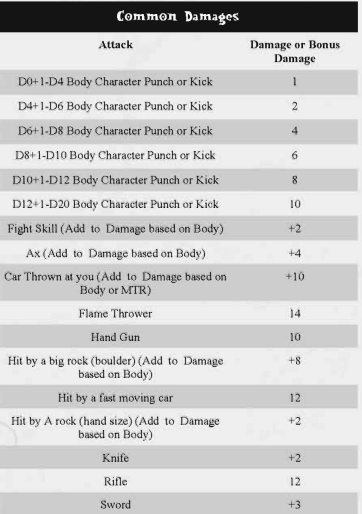
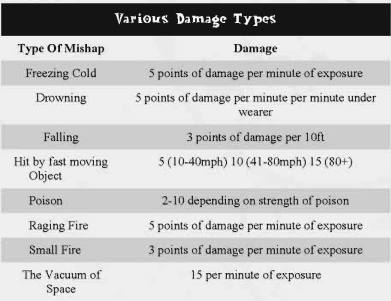
Armor allows a character to automatically subtract a number of damage before the Body roll result is applied. This can be armored clothing or natural armor like all of those "ignore X points of damage" benefits that have been popping up so far.
When a mortal reaches 0 HP, they die. When a witch or other supernatural reaches 0 HP, they are in danger of dying, but because of their super special strong life force, they are capable of hanging on for a bit longer. (Some sups have extra rules applied to this.) When a sup character is at 0 HP, their Body attribute will decrease by one die type for every combat round or minute in-game that they are at 0 HP If it goes under D0+1, they die. The Body die can also be decreased by attacks to the character while they are knocked out. This degeneration can be stopped with a Hard Body roll for every round that the character is out. Returning the character to at least 1 HP via healing spells or first aid will stop it completely. The book doesn't say whether or not the character's Body die returns to its original type when healed.
Along with healing spells, characters can regain health naturally by getting a full night's rest and rolling their Body die to determine how much health they gain back. The result is doubled if they are under medical care.
Objects also have health and armor ratings. They pretty much work the same way except for the Body degeneration part.
At this point in the book, the chapter header switches from the Chapter 8 title to the Chapter 9 title and stays that way until the end of the next chapter.
When flying on a broom or other object, any maneuver other than flying in a straight line and landing at a normal speed requires either a Body or Broom Riding roll at the difficulties shown on this chart.
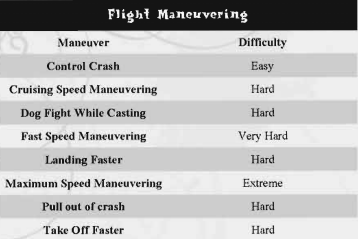
Taking off and landing normally is done at a quarter of the maximum top speed, doing so on a damaged object requires a Hard roll. Cruising speed is considered half of the base top speed. When accelerating, the object's speed doubles every combat round or minute in-game until it reaches its full speed. Maneuvering at cruising speed is an Easy roll and an Extreme roll at maximum speed, unlike what the chart says, and is needed whenever the character changes speeds or turns.
When dogfighting, characters moving above cruising speed have a -1 penalty to all attacks, and a -2 penalty if they are moving at their max speed. They also must make a Hard roll whenever they are attacking or dodging to avoid losing control or having the attack miss.
If the character ever loses control and has to do a controlled crash, she takes 10 points of damage.
The next section is about game building and goes over things like mood, themes, and outlining a game. The themes range from dealing with family ("Maybe an uncle is a joke-loving fae, or a cousin is a wicked witch girl with a thing for shrinking and stepping on anyone who doesn't treat her like a princess.") and one's double life to fighting against other witches, mundanes ("Maybe a mundane corporation is destroying a witch's favorite park..."), and other sups. One idea notes that the general mentality of witches towards mundanes is that they are beneath them and that they are justified in being assholes to them, (No, really?) and maybe the characters want to go against the status quo and help them. It also mentions setting a game in a regular school, which pretty much seems like an excuse to go terrorizing mundanes and doesn't really work considering witches are required by law to be taught how to use their powers.
Now, at this point, you're probably wondering if there's any sort of experience point system in this game. There is. Keeping with the movie-making theme, exp in WGA comes in the form of voodollars. ("Stars in Hollywood get paid, and in Witch Girls they get paid too.") Like exp, voodollars are handed out at the end of a game session and can be used to improve character stats. The book provides charts for rewarding voodollars and prices for stat increases.
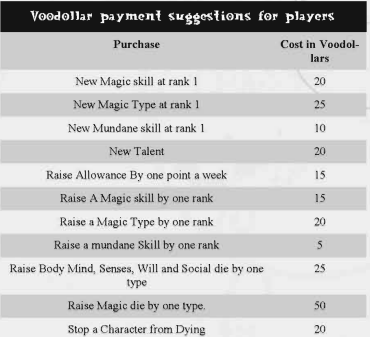
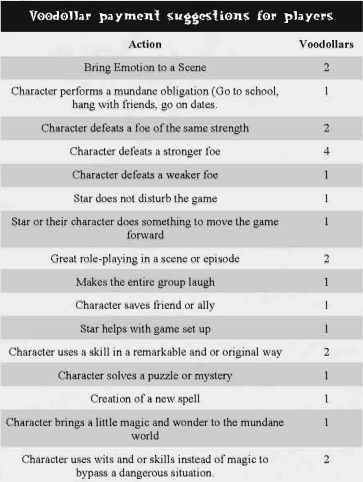
The book even provides voodollars for you to copy and print.
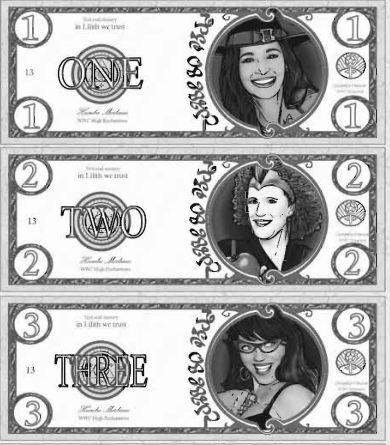
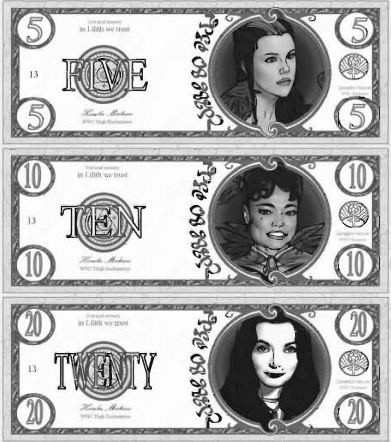
The voodollar portraits, amongst other things, were "drawn" by Harris' right hand woman, Abby Soto. As you can probably tell, her art style usually consists of finding pictures of celebrities and tracing over them. You can tell which aren't traced because there's a large drop in quality and detail when she doesn't do it.
Speaking of drawings, that's the end of the chapter. It's time for another...
 HORRIBLE PICTURE ROUND-UP
HORRIBLE PICTURE ROUND-UP

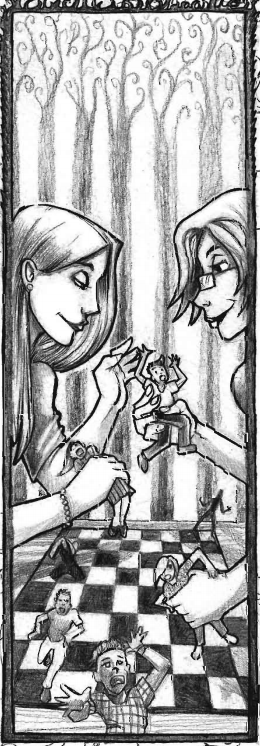
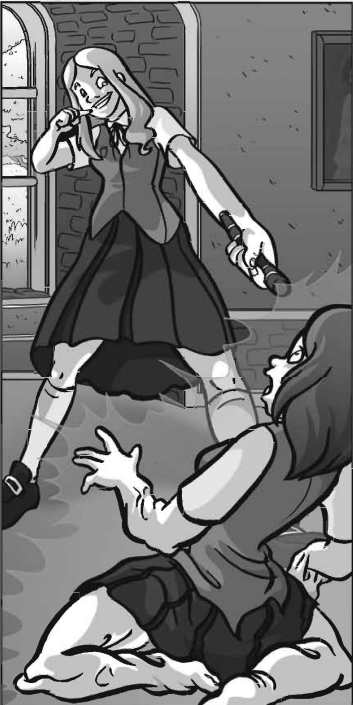
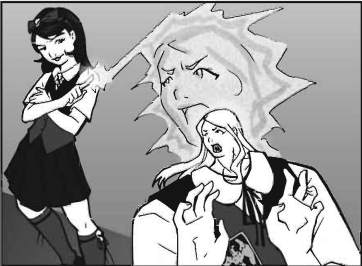
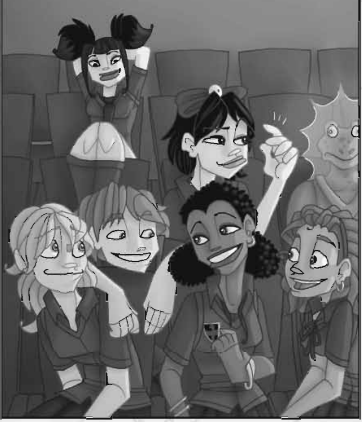
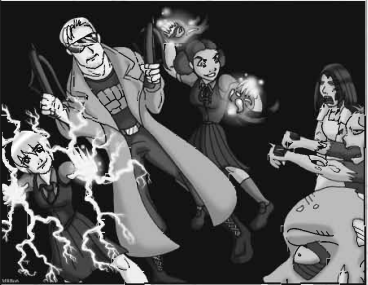
Up Next: The Setting Fluff
Witch Biology/History
Original SA post
That's a shame about the Dresden Files books turning into a hybrid of DBZ and a male Anita Blake. I've only read up to the fourth book and have been meaning to finish the rest of the series.


Witch Girls Adventures: Witch Biology and History
Y'all ready for some setting fluff? I know I am.
The chapter picture is an astronaut on the moon freaking out because he just came across three witches having a tea party. Hell, why not?
The setting chapter is smug right off the bat. Despite the fact that they look exactly like humans and their children have a large chance of being one if their father is not magical, witches are not human. They merely more highly evolved versions of humans.
WGA posted:
[Witches have] evolved mental and spiritual connections to the universe that even the smartest and most brilliant of humans can't start to comprehend.
If you've been following along, you already know that all witches are beautiful, smart, and powerful. This is due to the vast amounts of magical power that they are capable of harnessing. Along with those general benefits, the magic flowing through them also changes their anatomy and some of their biological processes. These changes include:
- Having "brighter and more vibrant" eyes and being able to have eye colors outside of the normal blue-brown-green spectrum. Want a character who has violet eyes like Elizabeth Taylor? Want one with pink irises with a ring of red around the pupils and silver flecks scattered throughout? Knock yourself out.
- Perfect skin. Witches do not get scars from wounds, nor do they tan, sunburn, wrinkle, have moles in weird places, or get acne.
- Immortality. Once a witch hits her 20s, she stops aging and stays that way for the rest of eternity. Those witches who pretended to be goddesses that were mentioned a while back? Some of them are still around. If need be, a witch can look older after she's had a child or hits an age where you can't easily use "good genetics" as an excuse.
- Natural immunity. Witches are completely unaffected by mundane illnesses, so they never get sick or die from such things.
There's no explanation for why only women can be witches. I imagine it's some
 crap about women being more connected to the earth or something. Naturally, if a witch has a son by a mundane father, that child will be completely human; no perfect skin, no immortality, nothing. Same goes for any daughters who are unlucky and don't get the magical genes. This only changes if either the mother or the father has some otherkin in them, then the child will be whatever type of otherkin they are. The book provides a handy chart for determining the odds of a witch having magical siblings.
crap about women being more connected to the earth or something. Naturally, if a witch has a son by a mundane father, that child will be completely human; no perfect skin, no immortality, nothing. Same goes for any daughters who are unlucky and don't get the magical genes. This only changes if either the mother or the father has some otherkin in them, then the child will be whatever type of otherkin they are. The book provides a handy chart for determining the odds of a witch having magical siblings.
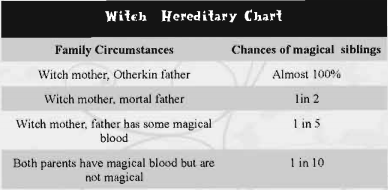
Despite practically being gods themselves and having had much of the guesswork of the universe taken out for them, witches follow the same religions as mundanes. Unlike mundanes, however, they don't turn to religion to find meaning in their existence, because according to the book, they instinctively know what that is.
WGA posted:
Witches instinctively know their purpose in this world. And that purpose is to promote wonder.
Witches have a nearly physical repulsion to stagnation, complacency, and conformity. To them, the world is a better place when everything is moving and changing, for change is growth and growth is good. One of the many ways to promote change is to promote wonder. Witches try to show the world in small ways that do not break the laws of the WWC that the earth still has mysteries in it, be it through a spell or through inspiration as an artist, teacher, musician, or just unique individual (sic).
Riddle me this, Channel M: How is this...

and this...

and this...

and this...

... promoting wonder? I don't see any wonder here. Change and maliciousness for the sake of being malicious yes, but no wonder.
Moving on, the next bit is about the history of witches. In terms of setting history, WGA has the same issue that the old World of Darkness had: Normal humans can't do shit for themselves. Every major historical event was either caused by or heavily influenced by witches or other supernaturals. This part also highlights another running theme of the fluff in the book: That witches are ostracized because they are different and unique. Naturally, us dumb mortals have a tendency to mock or hate something that we don't understand or is different from us. So witches get to have their cake and eat it too: They get to be the poor oppressed minority while at the same time being superior in every other way to everyone else. It also doesn't help that witches are given free rein to treat humans like shit as long as whole countries don't raise up to stop them, and most do. It kind of reminds me of all of the social justice types on Tumblr who scream about how white people are responsible for everything horrible that has ever happened and that it's okay to be racist towards and want to commit mass genocide of them because "they had it coming".
Anyway, the first witch was Lilith. Lilith was born to mortal parents around the dawn of civilization. There is no explanation for where her powers came from. The other cavemen were scared of her powers and banished her to the wilderness, where she spent the next several centuries being queen of the animals or something. Years later, she was found by and fell in love with a "mighty warrior" and they had four children: Isis, Mab, Gilgamesh, and Echidna. Isis, Mab, and Echidna were witches like their mother while Gilgamesh was the first immortal.
Echidna, along with the standard witch powers, also had power over darkness. She was also very sickly and allergic to the sun. Jealous of her older sisters' beauty and her brother's strength, she drove them against each other. This lead to bickering amongst the siblings that would continue for centuries and with their children and grandchildren while Echidna built up an army of darkness because she's evil and that's what evil people do.
Gilgamesh's son, Zephyr, eventually found out about the army and told his father and aunts. When they went to confront her, Echidna killed Gilgamesh and severely wounded Mab. Isis took her wounded sister and hid behind the moon so she could recover.
Meanwhile, Echidna disguised herself and told Zephyr that Mab and Isis had killed Gilgamesh. Gathering together his siblings, their children, and the humans that were a part of their society, he declared war on the two witches. This led to a mass murdering of witches before Mab and Isis finally gathered up their own army to stop him. But by the time that happened, Echidna surprised both sides with her own army and took over the world. She would rule the world for the next several centuries, setting civilization back and forcing witches and immortals into hiding.
Some time before all that, Lilith had created an alternate dimension for herself and retreated to there, leaving everyone to think that she was either dead or "willed herself out of existence". Centuries after Echidna's uprising, a witch named White-Corn-Woman and an immortal named Thunder Bird found Lilith, told her about what happened, and pleaded for her help.
Lilith returned to Earth, gathered her descendants together, and told them about how disappointed she was with all of their fighting. Echidna, too mad with power to think rationally, ordered her forces to attack. Lilith instantly erased half of them from existence with a mere glance, caught Echidna when she tried to run, and bound her to a large stone.
Not able to bring herself to punish her own child, she forced Mab and Isis to do it for her. The two banished her to "the darkness beyond space and time" where all of the Lovecraftian style nasties hang out, cursing her to sleep for centuries at a time. Though there were still short periods where she could wake up. That dumb little decision allows Echidna to be a constant threat to the universe. (Seriously, why bother letting her be awake at all?)
Before vanishing for good, Lilith helped her children clean up the mess of the world that Echidna made and declared that witches and immortals should help and protect the earth and all that live on it. For the next several millennia, they did just that. Witches became the teachers of humanity while immortals protected and provided for them.
Sounds alright so far, right? Well, a lot of witches eventually became mad with power and allowed the mundanes to worship them as gods, helping those who asked and punishing people whenever they needed to amuse themselves. Eventually, most humans no longer had to rely on the "gods" and went their own way, forcing the deeds of their supernatural benefactors to become myths and legends. Those who stuck around and the witches and immortals they worshiped self-banished themselves to the continent of Atlantis. Some ambiguous great tragedy happened and they were never heard from again. According to the book, this is when history according to mundanes started... which makes no sense because there is evidence of some of the Greek goddesses being witches, and we certainly do have an idea of what went down before the Greeks rose to power.
As humanity continued to spread, witches started to become paranoid about the possibility of mundane prejudice, which was not mentioned until now or detailed, getting out of hand and turning into an uprising against them. So, the 13 most powerful witches in the world gathered in Macedonia and created the first Witches World Council. They created the basic laws and organizations that would govern the witch community and laid down its "first and greatest law": "A witch is above the laws of mundanes but shall not interfere with their laws, ways, and means."
By the beginning of the Middle Ages, things were peaceful, witches were fading into legend "again" even though there is no indication that they were ever acknowledged as anything other than such, and immortals had vanished. But then a few idiot witches started the Inquisition, which lead to massive witch hunts in Europe and the Americas that would continue until the Salem Witch Trials of the 1690s and killed more humans than witches. Nevermind the fact that a quick glance at Wikipedia shows that there were witch hunts going on before and after this period of time and the Roman Catholic church cared more about Jews and other heretics than witches. Indeed, witchcraft didn't become a punishable offense within the church until the 1480s, two centuries after the first Inquisition started. But did you honestly expect an accurate depiction of history here?
The next milestone in witch history is the beginning of African slavery. Hoo boy...
WGA posted:
The next great upheaval came from witches who almost unanimously were against the institution of African slavery in the new world. Ironically, many witches who loved a mundane had little love for mundanes as a whole; they found the idea of prejudice and slavery based on skin color an affront to all that the ancient witches had worked for.
So, we have a group of beings that is perfectly fine with treating another set of beings like shit or outright killing them because they can, and I'm pretty sure that whole bit about witches going mad with power a while back involved some of them making humans into their slaves. And mind you, slavery was around in some form in multiple areas of the world long before Africans started getting shipped off to Europe and the Americas. So I guess slavery was okay with witches when it was based around being a citizen of a conquered country and one's religion and they were the ones doing it. But when it suddenly becomes about skin color? Fuck that shit! Witches are a repressed minority, remember?
Am I the only one that sees the hypocrisy in this?
Anyway, the institution of African slavery started a social rebellion and many witches began to ignore the WWC's laws of interaction so they could use their powers to help slaves escape their masters and start the American Civil War. This weakened the WWC's influence and lead to a "golden age" where witches influenced and became the muses of scientists and artists all over the world. It was around this time that the witches also began to rediscover the immortals, who had integrated themselves into human society long ago and did a much better job of it than the witches did. For ambiguous reasons, this rekindled the rivalry from the era of Lilith and her kin and magic schools began to warn their students to stay away from immortals.
The next major event in witch history came in the 1930s. Vlad Dracul/Dracula, an acolyte of Echidna, traveled to Nazi Germany in order to get the government's help in freeing her. Why he thought the Nazis were the best people to go to for that isn't explained. (The book also incorrectly describes their government as "socialist".) While there, he met up with Ingrid Frieze, a former WWC magistrate who was propping up the Nazi regime with her powers. Ingrid convinced him that it would be better to just rule the world in Echidna's name than release her, and the two, along with their own little army of witches and vampires, helped start World War II.
The attacks on the witch community by Dracula and Frieze's army lead to the creation of the British Mystical Happening Organization, a supernatural army consisting of witch "fighter pilots" and immortals who fought alongside the Allied forces. During the Normandy Invasion, a task force of witches and immortals captured Frieze, stripped her of her powers, and banished her to live among mortals. An immortal named Alexander almost killed Dracula, but he was able to escape and go into hiding shortly after. Naturally, because humans can't do shit for themselves, the Axis armies fell apart without their supernatural backers and the Allies won the war.
Due to the war, many more humans knew about the existence of witches and other supernaturals. The otherkin saw this as an opportunity to finally come out and integrate with mundanes. Without hearing them out, the WWC cast a spell over the entire world, erasing humanity's knowledge of all of the supernatural happenings that had occurred over the past 200 years. This of course pissed off the otherkin, and relations have been strained ever since. The WWC, however, grew in strength due to the new sense of unity among witches that the war brought.
The veil didn't last long, however, because by the 60s, witches were again influencing mundanes, this time helping out the Civil Rights Movement and other counter-cultures.
You know, fuck it, this doesn't come up for a bit, but I'm just going to point it out now: In most magical communities, otherkin are not allowed to vote.
WGA, page 91 posted:
[The Ladies of Days] are the members closest to the people and the true representatives of the common witch (and otherkin where they are allowed to vote).
WGA, page 92 posted:
Each magic town elects various officials to help run things. Local witches (and otherkin in places where they get to vote) choose officials such as the Mayor, Sheriff, City Council, and City Enchantress.
Once again, it's perfectly fine for witches to be racists and bigots, deny the rights off, and do horrible things to other beings including murdering them for petty offenses, but it's not okay for humans to do so because... they don't have magic, I guess. God damn, this game...

Anyway, from the 70s onward, witches started to become divided between those who embraced new ways, such as the creation of Cybermancy and living among mundanes, and those who held on to their anti-mundane, old world beliefs. Unfortunately, most of the WWC is made up of the latter group, what with witches being immortal and all, so the status quo favors them. The creation of the internet also allowed witches and otherkin to start coming together again.
Oh, and Echidna may or may not be coming up on one of her awake periods.
Up Next: Witch Society and Government
Witch Society/Government
Original SA postAlien Rope Burn posted:
The real question at this point is:
What sort of flower does their shit smell like?
Witch-hazel.


Witch Girls Adventures: Witch Society and Government
After the history lesson, the book gives a rough rundown of the different witch cultures on each continent. Harris claims that a "traveling game" can be educational. And it probably could, if you have a GM that's willing to do research, unlike him.
North America - North American witches have embraced technology, but due to being a melting pot of cultures, is not as unified as witches on other continents. Native "shamanesses" are also more likely to stick to their old traditions. You think?
Central and South America - The second largest magic school in the world, Moon Jaguar, is located in Belize, and witches in this area of the world tend to rally around it since a lot of them graduated from there or are otherwise connected to it in some way. Because this area is mostly poor and rural, a witch or someone rumored to be one tends to get automatic respect, "even though some of the "more educated" people dismiss these rumors".
Europe - More arrogant and even larger classist assholes than witches in other parts of the world are. Witches in Europe divide themselves in three tiers: Hedge, Service, and Noble. Hedge witches are old school shamany types, service witches work for mundanes or other witches (Kiki from Kiki's Delivery Service could be classified as one of these), and nobles are witches descended from the various noble houses of Europe and are stereotypically snooty towards other witches. Hedge witches are usually taught their magic by Service witches instead of other Hedges for some reason.
Asia - Rural China, Mongolia, and eastern Russia are poor shitholes, so like South America, witches there get automatic respect and awe of their powers. Also, those areas are apparently so isolated from the rest of the world that it's not uncommon for witches there to not know about the world wide witch community or even of other witches in their own countries. Japan, Taiwan, and South Korea have a mix of old school and new school styles of magic. Japan is also divided up into territories that dictate who can cast spells in what area. The exception to this setup is Tokyo, which is open to everybody. Tokyo also has more witches living in it than any other mundane city in the world.
Africa - Third world shithole where witches are pretty much forced to use more unsavory spells to make a living. Somewhere in central Africa is a hidden country the size of the state of Virginia named Wanobi, which is controlled by a family of witches who rule the country as queens.
Middle East - Isolated and territorial. Unlike the rest of the world's witches however, they don't see themselves as being above otherkin, and it's not uncommon to see them working together "as long as their political and philosophical beliefs are similar".
India - Like Japan, the country is also divided up between different groups of witches. Unlike Japan, however, it is more for survival than it is about respect. These groups gain new members by kidnapping young witches from their mundane families. They use their powers to live in luxury when they are not using them to kill witches from other groups, which they will do at the drop of a hat for any reason. This has caused a noticeable population decline in the witch community there.
Oceania - For Australia and New Zealand, see Europe and take out the noble witches. For all of the other countries in that area... make something up, because they're not covered.
Connected to Earth are roughly hundreds or so "pocket realms". The book only goes over 6 of these.
The Atlantis Rift - A giant "tear" in the Mediterranean Sea somewhere between Italy and Libya marks the entrance to it. Hundreds of tiny islands orbit around the rift.
Avalon - The fae used to live here, but they left a while ago and now it's the location of the Coventry School for Girls. The entrance to it is somewhere off the coast of Ireland. It's an island full of mythical creatures.
Mu - A beautiful island located somewhere in the Pacific Ocean with links to other realms. Merfolk live here, and it's the location of the Garden of Mu School of Magic.
Santa's Workshop - Santa's real, and he's an immortal. (His name is actually Kris Kringle and Mrs. Claus is a witch.) He still brings toys to good little children, "though many do not believe in him".
 I don't think I need to tell you where his workshop is.
I don't think I need to tell you where his workshop is.
The Empire - A "wild and deadly reality" that is described by people who've been to it as "sword and sorcery with some Victorian Age ideas and technology added in". An evil royal family used to rule it, but presumably don't anymore due to political upheavals that have also closed the entrance to the realm on their side.
The book doesn't outright say it, but this is the realm Lucinda is from. I imagine the entrance was closed so her evil little ass doesn't try to go back and wreck shit up even more. Here's a picture of it from one of the many iterations of the Princess Lucinda comic.
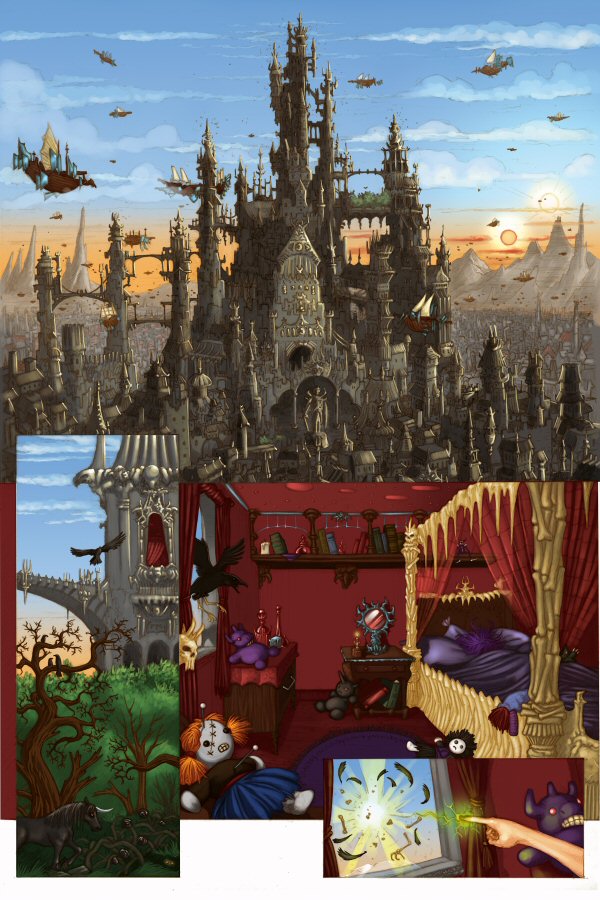
Xanadu - Location of the Dragon Stone School of Magic, enlightened humans also live there. Located in a mountain pass somewhere in northern China.
Now for a lesson on witch society. Most witches, even if they hate humans, spend most of their time in the human world. (The nastier ones do it "to lord over them or to use their powers to live better than they could in the magical world.") The WWC also tends to ignore more things that go on in the mundane world, so that's a plus too. Despite this, witches naturally have to go to the magical world to participate in magical society. This is done via magical portals set up in nearly every major city in the world that go to either pocket dimensions or just areas of the city hidden behind avoidance charms.
All witches are required to obey the laws and orders of the WWC. These laws and orders sometimes also apply to otherkin as well, since the WWC is more organized and powerful than their respective governmental bodies (The Immortals Union, the "Fairies Confederacy", and the Nightling Combine.) and can easily override their rulings.
At the head of the WWC is a group known as the Coven/Council of the 13. The coven consists of the Exalted Enchantress, the six Ladies of Days, and the six Ladies of Nights. The Exalted Enchantress is pretty much the queen of the witch world and keeps the position until she is either killed or retires. When that happens, any witch who wants the position can apply for it, and can get it by passing a bunch of tests on "witch laws, etiquette, and power" and getting an unanimous vote from the Ladies. According to the All About the Voodollars supplement, the current Exalted Enchantress (or "High Enchantress" as that book calls her) is a 2400 year old Greek witch named Hecuba Morbane, the lady on the one voodollar bill. Her blurb in that book says that she's all about peace and cooperation between witches and otherkin. I don't believe it and based on the general witch mentality, I have no idea how she managed to get elected on that platform. Probably used a bunch of Mentalism spells...
The Ladies of Days are the elected representatives of the witch communities from each of the different areas of the world except Central America, greater Asia, the Middle East, and the Pacific island nations, because fuck them. (The book says that the reps are from North America, South America, Europe, India, Africa, and Australia.) They are elected every 20 years.
The Ladies of Nights can only be elected by the Exalted Enchantress and keep the position until they either die or retire. They cannot be replaced if the current Exalted Enchantress doesn't like them. Naturally, most have had the job for over 500 years and they are one of the big reasons why witch society sucks.
Beneath the coven are the Great High Witches. These witches are the council representatives for each of the continents and some of the pocket realms and are in charge of those areas of the world. They are elected by the Council of the 13. Beneath them are the various representatives of the different magical communities, whom. again, otherkin usually cannot vote for even though they have to live under their rules.
The WWC also has several organizations that are in charge of various areas of the magical community. These organizations are: Dimensional Security and Interaction, Magical Means (economy and trademarks on magical devices), Magical School and Academia, Magical Studies and Lore, Mystical Flora and Fauna, Office of Magistrates, and Otherkin Interaction. Generally, the lower in an organization you are, the more you get treated like shit. Yes, this is pointed out in the book. Witches are assholes. What did you expect?
Unlike the other organizations, the Office of (the) Magistrates gets their own section. It starts off with this quote.
WGA posted:
Over fifty thousand witches exist worldwide. There are ten times as many other intelligent supernatural beings, plus some 7 billion humans. And one group has to make sure it doesn't all fall into chaos.
Hold up, I thought witches were agents of chaos. Wouldn't they like that to happen? Anyway, if you go by the 99.9 repeating % of the world being human figure from the start of the book, there are round 7 million supernatural beings on earth. About 50,000 of them are witches, leaving around 6,950,000 immortals, vampires, faeries, and shapeshifters, and maybe some other intelligent monsters too.
Remember: Oppressed minority.
Edit: Okay, I'm a dumbshit and didn't notice the "plus" there until months after the fact. So it's really about 50,000 witches and about 500,000 other supernaturals, which is separate from the 7 billion some humans on the planet. But that doesn't make witches any less assholish or justify their actions.
Anyway, that quote is etched into the walls of the Magistrates' office to remind them of how important their job is. Their job is to make sure that the masquerade isn't broken on a large scale. They are responsible for warning, fining, and punishing witches who break the Laws of Interaction and either clean up "or overlook" the messes they make. They also deal with mundanes who find out about the magical world and decide to talk to too many people for the Magistrates' liking.
The Magistrates are divided into four groups: Delphi, Librarians/Liberians, Shadows, and Wardens. Delphi watch for troublemakers from the office's hall of mirrors. Librarians assign missions and take care of the archives. Shadows are undercover field agents that are called in when the Office needs to be discreet about its operations. Wardens carry out punishments and a lot of people don't like and/or fear them. Oddly enough, the office has otherkin and even some mundanes who know about the magical world working for them... even though they are considered second class citizens to most witches.
As far as their involvement in game plots goes, a lot of Magistrates tend to forgive young witches or give them a chance to clean up their own messes because they're kids and kids are dumb and still learning how to use their powers.
This whole bureaucratic clusterfuck is based in an isolated valley city known as Hecatia or "the Grand Mall". It is located in Macedonia and is the largest witch only community in the world. It is only accessible and seen by witches or those who are accompanied by a witch. "The atmosphere is part-bazaar, part-carnival, and part-vacation resort." Meetings of the WWC take place once a month in the Council Hall and is open to everyone in the city. It has enough seats for all of the 50,000 some witches in the world and then some.
And now for those Laws of Interaction that I keep bitching about. The goal of the laws is not to police the witch community and limit their freedoms, but to protect them from the possibility of us dumb mundanes starting an uprising against them. How the laws are followed are mostly based on how each witch interprets them, and the WWC is just fine with that as long as it doesn't cause global wide issues because freedom. I'm just going to quote them completely. The stuff in parenthesis is supposed to be how young witches usually interpret the laws.
WGA posted:
1: Witches should not interfere with mundane governments laws and institutions. (No turning world leaders into toads or blowing up Congress for stupid laws.)
2: Witches should not reveal to the masses their true natures. (It's okay to tell a few people you trust or can bully that you're a witch, but not the whole world.)
3: Witches should not use magic to affect the mundane economy. (No turning lead into gold for profit. If you want mundane things, use "legally" earned mundane money.)
4: Witches may accept mundane money for mystical services and trade. (If you need a wand you can pay for it in cold hard cash or trade in magical stuff and services.)
5: Witches shall police their own transgressions in mundane society. (If you do something stupid, fix it yourself -- or else. If someone else does something stupid, help they fix it.(sic))
6: Witches have the right to use magic to promote their rights of life, liberty, and the pursuit of happiness, as long as doing so does not break any of the other laws of interaction. (You can do what you want as long as you don't break the other laws.)
7: Young witches must be trained to understand the laws of interaction and their heritage. (If you're a witch girl, someone will teach you magic and witchy ways and traditions.)
8: Altering time in a way that would alter mundane government, history, or economy on a large, noticeable scale is strictly forbidden. (No saving Lincoln from assassination, buts (sic) okay to go back in time and save your cat from being hit by the paperboy.)
So, as you can see, the Laws of Interaction can be exploited pretty easily if you know how. But the general loophole of most of these things is as long as whole countries don't notice you doing something or there's no one alive or intelligent enough to go tell others what happened, it's perfectly okay and within your rights to do.
And that's why witches in this universe get away with turning and murdering random people, and I imagine that "no conjuring money" rule isn't highly enforced either.
Up Next: More society stuff. I'm not even halfway through this chapter yet...
Common Life, Magical Towns, and Organizations
Original SA post
Witch Girls Adventures: Common Life, Magical Towns, and Organizations
Despite being put on this planet to create and foster change, most witches don't like the idea of changing their own lifestyles or ways. The witch community on a whole is steeped in tradition and strict laws of etiquette. Anyone who doesn't follow them or, God forbid, tries to bring mundane ideas into magical society or consider maybe not treating humans as inferior beings, are not considered to be proper witches. Along with the unspoken rule that witches are above mundane laws, there are 10 basic rules of conduct that every witch must follow. In magic schools, these rules are put into practice in interactions between the students and staff.
WGA posted:
1: Show respect to your elders at all times. Present yourself with a curtsey. Speak only when spoken to by an elder witch. [That's three rules...]
2: Do not work another witch's spell without her leave. Do not break or alter another witch's spell without her permission (unless that spell is cast on you).
3: Do not case spells on things belonging to other witches.
4: Witches do not lie. (As they are powerful and above most punishments, some witches believe there is no need reason to lie. (sic))
5: Never point at another witch. (Pointing in some circles is seen as a magical challenge.)
6: Never ask a witch her full name. Accept whatever name she gives you.
7: Never speak a witch's name more than three times in a minute. [Are witches like Beetlejuice? Does saying their name three times in a row summon them?]
8: When entering a new land (town or city), report to the most powerful witch in that town.
9: Neither speak to mortals and other low creatures nor trust them unless you really have to.
10: Bragging and bravado are beneath a witch.
Naturally, younger witches who aren't brought up exclusively in the magical world or have asshole witch relatives are more likely to break these rules and see the anti-mundane ones as racist/speciesist (or, as the book calls it, "mundanist").
Despite the fact that a lot of witches also see physical activity as being beneath them, sports are a thing in the witch world. I apologize for anyone who was waiting for this universe's Quidditch ripoff to come up, because there isn't one. Instead, witches in this universe participate in three sports: Broom-racing, aerial expertise or "broom rodeo", and soccer. The first two have been around for a while and can create celebrities, while the latter is fairly new and only a few school teams exist. No, there's no mention of the witch world getting all pissy over their kids playing a "mundane sport". Even though you'd think it would be an issue. (And no, they didn't add magical elements to it. It's just regular soccer/football.)
Being stuck-up snobs who love the idea of privilege and wealth, witches fucking love balls and other formal events. In order to teach their students social graces, and because this is a game for girls and girls love to dress up in pretty clothes, magic school will usually hold several formal balls during the year, with ones most commonly being held on Halloween, during the holiday season, and in the spring.
As this is also a game for nerds, nearly all witches love to read. Along with magically enhanced version of mundane books that add moving pictures, sounds, and what are essentially smell-o-vision and taste-o-vision to them, witches also have their own book series... a lot of which just seem to be ripoffs of our ideas. Along with the books that were in the equipment chapter, there are also things like this:
WGA posted:
The Molly Norman Series: Stories of a young girl who discovers she's a mortal (and not a witch) and must go to mortal school.
I can see that book series going to some pretty dark places... I imagine it as being like Harry Potter , except Harry never leaves the Dursleys and he gets turned into an animal every other week.
Another thing with witches is "spelling bees", basically competitions on who can cast the best spells.
Witches also have their own TV channel. The one and only station run by witches is the Astral Airwaves Network or ANN. It can be picked up by any Cybermancy powered electronic or scrying device and runs 24/7, broadcasting pretty much any type of show you can think of. Once again, otherkin are allowed the privilege of being on witch shows despite being second class citizens. Some of the more popular shows featured on ANN include:
WGA posted:
Counciler: The Council of the 13's newest and youngest member is followed around. It's a first hand look at magical politics.
Monster Fighter: Witches and otherkin battle monsters and each other in the ring of pain.
My Pet Mortal: A young witch discovers a mortal (who's an out-of-work comedian) and tries to keep him hidden from her family.
Wheel of Misfortune: Players spin the Wheel of Curses and try to survive.
I don't get My Pet Mortal . Did she just find him off the street and shrink him for the hell of it? Did she find him shrunk in her house already? If the latter's the case, then her family probably already knows about him.
There are numerous magical singers and bands. Some bands have crossover appeal, but most don't and a lot of witches like to be smug about the fact that they have access to bands that their mundane friends, if they have any, don't. Some of the more popular performers include:
WGA posted:
Ginger: The 16 year old witch with one name sings witch pop tunes and is the most popular witch girl in the world.
Hecate's Hate: Dark, brooding, and mysterious, this quartet of wicked witches uses classical undertones to add something different to their wicked, Gothique music.
Midsummer's Night: This group of fae sings infectious, upbeat music.
Old Skool: This too cool immortal rapper Barnabus and his "historical homies" bring a sense of history to their music, covering everything from ancient battles to the rocky relationship between immortals and witches.
Vlad: The handsome vampire rocker is the hearthrob of many a young witch. He sings soulful and pain filled ballads about the many loves of the creatures of the night.
Channel M should use all of that money that they waste on art commissions that they don't use and make a music video for Old Skool. I want to see that group in action. It sounds hilarious.
Surprisingly, witches do not have their own separate internet. They do, however, have their own password or Cybermancy protected websites, which are all part of the .wch domain. Witch sites run the gamut from meet-up and dating sites (Coven-up.wch and Lovepotionnumber9.wch), spell databases (Myspell.wch), and their own ripoff of E-Bay (E-cant). Naturally, there are magical viruses and trojans that can fuck up their magical computers as well. This section also introduces the concept of "toadies", mundanes that want to be part of the magical world so badly that they are willing to become servants of witches, as well as tricking them via e-mail into meeting up with them.
The next part goes over magical towns, but there's really no new information other than the avoidance charms on most magical towns give a -10 penalty to mundanes to remember, detect, or find a town. Oh, and witches use unicorns as regular beasts of burden, because a regular horse just won't cut it. There's also a list of buildings that one may find in a magical town. The only one of note is the "mundane store", which allows witches who are so far up their own ass that they won't even risk having even the tiniest bit of interaction with mundanes to buy mundane items.
There's also a little paragraph about building a town for a game. It's common sense stuff (e.g. You need to create the mayor and decide how big it is.) and doesn't really help at all.
Up next is a list of various witch organizations. Being a member of an organization can give a character an added bonus or special equipment, even if it doesn't seem like these groups would want to recruit 11 year old girls.
Cryptozoology Task Force - The ALF for witches. These guys travel the world and help endangered magical creatures, even to the point of killing or kicking people out of their own homes so that the animals can have the land that they're on. Otherkin are allowed to join as well. Members get a +2 to Social rolls when dealing with intelligent magical creatures.
Hex Scouts - Witch Girl Scouts/Guides. Members get a scouting uniform which allows them to understand any language while wearing it.
Highbinders - ... These guys...
WGA posted:
Highbinders is an exclusive organization of witches who see themselves as the keepers of proper witch etiquette and superiority over the world. They are usually very powerful, snobbish, and elitist witches from very snobby and elitist families. To be a Highbinder is to be the very best magically and the very worst towards your fellow humans and witches.
These guys are this setting's version of the Death Eaters. They want to remove the already paper thin veil of secrecy and openly rule over humans and otherkin. Rumor has it that they are secretly plotting to take over the WWC.
Of course, they don't really work within the setting seeing as most of the witch community treats humans like shit and thinks of themselves as being above mundanes and otherkin already! So I like to think of them as being similar to all of the idiots who scream about how they are going to start a revolution against the Obama Administration and turn the US back into a democracy because the country is now a communist hellhole because reasons.
The Highbinders are very secretive and exclusive. Only Sorceresses and Insiders can join since membership is only gained via nomination. One of the tests to become one involves turning 50 humans into frogs within three days and presenting them for a count. Members get a special ring that they can use to communicate with other Highbinders. So even their perk sucks.
Godmother's Guild - These witches grant wishes (one per person) to deserving mundanes. Most other witches, naturally, think they're idiots. Members get a special wand that gives +3 to casting rolls when granting wishes and can receive their assignments telepathically.
Lilians - "Hippies". They educate and feed poor and elderly mundanes and take down corrupt officials. So pretty much some of the only witches that actually remembered what Lilith told them to do before she vanished. They'll even work with mundane groups if need be. But not even they are above turning and murdering people if it gets the job done. Members get +1 to Social rolls when dealing with authority figures.
Shadow Spells - Gothiques meeting up and doing stereotypical goth things like practicing magic in groups of 13, wearing black, writing bad poetry, and hanging out in coffee shops. They'll sometimes let vampires and goth mundanes join in too. Their perk is a +2 Social bonus to dealing with vampires and ghosts.
Witches Helping Against Malice (WHAM) - The newest group on this list and the polar opposite of the Highbinders. These witches think that mundanes should be treated as equals and go around undoing the damage that other witches cause. They are allies with the Godmother's Guild and "the nicer Lilians" and the Highbinders and Shadow Spells hate them, natch. Members get a +1 bonus to detect and undo evil spells.
Up Next: Magic schools and mundane organizations
Magic Schools/Mundane Organizations
Original SA post
I found a decent quality image of the Naughty/Wicked core's cover and added it to my intro post.

Witch Girls Adventures: Magic Schools and Mundane Organizations
All young witches have a right to an education until they are 18 years old. To help them get it, there are a little over two dozen magic schools set up all over the world, most of which are in Europe. The book gives brief rundowns of eight of them (plus one school for immortals) and promises to give a more in-depth look at two of them, Willow-Mistt and Coventry, in a later chapter and another supplement, respectively. The Coventry supplement was the one that got stuffed in the back of the
Original Witch Girls
comic.
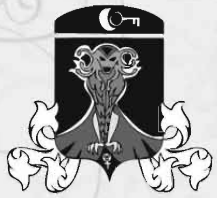
When witches think of magical schools, they think of
Coventry
. Coventry is the best school academically and when it comes to inter-school competitions All of its 80 students are either recruited or are the children of former students. Once in, they are taught that there is no such thing as "good" or "evil" spells and that "it is the user who determines its use". Fortunately, they also teach that there is no such thing as a "good" or "wicked" witch either, so if you act like an asshole and mangle one of your fellow students, they still won't consider you one and kick your ass out because there's no such thing as moral alignments in magic. Unlike most schools, they also don't discriminate based on race, religion, or economic standing when it comes to picking students and employees and teach this non-bias to its students so that it can be applied in the witch community as a whole.
Coventry's headmistress, Titania Morganne, closed the school during WWII to join up with the British Mystical Happening Organization and is the person responsible for bringing many witches and immortals into the war.
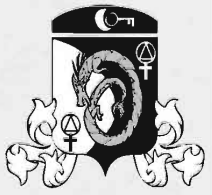
Dragon Stone
is located in Xanadu. No one knows when Dragon Stone was opened, so it may be oldest magic school in existence. The school was originally a monastery set up for witches who wanted to live away from mundanes and... I guess couldn't just get a house in a magical town due to a bad magical credit score or something. Then, it turned into a dragon sanctuary so that they could escape our "ignorance". Then it became a school. Dragon Stone's 94 students are taught to seek what I guess is a form of magical enlightenment "where the body and magic are one". They get up early to do chores and exercise, then spend 12 hours studying. On the upside, everyone in the school is really close and the staff are like parents to the students.
Its headmistress, Grand Elder Shu-Loa, is half-dragon and the oldest witch alive. (No, there are no rules for playing a half-dragon in any of the books that I can see.)
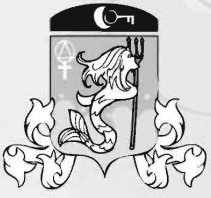
The Garden of Mu
is Coventry's rival school and was "the most prestigious and elite of all schools of magic" before Coventry came along... even though it was established 492 years
after
Coventry was started. (1392 AD vs 900 AD)
The theme of the curriculum and running of Mu is "order personified". Mu aims to turn its students into great witches through "precise and systematic ways" of studying. All of Mu's 100 students dress, eat, and are forced to study and think alike. Anyone who doesn't gets killed. The school is known for its high mortality rate. Keep in mind that the beginning of this chapter pointed out that witches are unique, special snowflakes who thrive when creating change. So naturally they're gonna want to rebel and all this school does is try to make witches go against their very nature.
Mu's headmistress, Lady Ishtar, is the same Ishtar from Babylonian mythology. Considering the order thing, she is also a complete idiot and doesn't get the point of the very race she is a part of. But then, that could be applied to every witch since almost all of them forgot what Lilith told them to do at the dawn of time.
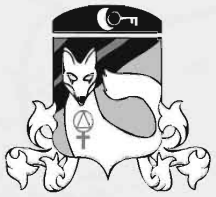
Le Sorcière Pension
(which a quick Google search tells me translates to "The Witch Boarding School"), located in Paris, is a rich, fancy French school for rich, spoiled, and incredibly lazy French witches. It's a small school with only 50 students. Each student gets her own personal cottage, cook, maid, and valet, and the school's curriculum teaches its students to go hog wild in using magic to make their lives easier. ("Why work when magic will do it?") Normal classes, except for leisure ones like art and music appreciation, aren't taught very well compared to the magical classes. Most students fly or teleport to their classes and they are allowed to eat and drink in them.
LSP's headmistress is Contessa Lebeau, a witch who used to be part of the French court. Her title of nobility is Italian, not French. (It should be "Comtesse".) I'm willing to bet the school's name is incorrect in some way too.
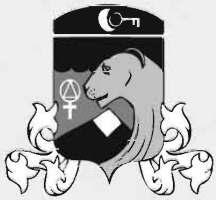
Onyx Storm
, located on or near Mt. Kilimanjaro (the book treats it like a city), is the only magic school in Africa. There used to be many smaller schools divided up by region and tribe, but then the WWC appointed its current headmistress in 1903 and she manged to merge all of the schools into one by 1967. The school teaches its 90 students a mixture of old tribal traditions and modern magic, allowing them to mix and match to find their own style. The school was founded in 1000 BC.
Onyx Storm's headmistress is Dr. Kesa Mtombo, a Nigerian witch. Mtombo is a graduate of Coventry and bases the school's ideals on theirs.
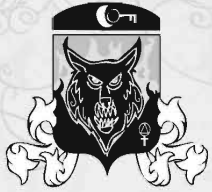
Rheinhexxen
... An evil school for evil witches to send their evil daughters to to learn how to be more evil. Naturally, this school is popular with Highbinders. Ingrid Frieze graduated from it. It has 76 students and is located somewhere on the "German/Austrian boarder (sic)". Its name is similar to "Rheinhessen", the largest wine-producing region in Germany, but I doubt that was intentional.
Evil School's headmistress is Lady/Queen Gothel, a witch who claims to be the evil witch and fairy from every fairy tale ever. Her portrait is on the 2 voodollar bill.
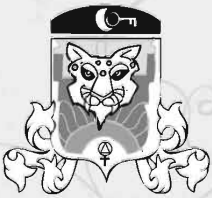
Spirit/Moon Jaguar
, located on the ruins of a Mayan temple somewhere in Belize, is the largest magic school in the world. (The temple was said to have been used to sacrifice witches during rituals. Remember: Oppressed minority.) The school has no modern conveniences like electricity or running water and its curriculum forces more on group magic than individually cast spells. It has 150 students.
Spirit/Moon Jaguar's headmistress is Juanita Ortega. She doesn't have her own little bio.
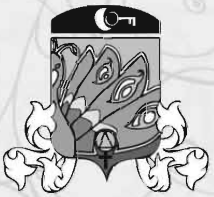
West Grove
, assuming Dragon Stone was founded after 1500 BC, is the oldest witch school on this list. Located in Crete, it teaches its 64 students how to use their magic to get ahead in life. Before the current headmistress came along, it was a really great school known for creating great witches. Now it's just average.
West Grove's headmistress is, officially, Hestia Maxis, but her older sister Olivia does more and is rumored to be using the school's money for her own projects. The blurb, for some reason, seems to blame the school's problems on Hestia.
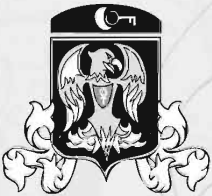
Willow-Mistt
has its own chapter. I'll go over it when I get to it.
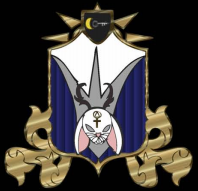
Trinity Stone
is NOT mentioned in the core, but it pops up on occasion in stuff connected to the game so I figured I'd mention it. The school is located somewhere in Texas and teaches students living in the Midwestern and Southwestern/Southern US. It was the setting of several of the failed Witch Girls movie projects (the kids in the "Beyond Convention" video that I linked to in the first post are wearing Trinity Stone uniforms) and Harris ran a WGA demo game set in it in Dallas. It was going to have its own supplement book, but again, it was never released. Its headmistress is Calypso Duexshae and one of its teachers is a giant talking armadillo.
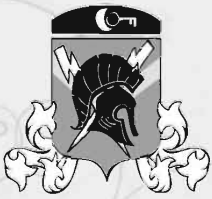
Despite there probably being more immortals than witches in the world,
Chiron Academy
is the only formal school for them. Also located in Crete, the school is run like a military academy and its 59 students are given a standard education alongside learning how to protect the helpless and fight monsters. (The blurb mentions that the students are only "mostly boys". It turns out that female immortals do exist. They are just outnumbered by the men 10 to 1.) Chiron was also supposed to be the subject of a supplement book that never came out.
Chiron's headmaster is Alexander of Macedonia, aka Alexander the Great, the same guy that almost killed Dracula. While he is strict, he also lets his students have leisure time and interact with witch schools. The immortal Thunderbird is one of the teachers, as is Robin Hood.
The next section is about mundane society and its various relationships with witches and the magical community. Most of the information is nothing new. Mundania is a boring, unimaginative place and a place to get away from the chaos of the magical world at the least, and an inferior place full of inferior beings that would be better off as slaves or dead at worst. Gothiques don't like it because it's full of close-minded goth haters, Rustics don't like it because cities kill nature, and Sorceresses don't like it because they don't get it. Despite this, most witches, including Sorceresses, still get into a relationship with a mundane at some point in their existence. (For Sorceresses with snooty families, this is always used to advance themselves socially.) When that happens and the witch tells them about what they are, the Office of Magistrates comes calling. The tests that Wardens give to mundanes to see if they can keep the secret can range from a quick talking to to physical and/or psychological torture to death/transformation into an animal depending on the Warden handling the case. The latter tends to be done by Highbinder wardens. Failure to pass the test, whatever it may be, causes the mundane's memory of the witch's confession to be erased.
A witch mother can be a great person for a character to go to, if they have one. They can do what moms do and talk about what they did when they were the witch's age and yadda yadda. This part also includes this delightful little line:
WGA posted:
On the other hand, wicked witch mothers may tell their daughters that the best way to gain a mortal's trust is through fear, and that's why she turns Dad inside out every time he talks back to her.
Fear does not make you trust people, you idiot. It makes you trust them even less.
I don't even want to think about how that witch managed to get married...
The mundane families of witches tend to either accept, fear, or deny the witch's nature. Fearful families either treat the witch like shit or let the witch rule over them. Deniers can be so good at keeping magic out of their life that they can cause a young witch to believe she's normal and will her powers away.
Family members and friends who know about the witch's secret are referred to as "cronies" Cronies will usually do anything to protect the witch and are often the target of her rivals.
Among other "mundanes-in-the-know" are witch-watchers and witch-hunters. The various organizations dedicated to these two pursuits are covered in the next section: Mundane Organizations.
Argus Society - A high tech group of about 500 witch watchers that has been around for hundreds of years. The society is dedicated to collecting information about witches and witch society. What do they plan to do with the information? Nothing. They're just collecting it for the sake of learning.
Brigadoon - Formed by a former Argus Society member, this group is just a more organized group of toadies. Naturally, most of them just get hurt or killed because a lot of witches find them annoying.
Malleus Maleficarum - Remember the picture from a few posts back with the witch hunters in puritan hats? That was these guys. The MM are witch hunters and are about the closest thing the setting has to a designated villain. This well trained, well armed, and well funded organization consists of mundanes who have been wronged by a witch or other supernatural (but mostly witches) in some way and want to take their revenge by killing every magical creature on the planet, including young witches. Potential members are approached regarding joining, and are "disposed of" if they refuse.
The "cyborg" part of them is that they have cold iron bone implants that give them some immunity to magic.
The MM's leader is Deacon Silas Black, a 500 some year old Irish immortal who believes that his powers came from God. He's got his own character sheet and bio in the next chapter.
Project Stormwall - A US based government organization that was formed during WWII to collaborate with the supernaturals during the war effort. But since everyone's memories of that time were erased, they now think everything supernatural has something to do with aliens and treats them accordingly.
Witchspiracy.com - A conspiracy theory website and group run by tabloid reporter Gary Reed. Reed and his fans/supporters believe that witches control every powerful organization in the world. The reason the witch community hasn't done something about him is because most people think he's an idiot.
Chapter's over! Time for a...
 HORRIBLE PICTURE ROUND-UP!
HORRIBLE PICTURE ROUND-UP!

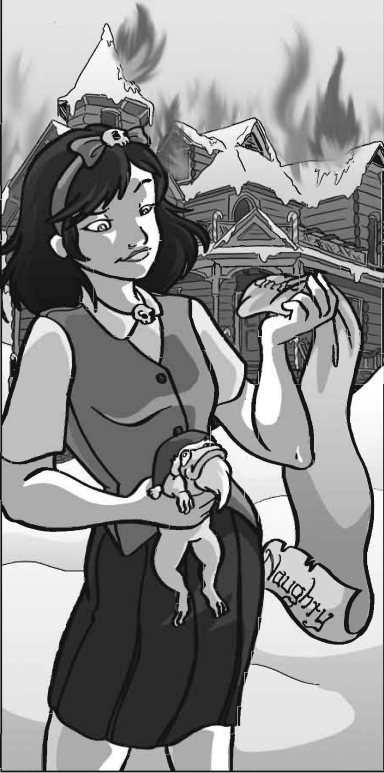
Fuck you, Lucinda. You deserve an entire dimension full of coal.

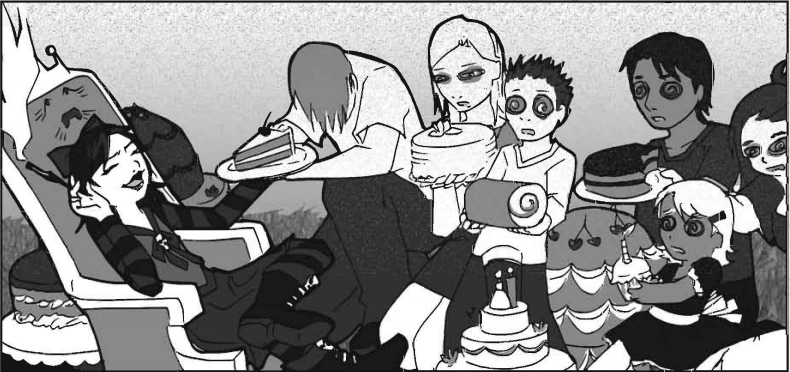
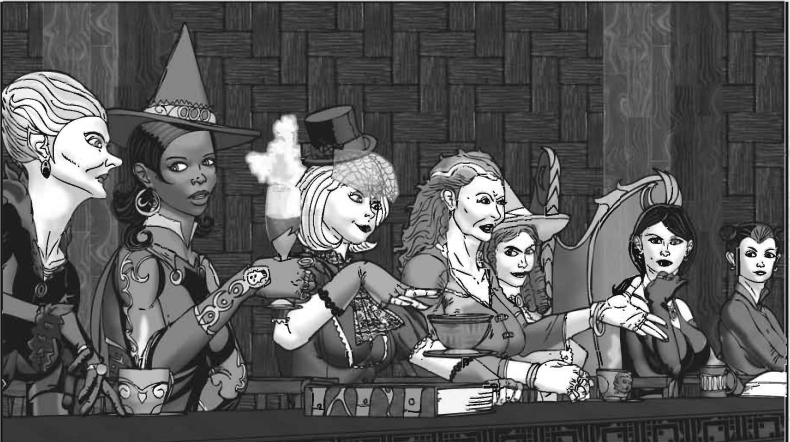
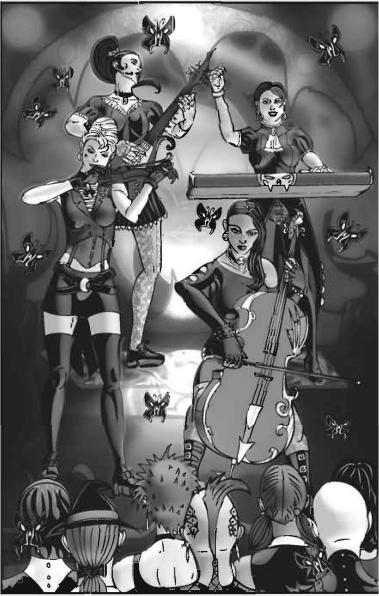
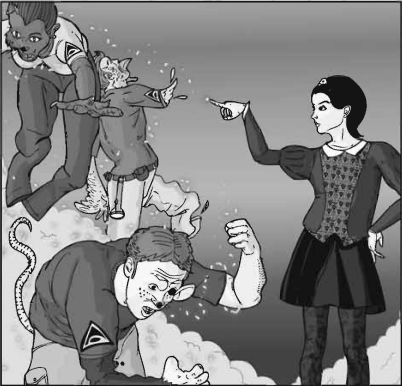
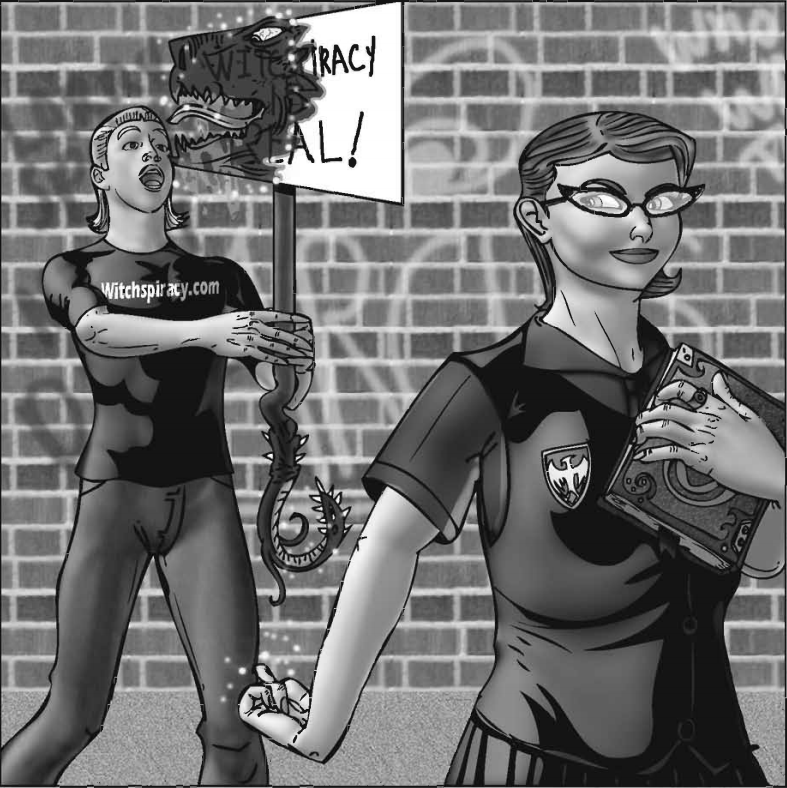
I have a hunch that that last picture was put together in a 3D poser program and then traced.
Up Next: NPCs
Humanoid NPCs
Original SA post
Witch Girls Adventures: Humanoid NPCs
Chapter 10 is mostly a giant list of generic and named NPCs and their sheets. NPCs are assigned a rank based on how powerful they are in relation to a starting character. This doesn't have any bearing on NPC creation should you choose to change the generic stats or make your own NPCs.
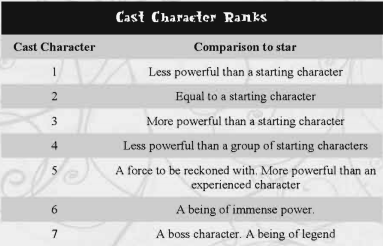
First up is a description of the different otherkin races or other "Descendants of Lilith" as the book calls them. The book also mentions that witches are the most numerous out of all of the descendants. So either Harris is really bad at math and thinks 50,000 is larger than 6,000,000, or there are a ton more magical monsters. Like witches, all otherkin and humans have 2 talents and 1 heritage.
First up is the Fae.
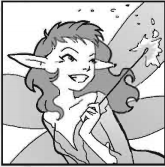
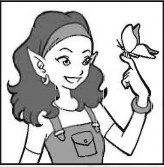
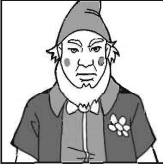
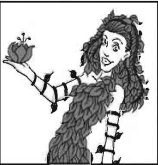
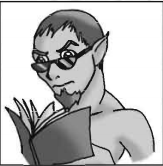
The fae are descended from Mab and Oberon, a "shape-changing prince from The Empire". The couple and their children used to live in Avalon, but they all abandoned it for Earth when Oberon and Mab moved to another dimension. The Fae can be divided into five groups: Fairies, High Fae, Gnomes, Nymphs, and Satyrs. The Satyrs and High Fae aren't mentioned in the intro paragraph, but there are generic sheets for them. All of the generic fae listed are Rank 2.
By the way, nearly all of the art in this chapter is terrible. It's either Soto's traces or someone's bad attempts at emulating a generic anime style with some competent art scattered about. Some of the pictures are so bad that you wouldn't be able to tell what they are of unless the book told you.
This picture is cool though.
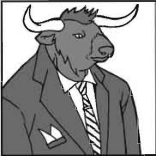
That is one dapper minotaur.
Anyway, fae can run the gamut from being awesome, if mischievous friends, to just as horrible as a witch when you piss them off. The fae don't seem to mind being treated as second class citizens by witches and have a "very good" relationship with them. All fae are immortal and immune to human diseases (but they have their own to make up for that), but they are vulnerable to and can't work their magic on iron and take double damage from weapons made from it.
Fae have three heritages that are exclusive to them: Half-Human, Seelie, and Unseelie. Half-Human grants the character a higher Body die type, makes them immune to iron, and increases their lifespan by 20 to 50 years, but they are mortal and can't use magic. Seelie, which are the "fairies of spring and summer" and are bright and cheerful to match, get a +1 die type bonus to all of their attributes during the spring and summer, can talk to plants and animals, and can change into an eagle, rabbit, or stag for 1 Zap, but they get +1 Reflex penalties during the fall and winter. Unseelie get the same bonuses except they get them during the fall and winter and turn into either a raven, a wolf, or a cat instead, and their -1 Reflex penalty happens during the spring and summer.
The first type, the fairy, is your basic tiny winged being with insect like wings. Their hair and skin can be pretty much any color out there and they tend to live in forests and glades away from humans, who they tend to be skittish around. They have a crap body stat, a slightly less crappy Will, average Mind, Senses, and Social, and are talented in Magic. Along with the prerequisite "Talents" and Heritage, they have three special abilities: They can fly up to 50 MPH when they're small, can spend 1 Zap to make themselves human size (which raises their Body to a D4), and can spend 1 Zap to automatically dodge any attack or spell. They all have a wand made of magically hardened dew and a mystery item that isn't mentioned because the sentence just ends at the word "and". The wand gives them a +1 bonus to Casting and witches can use it if they take it from a fairy while s/he is human size. Fairies get 4-5 ranks of magic to spend on either Alteration, Conjuration, Illusion, or Protection magic.
Just a quick thing about Abilities, they're basically a way to give extra bonuses and characteristics to NPCs that they can't normally get through regular character generation. A lot of the monsters have at least two. There's no rules for applying them or a list of them. You just make them up on the spot and tweak them to fit the NPC.
The gnomes in this game look like any other generic gnome: Short, fat, pointed ears. They love parties and drinking and, like fairies, live away from humans. They are also proficient in making magical items, which are highly sought after by the rest of the magical community. There are numerous gnome families, but the biggest ones are Leprechauns and "Recaps" (Red Caps), which are Seelie and Unseelie families, respectively. The generic gnome has average attributes except Will which is slightly crappy, gets 4 to 5 magic ranks to devote to either Conjuration, Divination, Illusion, or Time and Space, and along with its 2 "Talents" and Heritages, has three abilities: It can spend a Zap to turn invisible for an hour, spend a Zap to increase its walking speed by seven times, and gets a +2 bonus to rolls when playing games. Their hats, which a lot of them have, grant them +2 Zap, whether that's just on top of their normal pool or they regenerate it at that rate isn't really defined.
The High Fae are the type of fae that resemble humans the most and are the most likely to actually live among them. If your character has the Half-Otherkin (Fae) heritage, her fae parent is probably high fae. (There's no alternate characteristics for that heritage for each of the different fae.) They have almond shaped eyes, pointed ear, and really fucking love art. The generic high fae has average to talented attributes, 10 mundane and 6 magic skill points (they aren't automatically assigned like they are on the other fae sheets), and can spend 4 to 5 ranks on either Conjuration, Divination, Illusion, or Mentalism. For abilities, they can see through illusions and can turn into any human or animal for 1 Zap.
Nymphs come in two flavors: Tree and Water. Where they live depends on what type they are, naturally. Tree nymphs have green skin and hair while water nymphs have blue. They all have gold eyes. They're average in everything except Magic which they are talented at, and can only devote ranks to either Elementalism and Illusion magic. For abilities, all nymphs can speak to the animals that are in their domain, can spend a Zap to merge with either a tree or water, which makes them immune to attacks and can let them travel to another tree or body of water within a mile, and water nymphs can breathe underwater.
Satyrs are travelers and social creatures by nature, "traveling in small groups like gypsies or as companions of travelers". They love entertaining others with stories of their travels and stealing if they can get away with it. They look like what you would expect a satyr to look like. They're talented in Social and Magic and average in everything else, are very good at gardening, hiding, playing instruments, casting, and stealing (6 rank for the first two, 4 for the others), but they can only cast Mentalism spells up to rank 3, and they use their Instrument skill for casting rolls since they are required to play, sing, dance, or tell jokes to cast spells. Your guess is as good as mine as to why they have a 4 in Casting when they don't even use it. They can also speak any human and animal language, inflict +1 damage to attacks when they use their horns, and can jump 10 feet into the air because of their goat legs. Their reed flute gives them a +1 bonus for casting Mentalism spells and lowers the zap cost of spells by 1.
Up next is Immortals!
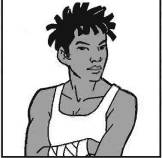
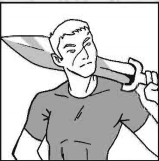
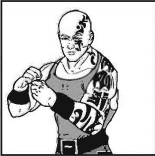
Immortals were put on this planet to bring order and stability and to protect others, and they will still protect people in their own messed up way even when they are "evil". Just like every goddess ever was a witch, pretty much every heroic figure ever was an immortal.
I mentioned this in my last post, but in case anyone missed it: FEMALE IMMORTALS DO EXIST, despite what the book may imply and what all the other places on the internet that talk about this game say. It's a very "blink and you'll miss it" kind of thing; tucked away and only mentioned in passing in the character sheets instead of in the front matter of this section like it should be. So I'm not surprised no one caught it.

Aside for the MM, immortals are made out to be the only other real threat to witches. They are stronger, faster, and more versed in combat strategies than most witches are. Witches on a whole think they're too serious and dumb. Immortals think witches are reckless and irresponsible with their powers.
Immortals look just like humans, except they are usually taller and more muscular. Despite being immortal, few live to be more than a couple of centuries old due to their violent lifestyle. They tend to favor archaic, usually gnome made weapons like swords instead of guns.
All immortals are immune to non-magical illnesses and poisons, and get a +2 bonus to resisting magical illnesses and poisons; regenerate 1 point of damage every round of combat or minute outside of combat; get an extra attack, move three times faster "than normal people" and have a +1 Reflex bonus; and can lift up to 1 ton. Instead of Casting, they have a skill called Power which... works the same way so the name change isn't really necessary, in my opinion. They cannot have points in the Casting (naturally), Spell Breaker ("Break Spell" here), Enchantment, and Potions magical skills.
Immortals have two new special skills: Legendary Strength and Tough Hide. Each rank in the skill gives them a +1 bonus to damage they deal from physical attacks and hand-based weapons and the amount of damage they ignore from attacks dealt to them. They also have a +1 bonus to their Body die, but it's not clear whether or not this is connected to these skills. A character can have up to 5 ranks in each skill, but the book says the average is 1 or 2. None of the generic sheets in this section list these skills or give pools for assigning them.
Immortals have seven heritages exclusive to them. These heritages represent what type of immortal they are and what type of magic they have access to. Each heritage is aligned with a different element. The ones for the four classical elements get access to Elementalism spells that involve their element only and have a -2 penalty to resist and dodge attacks of another element.
Atlasian - Earth, weak to Air.
Borian - Air, also like to explore and discover new things. Weak to Fire.
Promethean - Fire, tend to be hot tempered and passionate. Weak to Water.
Typhonian - Water, they tend to be mellow and laid back. Weak to Earth.
The other three are:
Iniquitous - Darkness, most of them are evil. They have access to Necromancy spells and have a -4 penalty to rolls involving doing anything "good or just".
Righteous - Holy/Light. They use Healing magic and have a -4 penalty to do things that are evil or mean.
Warlock - Magic. These guys have a much longer writeup than the others (if you count the paragraph on them that is, again, stuck amongst the generic sheets for no good reason and not put with the rest of their blurb). They're the rarest of the immortal types; estimates say that there are less than 20 of them alive. Why is this? Well for one, they don't have Legendary Strength or Tough Hide and their Body die is 2 types lower than "the average immortal". For two, they can steal magic from witches! A lot of witches are so distrusting of them because of this fact that they have no problem killing warlocks as soon as they are born so they don't cause trouble later.
So as Alien Rope Burn pointed out, many witches literally do want to kill children and be saints.
When a warlock touches a witch, a Contested Magic roll takes place. If the warlock wins, they take a number of magic ranks equal to the difference between the two rolls and get to keep them for a day. This is limited by the maximum roll of their Magic die and the number of ranks the witch has. They can also absorb spells cast on them and use them themselves by spending the amount of Zap needed to cast the spell. They can use magical items like wands and can put points into any magical skill.
The book has generic sheets for Young (21 and under), Adult (21 to a couple centuries old), and Ancient (over a couple centuries) Immortals. Young immortals have average to talented attributes. They get 12 mundane skill points and 6 magical skill points, and usually have 1 to 2 ranks in whatever magic skill their heritage uses. They are a Rank 2 NPC.
Adult immortals are Rank 4 NPCs. They have attributes ranging from D8s to D12s. They get 40 mundane skill points and 15 magic points and usually have around 6 ranks in whatever magic they use.
Ancient immortals are Rank 6. They have D10s and D12s for attributes with one D12+4 for Magic. They get 60 mundane skill points and 20 magic points. They have two abilities: They can spend one Zap to initiate a Contested Will roll to make a target do whatever they say provided it won't hurt them or someone they love, and they can coat themselves in a gray, stone like shell and hibernate for centuries at a time. Sometimes, an immortal can become or choose to become amnesic from this long sleep. This is a plot point for a named NPC's background so I wouldn't be surprised if that bit was tacked on so it wouldn't seem out of place.
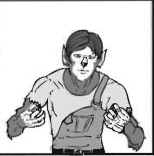

Shapeshifters come in three types, which is reflected by their three heritages: Moon Blooded, Infected, and Cursed. Moon blooded shapeshifters are descended from Echidna and were born shapeshifters, as their name implies. Infected shapeshifters got their abilities by being bitten by another Infected and generally aren't treated well by the other types. Cursed shapeshifters got their abilities due to witches cursing either them or one of their ancestors. Shapeshifters tend to be distrusting of anyone outside of their pack and tend to live in wilderness areas away from humans. Groups of shapeshifters also tend to band together, so if one group hates you, the others will hear about it and hate you too. Witches and shapeshifters tend to avoid each other as they are resistant to Alteration magic and Cursed shapeshifters are usually bitter about their condition and wouldn't mind killing a witch or two.
As a base, shapeshifters have a +5 bonus to resist malicious Alteration spells and any spells that do succeed only do half damage and only last for half of the time it normally would; heal at a rate of 1 point per scene/hour; and have a +2 bonus to resist poisons and diseases. During a full moon, they get a +2 to every roll, but must make a contested roll to not lash out at everything or to assume their human form for a minute. They also take double damage from silver weapons. Each heritage tweaks these abilities.
There are all sorts of shapeshifters, but the most common ones and the only ones that have stats listed for them are werewolves, werecats, and wereravens. All shapeshifters have three forms: Human, Animal, and Hybrid. In the animal forms, which they can usually assume at will, they have the same stats as the animal they turn into, except for all of the attribute stats other than Body, which stay the same. There is a large chart of animal stats near the back of the chapter.
In Hybrid form, all three types of werecreatures gain a +1 Body die bonus. Werewolves have a +3 modifier to causing damage, their Senses die goes up by one type, and they gain 1 rank of Tough Hide and 1 to 3 ranks of Legendary Strength. Werecats get +2 to "leaping, climbing, landing, hearing, and sight rolls", +2 Reflex, +2 to damage for claw attacks, and can see in the dark. Wereravens get +2 to sight and "urchin" based rolls and to damage from claw attacks with their feet, and +1 Reflex.
Cursed werecreatures look more human in their hybrid forms, have +1 to Resist Magic (because they're already under a powerful spell), and can use Legendary Strength and Tough Hide in their human forms. (That wasn't a very smart move on the part of the witch who came up with that spell. I thought all witches were smart.) They don't get bonuses during the monthly full moon rampage and need to spend 3 zap to turn into their animal form. Infected don't have any advantages other than the ability to make more of themselves, which isn't an advantage at all depending on your outlook, they can't become human during the full moon, and they don't get the bonus for resisting disease and poisons. Moon Blooded don't have any negative effects during full moons, but they have to spend 2 zap to shift to their human or animal forms.
Young shapeshifters have average to below average attributes, only get 10 skills points, 8 for mundane, 2 for magic. They are a Rank 2 NPC. Adult shapeshifters are Rank 3, have average to talented attributes, and have 22 skill points, 16 for mundane, 6 for magic.
More later.
More Humanoid NPCs
Original SA post
I started reading through
Eternal Hearts
(the
Vampire: The Masquerade
"erotica" novel) to see if it would be a good candidate for a writeup. I'm up to Chapter 7 (out of 27) and so far I've read three rape scenes (and I know there's at least one more), read about a vampire who keeps his keys on his junk for no good reason, seen two pictures of Lucita of Aragon running around without a shirt, bra, and panties... for no good reason, and seen a full frontal nude of Sascha Vykos.
Damn
White Wolf...
Anyway...

Witch Girls Adventures: More Humanoid NPCs
The last group of otherkin are vampires.

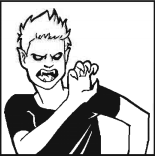
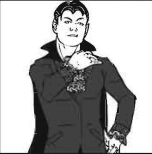
The book tries its hardest to convince the reader that vampires are complete assholes, but considering the stuff witches do, these guys are pretty tame. Vampires, the other descendants of Echidna, are described as being very egotistical and self-serving and only keep "friends" for as long as they need them to accomplish a goal. Vampires have their own feudal style society known as the Vampire Confederacy/Confederation where each part of the world is ruled by a king or queen who have lords who serve them who in turn have serfs and blah blah it's similar to
True Blood
.
WGA vampires are not really dead. They can eat normal food and sleep and have children. Drinking blood allows them to feel more alive, giving them a normal looking complexion, a normal body temperature, a normal sense of taste and tough. The book implies that they don't actually get the urge to drink it in one part, then does in the next, but does acknowledge that it is habit-forming. Only ancient vampires appear to have the ability to turn people into vampires (they drain them of blood and leave them alone for a few days). All vampires have pale skin, pointed ears, and red eyes.
Vampires get a +1 Body die bonus during the night, get an extra attack at the end of combat rounds, +1 Reflex, move 3 times faster than "normal people", have Legendary Strength and Tough Hide (average rank is 1 and they can have up to 3), can perform a bite attack for 3 to 6 points of damage depending on their age and can heal D6 points of damage by stealing that amount of zap from the victim. While they're immortal and aren't affected by mundane diseases like pretty every other magical being in this universe, they don't heal naturally and have to spend Zap (1 for 1) to do it. They also take a point of damage for every minute they are in direct sunlight, have a -2 to all rolls and their Reflex attribute during the day due to feeling sluggish, and have -2 to resist Necromancy spells cast by witches. They cannot put points in the Casting, Spell Breaker, Enchantment, and Potions skills.
Vampires have five unique heritages.
Hunters
- Gangrel. These guys prefer to live in the woods and stay out of the political BS that goes on in vampire society. They get +2 to Senses rolls and damage done by claw attacks and can turn into a wolf for 1 zap. Their Mind die is one type lower and they get a -2 to all rolls when they are in an urban area.
Imperial
- Ventrue/Daeva. The beautiful, charismatic lords of vampire society. They get +1 to Social rolls and can turn into a bat for 1 zap. On the downside, they are the only ones who are weak to all of the usual vampire weaknesses. They can't come into a room without being invited, they have to sleep in a coffin with dirt from their homeland, and a wooden stake to the heart does half of their life in damage, but honestly, that would seriously hurt anyone.
Peons
- The most numerous type and the ones who usually fill the serf positions in vampire society. They have no advantages or disadvantages.
Shades
- Dhampir. Shades have a normal sense of touch and taste, are not weak to Necromancy spells, and only get one point of damage per hour in direct sunlight. However, they are not immune to illnesses and poisons and don't get any bonuses at night.
Underborn
- Nosferatu/Mekhet. These guy are hairless, hunched over, have beady eyes, and have to live underground because other vampires don't like them because they're ugly. They get +2 to smell based Senses rolls, can see in total darkness, and can spend a zap to either turn into a rat or change their shadow, which includes using it to conceal themselves. They get a -4 to all rolls when above ground and take double damage in direct sunlight.
Young vampires are Rank 2, have below average to average stats, and get 15 mundane and 4 magic skill points. Adult vampires are Rank 4, have average to extraordinary stats, and get a 40/15 skill point spread. Ancient vampires are Rank 5, have talented to superior stats, and get 60/20 skill points. Ancient vampires can also learn Elementalism and Necromancy spells up to 4 ranks (the Casting skill restriction doesn't apply to them), are immune to Mentalism and Necromancy spells, and hypnotize a person for up to a day if they beat them in a Contested Will roll.
Up next are generic sheets for NPC witches.
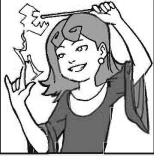

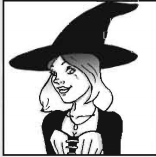
This section is mostly a list of NPC exclusive heritages and optional magic templates for various types of witches. (NPCs can also have heritages from the PC list.) For the heritages, we have...
Godmother
- Someone who likes to use their magic to help others. This isn't restricted to members of the Godmother's Guild. Helpful spells are treated as being one rank higher when it comes to duration, range, and target size, can fly up to 50 MPH for 1 zap, and has a mundane avoidance charm (-2 to rolls when she's not helping someone). She has a -2 to cast spells that aren't helpful, and casting spells around people who don't believe in magic cost an extra zap and have a -1 roll penalty.
House Witch
- Someone who is good at concealing their magic from mundanes. Mundanes have a -4 to figure out that she's a witch or to see her casting spells, but her casting rolls always have a -2 penalty.
Follower of Echidna
- Wants to wake up Echidna. Rolls to be mean and destructive get a +2 bonus, as do Social rolls for dealing with monsters or mundanes, and evil spells are treated as being a rank higher. They have a -2 to dealing with "good people" and the same penalty for casting benevolent spells.
Magic Chaser
- Good at finding witches and magical beings. They can find out information from and track a witch by their magic, but they have a -1 to all of their rolls and -2 to Reflex when doing so.
The witch types list is just a cheat sheet for people who don't want to spend too much time figuring out what types of magic an NPC can use. The blurb also says that they list attributes for each type. They don't. I'm not going to bother going through all of them, but I will point out that "Wicked" witches do have Alteration, as do "Hex Girls", who are kind of crazy.
WGA posted:
A Hex-girl is a witch who uses her magic to have fun, to get what she wants, and to make life a bit more magical for all. A Hex-girl is almost always the life of the party but can be occasionally cruel to people not willing to have fun.
Party or die!
NPC witch girls are Rank 2, have below average, average, and talented attributes, a 10/10 skill point spread, and 6 to 7 magic ranks. Adult witches are Rank 4, have average to superior attributes with a D12+2 for Magic, a 40/40 skill spread, and 12 magic ranks. Ancient witches are Rank 6, have average to superior attributes with a D12+5 Magic die, 60/60 skills, and 20 magic ranks. The generic sheet also has a permanent Ward ability, which gives her +1 Resist Magic and ignores 2 points of damage. Their blurb also mentions that they are better at playing politics and creating evil plots than the oldest vampires are.
Humans...
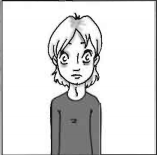

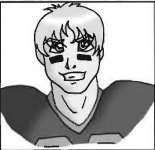
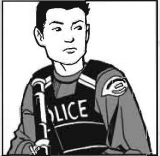




Humans suck, are weak, and have no natural magical powers whatsoever. Most are Rank 1 NPCs regardless of their age. Mundanes still have a Magic die to calculate Resist Magic and, for some reason, also have a Zap pool despite not having anything to spend it on. Adults have lower ones than children because they are less likely to believe in magic.
The blurb for humans also tries to make them out as the bad guys.
WGA posted:
Humans are the dominant life from on the planet (or so they like to think). 99.99999% of them have no idea there is anything magical going on in the world. In fact, most mundanes, when confronted with the supernatural, are so unwilling to accept it that their minds will not even let them see it.
Those who know what's going on form two camps: those who accept it and try to either live with it or avoid it and those who rage against it. Those that rage become bigoted and prejudiced towards mystical peoples and creatures. They try to make themselves feel better by treating those born with special abilities as oddities and freaks.
Some, however, become totally consumed in that rage and hunt special people. They do it for sport, they do it for a past wrong, or they do it because they think mankind needs protecting.
And every last one of them is justified in doing so. Again with the oppressed minority/"they're just jealous because you're special" bullshit... There has been almost nothing in this book that convinces the reader that witches are the ones who are the victims. Only the exact opposite. It's like a CEO treating his workers like shit and then getting mad when they go on strike.
Both child and adult mundanes have below average to average attributes and get 10 and 15 mundane skill points respectively. Along with regular mundanes there are "exceptional" ones, who usually have advanced training or greater physical prowess. The examples given are doctors, firemen, and policemen. They are Rank 2, have below average to talented attributes, and get 15 skill points for kids and 30 for adults.
Finally, we have witch hunters.
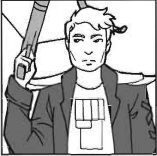
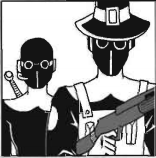
There are two types of hunters: Freelancers and the Malleus Maleficarum. Some freelancers will make exceptions for "good" witches and witch girls, but the MM don't. Freelancers also pretty much suck and most of the witches that they claim to have killed were just fae or "an oddly attired human".
To make up for their lack of magic, hunters have a list of equipment and training skills that they can choose from. Freelancers get 1 to 2 training abilities and 2 to 3 pieces of equipment along with a mode of transportation while MM members get 2 to 4 training and 4 to 6 equipment on top of the iron implants that I mentioned earlier.
By the way, there is no mention anywhere in the book of witches having a weakness to iron or iron being a magic negating element for anyone other than the fae. So there's really no reason for the MM's iron implants to work at all, but they do. That's what happens when you don't proofread your work.
The equipment list is mostly just standard weapons and other things like night vision goggles and goggles that can "detect alpha waves given off by magical people and items", as well as headbands that give a -10 to witches wearing them when they try to cast spells. Training gives hunters abilities like poison resistance, the ability to detect a magical person on sight, immunity to mind altering spells as well as avoidance charms, special martial arts moves used to stun targets, and bonuses for working in a group.
Freelancers are Rank 3, have average to superior attributes and get 30 mundane skill points and an automatic 3 ranks in Mysticism. MM soldiers are Rank 4, also have average to superior attributes, and get a Mysticism rank of 5 on top of their 30 points.
Monster lists and named NPCs later.
Bestiary
Original SA post
Witch Girls Adventures: Bestiary
Monsters in WGA are considered to be magical beings that "don't truly socialize outside of their own kind or with anyone at all". Some are intelligent and, in my opinion, should be lumped in with one of the otherkin races, some aren't. Most can't use magic either, so it's kind of a catch-all for anything that isn't a human or normal animal and doesn't like anyone else bothering it.
This section starts off by explaining the differences between summoning (which only works on monsters who are "not busy" or serving somebody else) and conjuring monsters. Elementalism, Necromancy, and Time and Space spells can all be used to summon monsters, with each dealing with a different type of monster and the natural habitat that they come from. (Time and Space is used for things from other dimensions.) After that is a short blurb about Cryptozoology rolls and what difficulty provides what information. (Random facts are Easy. Society and history facts are Very Hard. Weaknesses are Extreme.) Each monster listing in the bestiary also provides three Cryptozoology facts about it for those rolls on top of the basic rundown under the sheets.
The monsters are divided up into sections by rank. All the usual generic fantasy suspects are here. I only included the pictures that I thought were funny, bad, or needed to clarify what the monster looks like. For Rank 1 we have...
Goblins - Goblins are Unseelie fae. Why they're not lumped in with the other fae is beyond me. They live in the forest and are criminals who like to steal shit. They're also cowards and scream like little girls according to their Crypto facts. They have mostly below average attributes, are very flexible which gives them a damage and small climbing bonus, and can change into a human for one hour.
Sasquatch - Big hairy men. Nobody knows where they came from or what they're all about, but most incorrectly assume that they're descendants of Echidna. These guys are pretty friendly and can be found in mostly North America. They have below average to talented attributes, get +4 to Body rolls for their strength, can blend into their surroundings, and get +2 damage for teeth and claw attacks.
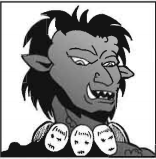
Troglodytes - These guys are 6 foot tall humanoids with tusks who live in shit-filled caves worldwide. They're related to trolls and Echidna. They're resistant to magic (+2 Resist Magic) and weak to fire (double damage).
Zombies - The internet fucking loves zombies, so I imagine you know what one is. Naturally, they only eat brains and do utter that word frequently. A group of them is called a "Crypt" and they have a "magical sense of sight" that makes up for their often lack of physical eyes. They have a bunch of D2s for attributes and are immune to Mentalism magic.
For Rank 2, we have...
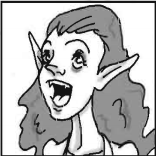
Banshees - Banshees are fae who joined up with Echidna. Again, why they're not lumped in with them is beyond me. They are the most common from of "Hate", a creature changed by Echidna to be evil and serve her. Because they're evil, they're ugly, pale, and have dry skin. For some reason, they must cause pain and misery to everyone they meet or they will die. The various "lady in white" urban legends are actually about them, and they are often mistaken for witches. They usually take advantage of this and try to ruin the reputations of witches, because we all know how good-natured and forgiving witches normally are and they're clearly just jealous...
 They have mostly average and talented attributes, know some basic magic (Elementalism 1, Mentalism 2) and can cast it by singing, and are vulnerable to "good" and healing spells, which cause damage to them. They also have their trademark scream, which does 8 points of damage.
They have mostly average and talented attributes, know some basic magic (Elementalism 1, Mentalism 2) and can cast it by singing, and are vulnerable to "good" and healing spells, which cause damage to them. They also have their trademark scream, which does 8 points of damage.
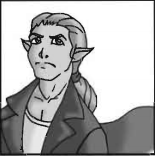
Centaurs - Centaurs are the creation of witches. Back when Echidna was still around, a bunch of witches turned some normal horses into these guys to help them fight her, but they've since gone off and formed their own communities. They love music and hate humans and anyone else who smells like a horse because that means they're enslaving their normal horse brethren. Chiron Academy is named after a centaur who trained a lot of immortals, and both groups are on good terms with each other. They have average attributes and can speak with normal horses "and their kin".
Flying Monkeys - Yes, these guys are in the game. They were also created by witches and there are actually witches who breed them. The only things they care about are serving their witch masters and whether or not you tried to give them a banana. (They're carnivores and "will try to eat anyone who attempts to feed them a banana".) They have below average and talented attributes, can call other flying monkeys with a howl, and can serve as the eyes and ears of the witch they serve.
Ghost - Usually invisible, they can manifest themselves as transparent versions of what they looked like when they died. Every ghost has an item that ties them to this plane of existence, and destroying that item will destroy the ghost. They are immune to all types of magic except Necromany and Mentalism (and Healing, but it's only mentioned that it can be used to make them "cross over") and when not manifested, physical attacks. When manifested, physical attacks only do half damage. Reducing a ghost down to 0 HP only makes them disappear for a day. They can't leave an area they are haunting and they can't see electronic images. They have below average to talented attributes and have any skills they had when they died, provided it's within the 10 mundane/Mysticism 4, Casting 4 restrictions.
Griffins/Hippogriffs - These guys are lumped together because they are the same species. They are close to becoming extinct, but witches and otherkin don't give a shit about that and still try to keep them as pets, which can kill them because they don't do well in captivity. A baby one is called a Mervyn. They have mostly D4s for attributes, can fly up to 100 MPH, and get +1 to rolls for strength based tasks.
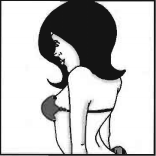
Merfolk - Merfolk live in communities in both fresh and saltwater, with the biggest being around Mu and the Atlantis Rift. Their skin, hair, and eye colors run within the cool color spectrum and their bottom halves are usually fish tails, though eel tails and octopus limbs aren't unheard of. There are rumors that merfolk with marine mammal (dolphin, killer whale, etc.) tails and the ability to breathe air may exist as well. They have a lot of trust issues and have been known to attack humans for no reason. Fresh and salt merfolk don't get along either. They have average to talented attributes, can talk to fish, and can turn into a sea creature. While merfolk on a whole can't use magic, some are descended from Atlantian witches. (Witches being witches, I'm sure they've found some way around the Mermaid Problem.) These merfolk get higher Magic dies and 6 ranks to divide up into spell types, as well as a Casting of 4 at the least.
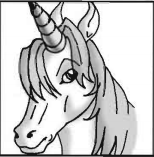
Unicorns , like Griffins and Hippogriffs, are also close to becoming extinct. Once again, witches don't give a shit and will try to keep them as pets and, as I pointed out a few posts back, regular beasts of burden. The book also points out that, while it is frowned upon, owning a unicorn as a pet is not illegal, and that their horns were a common material for wand-making. (They still are. Unicorn horns are on the materials list in the custom wand section.) Unicorns are beings of pure good, so much so that attacks with their horns will not harm a "good" person, any benevolent spells cast in their presence cost no Zap, and anyone near it gets +4 Resist Magic against malevolent spells. They have average to talented attributes and have two ranks of Healing magic.
Rank 3 monsters include:
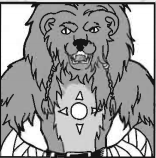
Guardians - Guardians are spirits of protection and, as I mentioned earlier, look like someone's fursona. Their style of dress and mannerisms depend on the human culture that they are emulating and the person summoning them. The book mentions that some witches will summon guardians who look like cutesy anime mascots or "even ninja turtles". They have average to superior attributes, but their abilities vary by what type of animal they are.
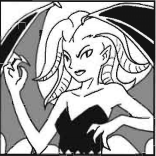
Harpies - Harpies are what you get when witches join up with Echidna. The first ones came from Sicily, they smell bad, and they eat humanoids of all types. They have below average to talented attributes, can scream damaging sonic waves, and get 3 to 6 magic ranks, but are capped at 3 for every single type.
By the way, the blurb states that they have feathers for hair. Those don't look like feathers to me.
Imaginaries - As stated before, imaginaries are the imaginary friends of children, only better and actually alive because a magical child thought them up. They are part of the same class of creatures as guardians, which are called Numina. Unlike other monsters, they get a pool of die types and skill points instead of having these things already assigned and the damage from their attacks depends on their form. However, all imaginaries are immune to non magical attacks and can eat the imaginations of children, draining them of zap.
Minotaurs - Minotaurs love puzzles and mazes, value physical strength over everything else, and hate magic and technology... because. (If that picture I posted earlier is any indication, they seem to be fine with our clothes making technologies.) They get along well with Immortals. Nearly all female minotaurs have white fur. They have below average attributes save for their Body and Magic dies, get +2 to Body rolls and damage done from physical attacks, have excellent direction sense, and ignore 2 points of damage.
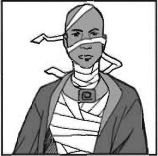
Mummies - Mummies are what you get when you put a witch or anyone else who is an expert in potions in charge of a burial and the person being buried really really wants to come back. Mummies were buried during times of "great magical power" and in places with a lot of magical energy. Though they are usually summoned by some idiot using Necromancy, a lot simply rise at random. No one knows how to make them anymore. Witch mummies do exist, but none of them have come back from the dead. Most come from Egypt, but bog mummies from other parts of the world are also common. They have average to talented attributes, are immune to Mentalism, Illusion, and Elementalism spells, can create zombie slaves for 3 zap, and can turn into either sand or bugs depending on the type of mummy they are.
Trolls - Trolls are big, stupid, cowardly bullies who hate technology. There are two types: Scandinavian trolls, who are big, green, and warty, and Bridge trolls, who are hairy, tan, have tusks, and probably live under bridges. All trolls can turn into stone. They're part of the Ogre family of creatures along with troglodytes and are called "oni" in Japan. (And no, the game doesn't try to be cute and include cyber spirit ones.) They have a D2 for Social, and their other attributes range from below average to talented. They have a +2 to Resist Magic, can regrow limbs and regenerate health, and have a +2 to Body rolls.
Rank 4 monsters include:
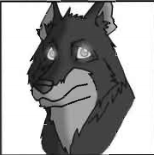
Animal Paragon - Regular animals, only bigger, "totally perfect and groomed", and magical. They are to normal animals what witches are to humans. They're rare in the normal world, but make up a quarter of all the animals in the magical world, and regardless of which world they're in, they tend to rule over the lesser specimens of their kind. They have their own government called the Congress of the Beasts. Lion and tigers are at war with each other, and the white rabbit from Alice in Wonderland was probably a paragon, since it mentions that following them down their holes isn't a good idea. Though I imagine sticking your head down an animal hole isn't a good idea regardless of where you live. Paragons have improved versions of the generic animal sheets and have Elementalism 2, can speak "all languages", can command regular animals to do their bidding, can turn into a human, and get a +2 to Resist Magic.
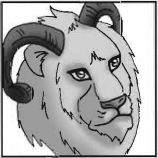
Chimera - The chimera is a catch-all term for several similar creations of Echidna that were made from the various parts of other animals. They spend most of their time sleeping. When they wake up, they instinctively kill and eat everything they come across, and then go back to sleep once they're full. They can breathe magical fire (10 to 15 damage with a 100 foot max range), which can only be put out by magic or "enchanted earth". No water, just magic and magical dirt. They have a D12 Body and the rest of their attributes range from talented to crap. They have +1 Resist Magic, have an extra attack and are "nearly impossible" to surprise due to their multiple heads, and have a poisonous bite that forces anyone who fails a Hard Body roll to lose one Body die type every D6 days.
Lesser Giant - Wussy, common giants who are only 12-15 feet tall. They live in small tribes in mountain areas or caves and live as herders. Cyclops are considered to be giants and live in Greece and Ireland. Other beings like to use them as soldiers. Some people think that giants might be distant relatives of humans. Giants hate immortals because an immortal named Jack spent his entire life hunting them. They're dumb as bricks (D2), making them immune to Mentalism magic, have below average to D12 attributes for everything else, get +2 to strength related rolls, and ignore 4 non magical and 2 magical points of damage.
Wraith - Ghosts: Echidna Edition. They work pretty much the same way as ghosts except that they have set attributes (a bunch of D6s and one D8 for Magic) and skills, they can travel wherever they please assuming there's no lines or circles of salt on the ground, they can eat souls (by draining health), and have to appear if you say their full name three times. They can only see people by their souls, and animals can see them when they're not manifested. Wraiths can only be created, and doing so is illegal under the WWC's nebulous laws.
For Rank 5, we have...
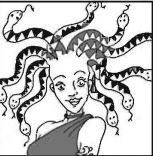
Gorgons - Gorgons are witches who were cursed by Echidna and forced into serving her. Most of them are evil, but some aren't. The nicer ones live as outcasts in magical society and are required by witch law to wear polarized sunglasses or contact lenses, regardless of whether or not they have control over their petrifying abilities. It is illegal to turn someone into a gorgon. They're very vain and jealous of witches for their beauty. They also have special wands made out of petrified snakes from their hair which are highly sought after by witches. The wands lower the zap cost of spells by two, store 5 regenerative zap points, and can turn objects or peoples' "limbs or head" into a snake or multiple snakes with a touch. Gorgons have D8 to D12 attributes, a 20/20 skill point spread, and 12 ranks of magic with a cap of 4 for every type. They can only be killed by decapitation (otherwise they just come back to life a day later) and their snake hair keeps them from being surprised and allows them to life things. They can also create the illusion of having normal hair, but anyone with some ranks in Illusion could probably do the same.
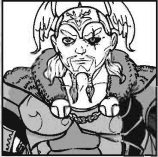
Greater Giant - Giants that are not dumb as fuck, bigger (20 to 25 feet), and more badass. They look and dress like vikings and live in kingdoms in thunderheads that are invisible to humans. Their wars with each other are the cause of thunderstorms in the normal and magical world. They are also known for coming down from the clouds in flying viking ships and raiding magical towns. Giantesses are "rubenesque" and known for having really really long hair. They have D12+2 Body and mostly average attributes, have +3 to strength rolls, are immune to Mentalism and have +4 to Resist Magic, and can fire lightning bolts for 3 zap. They have -5 Reflex when they're not flying... even though there's no mention of them having that ability anywhere in the book. Giantess witches also exist, but are rare. They get Casting 6 and 6 to 10 magic ranks with a cap of 4. Some male giants also have the ability to turn into any animal.
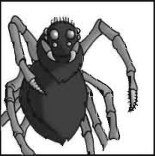
Magivore - A horse-sized, white spider with 6 foot long pincers that can steal magic ranks from witches (which they use to feed their young). Echidna created them, and owning one is illegal under witch law. However, the WWC likes to construct bindings using their web, as it has magic negating qualities. Their magic draining ability is the cause of writer's/artist's blocks in humans... even though it's been said that humans don't have magic. They have D4s, D8s, and D10s for attributes, have a natural avoidance charm cast on them, can instantly teleport to things it is tracking, can absorb spells cast on it like Warlocks can, has +3 to Resist Magic, and is immune to two types of magic of the GM's choice.
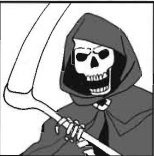
Reaper -
WGA posted:
Every one fears the Reaper.
Seasons don't.

Reapers are upgraded versions of wraiths. The skull head that they have is actually their target's skull, which appears when they have targeted someone. The rest of the time it's just a dark void with the screams of the reaped emanating from it. Without Echidna to order them around, these guys just roam around reaping (i.e. turning people into ghosts) for no reason. They don't like other Necromancy users because they think that's their domain. They cannot be reasoned with. They have D6s and D12s for attributes, have 2 to 5 ranks of Necromancy, can disappear and manifest like ghosts, and cannot be seen by non magical people.
There are only two entries under Rank 6.
Dragons - Dragons are the oldest intelligent creatures on Earth and related to the dinosaurs. They are solitary creatures who can be found pretty much everywhere, including large cities. ("See that bridge over there? It's a blended dragon that has been asleep for decades.") Back during the war with Echidna, they either sided with her or remained neutral. Because of this, immortals did one of the few assholish things they've ever done as a race and hunted them into endangered status. They look like what you would expect a generic dragon to look like. They have a D20 Body and D10s and 12s for attributes, can regenerate a point of health every scene, shoot fire out of their mouths, get +5 to damage, are immune to Elementalism magic and have +2 Resist Magic, ignore 5 points of damage, can smell magic, and have -10 Reflex when they're not flying.
And no, they don't have the ability to turn into a human. Remember: The oldest witch in the world is half-dragon.
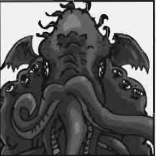
Horror - Cthulhu with a generic name. Creatures of pure chaos and destruction, some people speculate that they were formed from Echidna's nightmares and feelings of rage from being imprisoned, while others think that they existed before she was imprisoned and just fed on her hate. They're big, ugly, and anyone who hears them talk within a 100 yards goes insane. In the real world, they look like slightly smaller "partly aquatic humanoids", which I assume is a reference to the Innsmouth Look. Some think that there is only one horror and that all of the others are just extensions of it. They can also enter the real world if someone teleports to the same place one too many times, since that weakens reality. Despite being hated by everyone who is not a follower of Echidna, humans have discovered and formed small cults around them. Lovecraft, according to the book, was one of those cultists. Horrors have D20 Body, D4 Mind, and a bunch of D10s and D12s for attributes, are immune to Alteration, Mentalism, and Time and Space magic, and all other magic only does half damage, can hop between dimensions for one zap, have +4 damage due to their tentacles, and -10 Reflex.
Next post: Transformation rules and named NPCs.
Transformation Rules & Named NPCs
Original SA post
Witch Girls Adventures: Transformation Rules & Named NPCs
The next part of the chapter is rules regarding what happens when somebody gets turned into an animal, which is apparently unavoidable in this game even if you try to cut down on that sort of thing.
WGA posted:
Witches will at one point either turn into an animal or turn someone else into an animal.
The transformee gains the Body and Senses attributes of the animal in question while their other attributes stay the same. There is a chart listing stats for a bunch of different animals, but it takes up an entire page so I'm not going to post it here. It's a lot of D1s to D4s, with a bunch of D6s and 8s for Senses, and a bunch of varying die types for Body based on the size of the animal. (Blue Whales have a D20+2 Body.)
Willing transformees can speak and understand both their human language and the animal's language and can transform back on their own. Witches can cast any spell that they know that doesn't require a wand. Unwilling transformees cannot speak their human language to anyone that isn't magical, and after 24 hours think they are that animal and have the animal's normal attributes to match, but they also somehow still know that they used to be human. "That is just part of the tragedy of being transformed."
There's some other stuff in this section too, but most of it apart from the end of a sentence is cut off.

Ending the chapter is sheets and bios for 10 NPCs that aren't related to the Willow-Mistt school, along with very simplistic, no-brainer plot hooks for people who want to use them in their games. Starting off the list, we have...
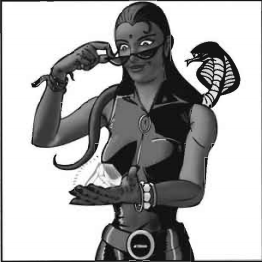
Anna Raj
Anna is an infamous witch thief. She was born in India and belonged to one of the few native families that thrived under British rule... despite the fact that she was born in 1603, 154 years before the British East India Company would have control over the Indian subcontinent. (Her bio says she's 406 years old. This is all assuming that you count backwards from 2009, the year the game was published.) Despite her heritage and being born in the wrong time frame, she was raised to be a proper English lady. At 17, she rebelled and traveled to the other English colonies before meeting up with some pirates in the Caribbean who took her in, "despite pirate tradition against women being on ships". Eventually, she became the captain of a ship called The Indian Star. After piracy fell out of fashion, she returned to India and became a thief. She prefers to use her physical skills instead of her magic when conducting heists, doesn't like hurting people if she doesn't have to, and pretty much just does it for the thrill of the hunt. She is well liked by both her friends and foes.
Anna is a Rank 4 NPC. Unlike PCs, NPC witches don't have signature spells. Signature spells are replaced by one or more special abilities that sometimes PCs would never be able to have and occasionally break the game's rules to make them more special. Anna is an example of this, as she can turn herself into a small or giant black cobra at will despite only having Alteration 1. She has the Urchin and Friendly talents and The Sight heritage, has an average Body with D8 to D12+2 (for Magic) attributes, 21 ranks of magic, with her best types being Illusion, Mentalism, and Protection. She owns a magical car that can shrink down to the size of a Hot Wheels style toy car and a small pouch of "naga powder", which if blown turns into a bunch of tiny non-poisonous snakes that can be used as ropes. Like so.
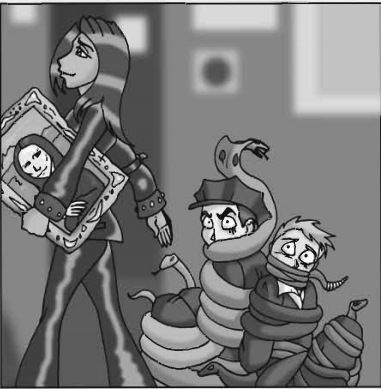
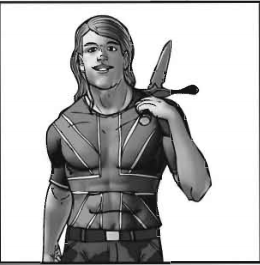
Arthur Pendragon
The 16 year old once and future king of England, now in bland hunky immortal form. Once upon a time, Merlin, who was actually a Warlock immortal, decided to save England after it went to shit with the fall of the Roman Empire by gathering up a bunch of magical power. However, he knew that people would fear him if he used it, so he concentrated it all into a sword, Excalibur, which could only be wielded by someone who was "good and just". He placed the sword in a stone and held tournaments every year and yadda yadda Arthur pulled it out and became King of the Britons. A witch mortally wounded him several decades later, forcing his witch sister, Titania Morganne, to place him in a deep sleep and shelter him in a tomb on the isle of Avalon, where he would sleep until England needed him. Unfortunately, four of her idiot students managed to wake him up, and now he's pretty much a polite, chivalrous, handsome potential love interest who goes to Chiron Academy. No really, two of his three story hooks involve him being a love interest.
Arthur is a Rank 5 NPC. He only has one talent: Goody-Goody, and an ability called "Warrior: Righteous" in place of his second talent and heritage, which I assume is the type of immortal that he is. (The sheet says to look at the Abilities section for an explanation. There isn't one. There is also a "3" next to it, but I have no idea what that means. I suspect that it's remnants of an older system that Harris used at one point.) He has D10s for attributes, save his Mind which is D8, and has 2 ranks of Legendary Strength and Tough Hide. Being a Righteous immortal, he knows Healing magic, but it doesn't say how many ranks he has. His punches and kicks do 9 damage. Attacks with Excalibur, which the book notes is probably the most powerful magical weapon on Earth, have +3 damage. Excalibur is also immune to all spells, cannot be used by anyone without the Goody-Goody talent, can cut into reality and allow people to teleport to other places (no mention of such a move letting horrors through), and can break spells by slicing them. Attacks with Excalibur do either 7 or 16 damage depending on which part of the sheet you choose to follow, on top of the +3 that always goes through.
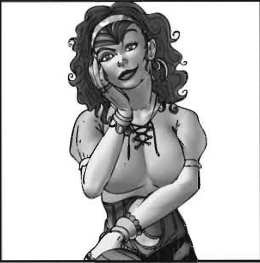
Circe
Circe from The Odyssey . If you're not familiar with the story, she turns Odysseus' men into pigs. I think you can guess the sole reason why she's in this game.
Anyway, Circe is a half-Greek, half-Ethiopian witch. She was taught by the most famous witches of her day and is herself a living legend, known for the many books she has written (none of which are named), her impeccable magic skills, and her "exciting life" in general. She currently lives in a palace in a pocket dimension located in NYC's Greenwich Village and owns a sci-fi/fantasy bookstore called Circe's Secrets. She's probably Harris' dream girl, ugly as hell character art notwithstanding.
Circe is Rank 6. She has the Beautiful and Mysterious talents and the Transmuter heritage. She has a D20 Magic die and her other attributes range from D6 to D12. She has Alteration 7, Divination and Healing 6, and 5s in every other magic type, and has 17s in nearly every single magical skill except Casting (10). This makes her an illegal character since, if you remember, 10 is the maximum amount of ranks one can have in a skill and indicates that they are "The Best" at it, and there is nothing in the book saying that a skill can go above 10 through spending voodollars. All of her sample attacks involve Alteration in some fashion. She has wards cast on herself that let her ignore 5 damage, make her immune to Alteration spells, and lets her heal 1 HP a minute. She also instantly knows when someone anywhere in the world says her name "and it annoys her". Apparently, she's too dumb to figure out a spell that will turn that off.
While she doesn't use it, her wand is also highly sought after and she will lend it to people whom she thinks needs it. The wand gives +5 to Alteration spells and all Alteration spells cast with it only cost 1 Zap. All other spells get +2 to their rolls, or I assume that's the case considering the book says "All nine Alteration spells", and it can store 10 zap which recharges every 24 hours.

Deacon Silas Black
That's one hell of a widow's peak he's got there. A bit unrelated, but this guy reminds me of Grunfeld Bach from Vampire: The Masquerade: Bloodlines , and I wouldn't be surprised if he was a ripoff of him both in looks and personality. When I was writing this out, I kept getting the urge to type "Bach" instead of "Black".
Black is a 500 year old Irish immortal who was cast out of his village because everyone was afraid of his powers. Fortunately, the monks in a nearby abbey considered his powers to be gifts from God and took him in. They loved and cared for him, and he eventually became a priest. When he was around 100 years old, a pirate witch broke into the abbey for some reason, stole their shit, and turned everyone except Black into stone. It was this event that caused Black's hatred of witches and caused him to form the Malleus Maleficarum.
Black's blurb tries to make him out to be the worst person that ever lived.
WGA posted:
...an Immortal with no heart.
[...]
A true Zealot, Black is ruthless and hard, with no room in his heart for compassion r love. [sic] He carries out is "duty" with an intelligent, calculating coldness that in itself strikes fear into those who observe him. He is willing to sacrifice both his men and innocent bystanders to see every witch destroyed.
You can't have "no room" in something that doesn't exist to begin with, you know.
Personally, I would be the same way too if some bitch came and murdered all of the people that took me in and showed me love when even my own parents rejected me.
Black is Rank 6. He has a D12+2 in Magic and D10s and 12s in everything else. He has the Warrior and Wicked talents and is a Promethean immortal. He has 3 ranks of Legendary Strength and 2 in Tough Hide and Elementalism 6, along with a Power skill of 9. Along with the iron implants that all MM have, he has the Extreme Prejudice (+2 to rolls when confronting witches), Sap Strike (martial arts move that drains 5 zap), and Stun Strike (gives -3 to all rolls to a target) training traits and something called "Iron Will", which isn't listed or explained anywhere in the book.
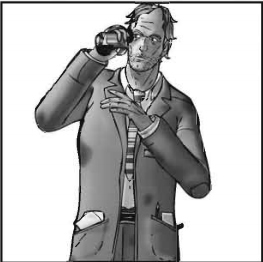
Gary Reed
A reporter for a tabloid called "Believer" and the webmaster of witchspiracy.com. (Which Channel M hasn't bought, by the way.) He's 38 years old and lives in Seattle. That's pretty much it.
Reed is Rank 3. His attributes are an even spread of D6s and D8s. He has the Geek and Eccentric talents and a heritage that isn't listed in the book or explained called "Believer". He also has an ability called "True Believer" which, again, isn't listed anywhere else in the book or explained. His only bit of specialness is a camera with night vision capabilities.
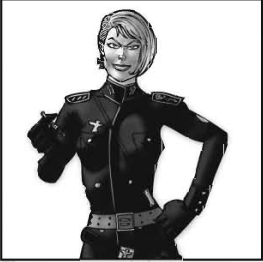
Ingrid Frieze
aka "The Black Baroness" or, as I like to call her, "Witch Hitler". Ingrid was born in Bavaria in 1629 to "an uneducated Rustic witch" and a mundane, who were both bakers, something young Ingrid herself wasn't good at, because this is a world that expects preschoolers to be good at adult professions. For some dumb reason, her mother enrolled her into Reinhexxen when her powers manifested at age 6. (Or maybe the witch world is like Scientology where they let little kids make their own decisions and do adult work. I don't know...) There, she proved to be a talented witch and quickly became Gothel's favorite student. Seeing potential in the young girl, Gothel convinced Ingrid, at the tender age of 8, to let her murder her parents, who she said were "holding her back", and Ingrid "watched with glee" as she did. The WWC gave her a job as a Warden in the Office of Magistrates after she graduated. I think you can guess how she handled her cases most of the time. Hint: She "learned that humans were little more than wild beasts from Gothel". The WWC kept overlooking the fact that she transformed, tortured, and/or murdered every single one of the mundanes she was sent to test until she killed the son of a secretary there, which got her removed from office and exiled from the mundane world. Gothel gave her a job teaching Mortal Studies and Necromancy. In the 1930s, she met up with Dracula and used him to get back into the mundane world and help the Nazis rise to power.
Despite having been stripped of her powers, there are unconfirmed rumors going around that she has regained them and her eternal youth. Her sheet gives her magical abilities and a lot of her plot hooks involve her returning.
Ilsa, She-Witch of the SS is Rank 6. She has a D20 in Magic and D8s and 12s in everything else. She has the Queen Bee and Wicked talents and the Follower of Echidna heritage. She has 6 ranks in Alteration, Curses, Elementalism, Offense, and Necromancy, a 7 in Mentalism, which makes the plot hook where she tries to convince the PCs to join her make no sense since she can just as easily mind control them, a 1 in Divination, and 3s and 4s in everything else, along with a Casting skill of 10. She can cast a second spell at the end of a round, and has wards on herself that let her ignore 3 points of damage and heal 1 point per minute. She also has a "Soul Ring" which can trap the soul of a person inside it and be used to control their vacant body. It can hold up to 50 souls and is supposed to be half full at any given time.
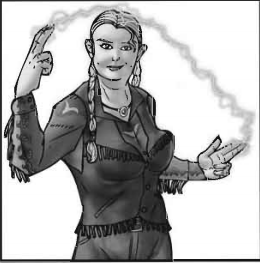
Jezebel Wilkins
Jezebel was born on a small ranch in Kansas in 1851 to Swedish immigrants. Despite being a tomboy, her parents wanted her to be a proper lady and apparently had enough money to send her to a normal boarding school on the east coast when she was 11, as opposed to just working on the ranch as I imagine a lot of kids her age would be doing in that time frame and in that same situation. A year later, she returned home and heard about the local Native Americans stealing cattle. She set out to hunt them down in order to prove herself to be a great cowgirl. When she found them, they thought it was funny as hell that a little kid had found them, but the medicine woman knew she was a witch and trained her. When she was 20, she left home and became a bounty hunter. The WWC eventually took notice of her abilities and gave her a position in the Office of Magistrates. She is currently the head of the office and lives in Texas.
"Bell" is Rank 5. She has a D12+2 in Magic, a D12 Will, and D8s and 10s in everything else. She has the Jock and Tough talents and the Magic Chaser heritage. She has Divination 6, Mentalism 5, and 2s, 3s, and 4s in everything else. Along with being able to point her boobs in two different directions, Jezebel is immune to Divination spells, gets a second attack at the end of combat rounds, and has wards that let her ignore 2 points of damage and heal 1 health per minute.
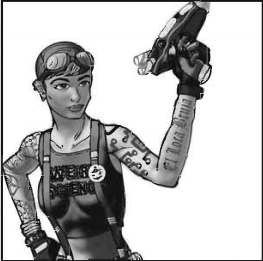
"Mod" Mia Ramirez
The 30 year old owner of Mod Mia's Modern Magic, the electronics store from the equipment chapter. She was raised by her grandmother, who owned one of those mundane item stores and would call her in to fix electronics. When she was 12, she was accepted into Coventry on a scholarship. There, she became friends with outsider witches who introduced her to the mundane world and computers. When it came time to do her apprenticeship, which isn't mentioned anywhere in the book as being part of the educational curriculum, she chose Emily Foster's self-insert, whom you remember is the creator of Cybermancy and is the awesome and talented and beautiful witch that all cyberwitches want to be like, but is terrible at editing books. When her apprenticeship was over, Mia opened up the electronics shop. A lot of witches don't like her because she deals with Cybermancy and computers and computers are filthy mundane inventions.
Also, her arm tattoo is wrong. It should be "La bruja loca". "El" implies that the witch ("bruja") is a man and "loca bruja" is just bad grammar.
Mia is Rank 3. Her attributes vary from D6 to D12. She has the Geek and Tough talents and the 21st Century Digital Witch heritage. She has 6 ranks in Cybermancy, while everything else is 2s and 3s. She has no additional special abilities, but she does have one of those ray gun wands that shoots different types of beams in the form of spells and will digitize and store anyone other than her who tries to use it. She can also manually perform that ability and store a person for up to a year for 1 zap. She also has a standard ghost top computer.
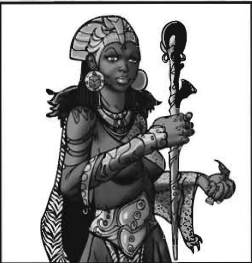
Queen Zuri of Wanobi
The 60 year old queen of the prosperous hidden African nation of Wanobi. Zuri is the youngest of 12 children, all of whom are witches. She was often ignored due to her age (there is a 100 year difference between her and her next oldest sister). At 11, she was sent to Coventry like her other sisters. There, she was isolated due to her royal lineage and kept under the watchful eye of Anansia, her sister who taught Time and Space there. After graduating, she traveled the world as nearly every witch in this section has done, because she didn't want to go back to the place where she was seen as "just another princess". Boo hoo, it's hard being privileged and special.
While on her travels, Zuri met Uzani, a mundane from Wanobi, and they got married at the blessing of both families. As they returned home, however, they learned that warlords from the surrounding countries had attacked Wanobi and witch hunters had captured her mother and sisters. The two defeated them, and Zuri's mom, who had been the ruler of Wanobi for centuries, made them the new king and queen as a reward. Her sisters were fine with that because none of them wanted to be queen anyway. She has three children, one of whom is a 13 year old witch named Nephra, and has a girly hard-on for protecting endangered animals and will probably hunt you to the ends of the earth and murder you if you try to hurt one, even though she's described as being "kind and good-hearted".
Zuri is Rank 4. She has a D12+1 for Magic and D6s to D12s for everything else. She has the Beautiful and Queen Bee talents and a mystery heritage called "Queen (Good)". The sheet says to see her description, which has no mechanical bits in it. I'm going to assume that it's talking about the "Queen" ability, which gives her +2 to Social rolls with Wanobians, +2 to Casting rolls for helping and protecting her country, and a 50% discount on all items purchased there. She also gets +2 Resist Magic and Body rolls when in Wanobi and instinctively knows when someone in the country or the country itself needs help. She can also see through the eyes of any animal in the country for 1 zap. She has Elementalism 6, Protection 5, Divination and Mentalism 4, and 2s and 3s everywhere else. Her wand is her scepter (+1 to Elementalism and Divination Casting rolls, range and duration for which is one higher, can grant any animal human intelligence with a touch, and can be used as a broom) and she has a guardian in the form of Aslala, her pet lioness.
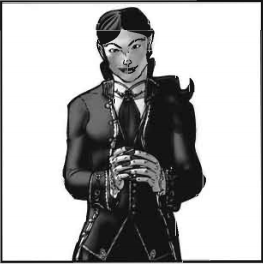
Vlad Dracula
Don't mind the fact that his scalp seems to be detached from his head. That's just a side effect of the horrible construction of this ebook.
Outside of his nights ruling the Wallachia countryside and the fact that the book clearly states his age (578), no one knows where Dracula came from. Some people think he was the first vampire created by Echidna, while others think a witch cursed him. Unlike what the book stated earlier, Dracula did not escape the BMHO and Alexander managed to decapitate him. Some of his followers found his body and head frozen in the northern Atlantic, thawed him out, and reattached his head. Since then, he has been in seclusion and searching for the three keys that will free Echidna from her prison. The keys are said to belong to the direct descendants of Lilith's three other children.
Dracula is Rank 6. His attributes are mostly D12s, with a D8 Mind and D10 Magic. He has the Wicked talent and another talent that, once again, is not mentioned or explained anywhere in the book called "Manipulative", and he is an Imperial vampire. He is immune to Alteration, Mentalism, and Necromancy spells, can summon 100 to 200 rats or a swarm of gnats and flies for 2 zap, can turn into a bat, wolf, or rat or a paragon version of the three or any person he wants, and can duplicate their voice and fingerprints if he drinks their blood, can hypnotize others, and can only be killed by decapitation and destruction of both the head and body.
That's it for this chapter. Up next: Willow-Brook and the Willow-Mistt School of Magic.
Willow-Brook and the Willow-Mistt School of Magic
Original SA post
Hey, want to read the opening comic of the WGA core and the continuation of the story yourself? Harris
linked a free PDF copy
of most of the
Witch Girls Tales
book on the game's Facebook page.

Witch Girls Adventures: Willow-Brook and the Willow-Mistt School of Magic
I found
this page
explaining the schools' crests and thought I should mention something interesting. That moon/key symbol on all of the crests indicates that they are approved by the WWC to teach magic. So no, the bullshit schools like LSP, Garden of Mu, and Reinhexxen are not outliers. The WWC actually approves of what they are doing, despite the fact that one of them revolves its entire curriculum around being evil. And no, it doesn't explain why the WWC accredited the sole immortal school when witches don't even go to it and it shouldn't be any of their business to begin with.
Anyway,
Chapter 11
, the last chapter in the book, is all about the Willow-Mistt School of Magic and the town it is based in, Willow-Brook.
Willow-Brook, which doesn't seem to be based on any existing towns, is a "middle sized" town with about 50,000 residents in northern Maine. The book describes it as being a cross between a suburb and a hamlet. The town started life as a trading post owned by a man named Zachariah Mitchell. Natives and fur trappers would come from "as far away as Canada" to trade there. Once a few tents and shops and whatnot had been set up around it, Mitchell declared himself mayor of the area in 1743.
In 1778, during the Revolutionary War, the area was chosen as a staging area for the British forces. The British major, Daniel Hanson, ordered that a fort be built on nearby Buccaneer Hill, the tallest hill in a series of them on the southwest part of the town, which overlooked the local Willow Lake, which he had a mansion built for himself alongside. He ended up funneling money meant for the construction of the fort into the construction of his mansion, which eventually ended up turning into a massive estate. Hanson abandoned it after the end of the war. The mansion and its grounds would stay abandoned until 1867 when Amora Mistt, a powerful Pennsylvanian witch, bought it and turned it into the Willow-Mistt school. Mistt picked the area because it was quiet and the few mundanes that were in the area kept to themselves. The school would eventually take up about 50 acres surrounding the mansion.
Unfortunately, around the early 90s, the new mayor, Dutch Chandler Sr, decided to expand the town by allowing lumber companies to set up shop there and promoting the town as the perfect weekend getaway spot for upper class families. He was successful, and after two terms his son, Dutch Candler Jr, took over and outdid him by building a huge shopping mall. Due to their combined efforts, the town went from a population of 1500 to its current total. Mistt wasn't happy about it to say the least, but she didn't do what you would expect a witch to do and just destroy the entire town. Instead, anybody who wanders too close to the school ends up being teleported to another area of the town at best or turned into an animal at worst.
Places of note outside the town include Moaning Creek, a swampy area near the end of a branch of the Sunside River that is home to goblins, animal paragons, and a swamp thing ripoff called Moan 'n' Groan; a campground; some docks and homes for all of the rich people that come to the town during the summer; a cemetary; a park that is used for flea markets and a yearly Ren Fair; and a summer camp that appears to be added just as an excuse to get Boy Scouts and Hex Scouts in the same area so the latter can terrorize the former, since that's where they hold their respective jamborees.
Places of note inside the town include a city hall, a diner, a thrift shop run by a fae pretending to be her own daughter, two lumber facilities, a Wiggly Piggy grocery store (which kind of doesn't work as a joke since Piggly Wigglys only exist in the midwest and south, not New England.), and a donut shop (named either Big-Oh's Donuts or Donut Dan depending on whether you go by the writing or the character art) with a
Man vs Food
style offering: A foot long glazed donut with powdered sugar and the customer's choice of filling.
The two largest buildings are the Willow-Brook Mall and Willow-Brook High School. The mall is a three story building with every type of store you or some teenage girl could ever want, including an arcade and a comic book/tabletop gaming store, because Harris is a nerd and has to mention it. It is the largest employer in town. The high school's recently renovated campus consists of the main building, a large gym, and a 15,000 seat football stadium. It has 5,000 students and 300 staff members, half of its potential max capacity, and its mascot is a lumberjack. Its football team sucks.
Willow-Brook and Willow-Mistt students tend to not get along.
WGA posted:
For years, the Willow-Brook students have treated the Willow-Mistt students as outsiders and often make them feel less than welcomed. The Willow-Mistt students, for their part, have done their own share of magical pranks to the students in retaliation. "The Misttees", as the local kids call them, are thought of as snobbish, geeky, and antisocial, but occasionally friendships between students at both school occur.
Did I mention that witches are an oppressed minority who are treated badly solely because of their specialness?
Despite the rivalry, Willow-Brook's "principle", Gloria Lucas, and Amora Mistt occasionally collaborate, usually to get tutors from the former for the latter's school, as Lucas has been improving the school's academic and artistic programs. Again, I only see it as an excuse by Harris to get the Willow-Mistt students to terrorize the Willow-Brook ones.
Now for Willow-Mistt itself. Here, have a map:
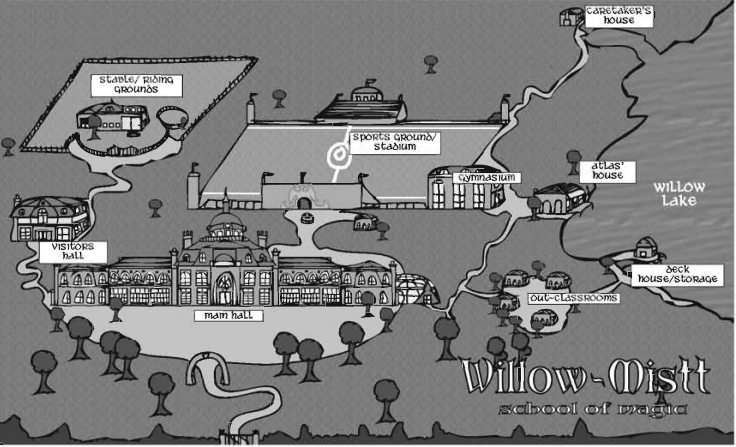
Willow-Mistt is the smallest of the named magic schools with only 45 students and 12 staff members between them. By grade, W-M has 10 neophytes (6 to 9 years old), 15 initiates (11 to 13, I guess you get a gap year when you're 10), 10 apprentices (14 to 15), and 10 interns (16 to 18). These grades are also used by other schools of magic. Its mascot is a phoenix and its colors are "crimson" and black.
To be admitted into the school, students have to submit an application and pass an exam on mundane and mystical studies. So if you're an Outsider who's had no exposure to magic up to that point, you're kind of SOL. Once they pass it, they start school the next semester. The school year runs from early August to mid June, with the fall semester ending in late December and the spring semester starting in mid January. The students are provided their textbooks, three uniforms, two pairs of shoes and one pair of boots, and a regular and rain coat. For personal belongings, they're allowed to bring a large trunk or two suitcases worth of clothes and objects, a wand, a form of magical transportation other than a car, 10 magical devices or potions (which the intern "enrollment officer" has to approve), and a familiar.
Willow-Mistt has 10 rules of conduct:
WGA posted:
1. Students shall treat all other students as sisters.
2. Students shall not cast harmful spells on other students.
3. Students shall not haze other students.
4. Students shall report on time to all school functions and classes.
5. Students are not to run, fly, or teleport in the halls.
6. Students are to treat staff members with respect and kindness and use "Ma'am" and "Sir" when speaking to them.
7. Students whose grades are unacceptable (not passing all classes) shall not be allowed to participate in extracurricular activities.
8. Students may only visit Willow-Brook in school-chaperoned outings or with permission of a staff member.
9. Students shall not use spells in the presence of Mundanes in the Willow-Brook community.
10. Students shall treat the school grounds as if it was their home.
There is also an unspoken rule of not performing magic on the ground floor of the main hall, in case any mundane visitors drop by.
The school runs on a demerit system of punishment. Breaking a rule, having bad grades, or just being an ill behaved little shit in general will get you 1, while being a danger to yourself or others will get you 4. Getting 10 earns you a month's probation. Break a rule during probation while still having demerits on your record will get you expelled for the rest of the semester. Students can remove demerits by working on the school's grounds or have them removed by a staff member for good behavior. So theoretically, Lucinda or anyone else could torture as many kids as she wants and at the most, she won't be allowed on the school's grounds for a few weeks, provided she gets caught. The book likes to emphasize the fact that the staff isn't all-seeing and students can get away with things.
Students live in dorm rooms for two people, except for initiates who sometimes have three people to a room, and neophytes who all live in one big room and are supervised by an intern, who gets her own room connected to the neophyte one. At the apprentice level, students get their own bedrooms and a small living room, and at the intern level, students get separate bathrooms. The dorm has a common area with enchanted desks and bookcases for private study. The dorms and the dining hall that serves three meals a day are located in the main hall, along with the classrooms and staff apartments.
Non-neophyte students pick their own classes and attend 5 one hour classes on Mondays, Wednesdays, and Fridays and 3 two hour classes on Tuesdays and Thursdays. One of the appendixes offers a system for determining a character's classes. (Roll a D4, consult some charts.) Half of a student's classes deal with mundane matters (The Three Rs, Science, History, Philosophy, Music, Phys Ed, etc.) while the other half deals with magical matters like each type of magic, Mystical History, Cryptozoology, Potions, and Enchantment. On top of the normal classes are 15 extracurricular activities that students can participate in. Willow-Mistt will sometimes hold joint events with Willow-Brook High and a local elementary school. Willow-Mistt believes that doing this "gives the girls a chance to interact with mundanes and practice hiding their true natures".
Up Next: The Staff
The Staff of Willow-Mistt
Original SA post
Witch Girls Adventures: The Staff of Willow-Mistt
It's finally time to meet the staff of this school and some of the hellspawn that they teach. The book states that W-M is unique in the fact that it employs non-witches as teachers and staff. This is completely incorrect as six of the other nine named schools in the book have non-witch staff members, usually ghosts. (Seven if you count Trinity Stone and its giant armadillo teacher.) A few sentences later, the book backpedals and points out that while ghost staffers are common, immortals and mundanes are right out and that's what makes W-M special. That is also incorrect. Dragon Stone and Onyx Storm also have immortals on their staffs. (Dragon Stone also has two dragons. Hell, Onyx Storm and Chiron have shapeshifters on their staffs.)
The intro to this section also mentions that casting a spell on a teacher is the only offense that will get you an automatic expulsion from any magic school in the world.
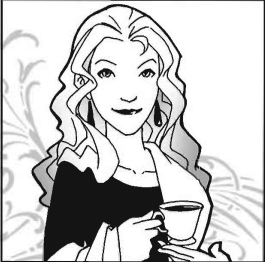
Headmistress Amora Mistt
Born in Philadelphia in 1738, Amora is pretty much perfect: She's kind, even tempered, understanding, and treats everyone regardless of their origin with respect. Before opening Willow-Mistt, she participated in some way in every war the United States got itself into up until the Civil War, during which she ran a successful leg of the Underground Railroad.
Just so we're clear, the US participated in more wars than just the Revolutionary War, the War of 1812, and the Civil War during that time frame. I don't think Harris knows that, because Amora has "bigotry" on her list of dislikes and I can't see her helping the US kill and push whole tribes of natives off of their lands and then going on to help runaway slaves, but witches have been shown to be hypocrites who don't operate under normal rules of logic. So who knows.
Also, according to Pirates of Buccaneer Hill , her mentor is Yallah, the asshole who runs the bookstore in the equipment chapter .
The NPCs in this section aren't given difficulty ranks. Amora has various levels of D12s with a few D10s and D6s for her attributes. She has the Mysterious and Brainiac talents and the Oracle heritage. She has 6s in Alteration, Illusion, and Time and Space; a 5 in Mentalism; 4s in Conjuration, something called "Naturalism", Protection, and Healing; and a 3 in Divination. She has wards on herself that let her ignore 2 points of damage and gives her +1 Resist Magic. Remember when the book said that the staff aren't all-seeing? That's a lie. Amora is (+2 to all rolls on school grounds and +4 to know what's going on in the school, and her crystal ball gives her bonuses in Divination and let's her see through the eyes of any birds in the area), but she just ignores a lot of things so that her girls can learn how to work things out on their own. Her wand can also negate any spell cast by any of the students and shoot lightning.
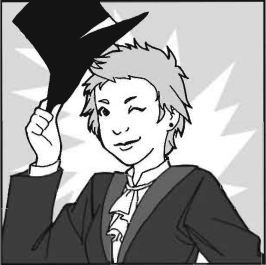
Allison Cadabra (née Cohen)
Born in Buffalo in 1916, Allison was the wife and "assistant" of Arnold Cadabra, a famous stage magician. Assistant in quotes because she was responsible for most of the magic tricks that he did. (So did his career start before he met her or after?) When he died in the 70s, she posed as their daughter and tried performing in her own stage show in Las Vegas, but failed because "no one wanted to see a female magician". Soon after, she was hired on as Willow-Mistt's Conjuration and Enchantment teacher. She's very theatrical and is still giddy over the fact that she's in a place where she can freely use magic. I actually kind of like this character.
Allison has D8s in everything except Body (D6). She has the Entertainer and Zap Happy talents and the Hypnotic heritage. She has Conjuration 6; 4s in Time and Space and Mentalism; and 3s in Elementalism, Protection, and Offense. Because of her former profession, she can make spells look like stage magic (Very Hard Mind roll to think otherwise) and is good at things that require a steady hand and slight of hand moves (+2). Her top hat functions as a bag of holding and can conjure normal animals for 1 zap. Her wand is the magician's wand from the equipment chapter with an added +2 bonus to Conjuration rolls.
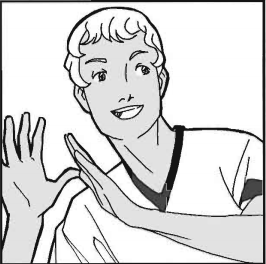
Atlas Agrippa
The immortal History/Phys Ed teacher. (Immortals are apparently really good at teaching history because of reasons.) He was born somewhere in Greece in 889 and got his name from his size. (He's 7 feet tall.) Atlas is one of those teachers that likes to ramble and tell personal stories instead of teach. He also likes to flirt with the female teachers.
Atlas' attributes range from D8 to D12. He has the Jock and Warrior talents and is an Atlasian immortal. He has Elementalism 6, 4 ranks of Legendary Strength, and 2 ranks of Tough Hide. He has a double headed axe that does +5 damage and a signet ring that makes him immune to any spell cast by the students.
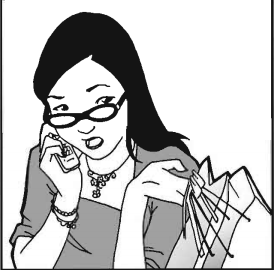
Constance Li
"Connie" is the only child of rich Hongkongers. Her parents spoiled her rotten and then cut her off after she graduated college and told her that she had to work for a decade in order to get her inheritance. So now she's W-M's Divination and Mentalism teacher and has finished two of her 10 required years. She's pretty much miserable all the time because she's in the middle of a lot of nature, which she hates, along with "generic anything".
Connie has a D12+1 in Magic and D6s, 8s, and a 10 in everything else. She has the Friendly and Rich talents and the The Sight heritage. She has 6s in Mentalism and Divination; 3s in Time and Space and Cybermancy; and 2s in Healing and Protection. Everything she buys is -2 in cost because she's good at finding bargains. Her cell phone functions as her wand which she can also use to summon anyone with a Resist Magic attribute of 12 or less at the cost of 1 zap, and call the dead.
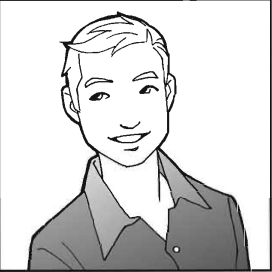
Derrick Kroft
One of the two mundanes on W-M's staff and the Grammar, Literature, and Drama teacher. When he was in graduate school, he met Susan Bradford, his future wife. After a year together, Susan told him that she was a witch. Instead of being afraid of her "unlike a lot of mortals", he accepted and respected her for what she was. (I'm going to assume he also lucked out and didn't get a warden who tortures or transforms people when the magistrates came calling.) The two got married after they graduated and had a daughter, who is a Willow-Mistt student. They moved to Willow-Brook after Susan got a job at W-M as a teacher, and Amora offered him a job shortly after a position for a mundane subjects teacher opened up. All of the other teachers except one respect him, and a lot of his students have crushes on him.
Derrick has mostly D6s for his attributes with a D8 Mind and D4 Will and Magic. He has the Friendly and Goody-Goody talents and no heritage. He also has that mysterious unexplained "True Believer" ability that was on Gary Reed's sheet. Like Atlas, he has a signet ring that makes him immune to any spells cast by the students.
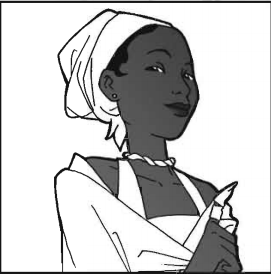
Ebony LaRue/Le Rue
The daughter of a "legendary voodoo queen" of New Orleans; the Necromancy, Curses, and Music teacher; and the author of that voodoo book from the equipment section (which gives her that second last name). Before accepting her current job, she followed in her mother's footsteps and helped the poor while making a living selling potions, blessings, and curses. She's a perfectionist and has a reputation of being a stern, no-nonsense teacher. But she's actually very mischievous and likes to play pranks on the other staff members. She hates music made after the 70s for some reason.
Ebony has D12+2 Magic and D6s to 10s in everything else. She has the Beautiful and Trickster talents and the Hexer heritage. She has a 7 in Necromancy; a 6 in Curses; 5s in "Mental" and Offensive; and 4s in Alteration, "Naturalism", Protection, and Time and Space. When having a voodoo doll on her person, the subject that it represents cannot harm her. For some reason, she has to spend extra zap to remove the range restriction for spells cast on it, even though range isn't an issue with the normal voodoo spells listed in the magic section to begin with. (The limitless range thing is free automatically.) Her "wand" is a gold talon ring that can reduce a target's Resist Magic by 1 for a D6 roll's worth of days, with a maximum penalty of -5, for free.
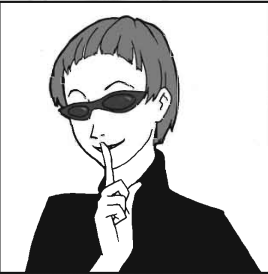
Hagatha Cross
The Protection, Time and Space, and Potions teacher. You can't tell from the picture, but she has both the Evil Eye AND Hag's Syndrome heritages. This makes her double persecuted by the witch community and an illegal character according to the system's rules. (Remember: You only get 2 talents and 1 heritage to start and you can't buy additional heritages using the voodollar payment system outlined in the book.) That's pretty much the crux of her entire character; nobody liked her and she didn't fit in anywhere, but then she came to Willow-Mistt as a student and Amora helped her see her self-worth. She's popular with the students due to her outgoing nature and sense of humor.
Hagatha has a D12+1 Magic die, two D6s, two D8s, and a D10 for the rest. Along with her illegal dual heritage setup, she has one talent: Friendly. She has Time and Space and Protection 5; Conjuration 4; Divination, Elementalism, and Mentalism 3; and Alteration and Offensive 2. She has special polarized glasses that only she can remove. When firing eye beam spells, she can have them ricochet off of items at the cost of 1 zap per bounce.
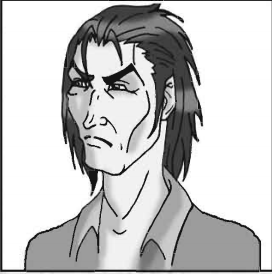
Moe Twitch/Cheddar
The school's groundskeeper and janitor and the other mundane. Moe used to be a rat living in New York City, but Amora changed him into a human when she came across a bunch of kids torturing him. Since the groundskeeper position was open at the time and he liked being human, she gave him the job. Despite his surly looking portrait, he's actually very skittish.
Why does he have two last names? Because the core lists one last name while Pirates lists another.
Moe has two D4s, two D6s, a D8, and a D2 for Magic. He has the Coward and Ruffian talents and no heritage. He has +4 Senses for smelling rolls and can turn back into his rat form for 1 zap. He also has a toolbox that lets him grab tools without having to go back to his work shed. For some reason, he didn't get a signet ring.
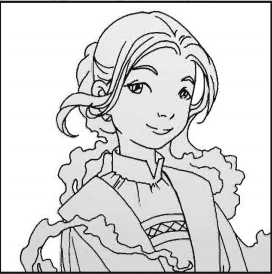
Molly Daggle
A ghost and the school's cook (who is neither male nor a renowned chef like an earlier section states). Molly was born in San Francisco in 1894 and was once the cook for a boarding house. An angry witch, for reasons unknown, burned it down, killing Molly, trapped her spirit in a "ghost gem" and enslaved her for the next twenty years. Some asshole parent of a student, who may or may not be the same witch, gave the gem to Amora as a gift. Amora promised Molly that she would be given independence and "turned into a full-fledged ghost" if she became the school's cook. Molly accepted. Amora transferred her into a "smooth stone" which now serves as her anchor and gave it to Molly, who has hidden it.
Molly has a bunch of D6s and a D8 Mind. She has the Friendly and Calm talents. Along with the standard ghost abilities, she has excellent telekinesis skills, allowing her to lift up to 300 pounds at a range of 100 feet and perform 20 different tasks at once. Because of this, she runs the entire kitchen by herself.
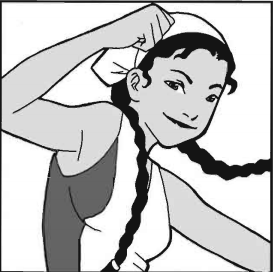
Nina/Mia Sanchez
C'mon dude, there's only a page between the name change. You seriously missed it?!
The Healing, Herbalism, Math, and Mundane Sciences teacher. Nina loves science. She also loves extreme sports. So she frequently combines the two. (Want to study marine biology? Surfing trip! Bungee jumping? Time to learn some physics!) I get the feeling her Healing classes involve throwing yourself off of high places and then trying to perform spells.
Nina has a D12+1 for Magic, a "D8+1" for Body, and two D8s, a D6, and a D10 for everything else. She has the Jock and Friendly talents and the Attuned heritage. She has Healing 6; Protection 4; Conjuration and Mentalism 3; and Curses and Cybermancy 2. She gets +1 to all of her rolls and can spend 2 zap to give herself a +1 to any roll other than magic skills with a maximum of +5 because she's really lucky.
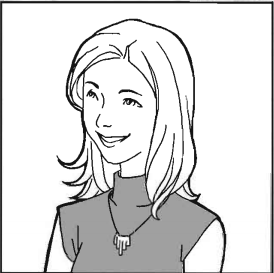
Susan Kroft
Derrick's wife and the Computers and Cybermancy teacher. Susan comes from a long line of witches and was one of the most popular girls at Willow-Mistt when she attended. Much to her mother's chagrin, Susan knew early on that she wanted to be a teacher instead of a "social-climber", like her. Her mom doesn't approve of her and Derrick's marriage. I'm going to guess that Susan's mom's name starts with an E because this is clearly another Bewitched reference and it's becoming obvious that Harris masturbates to that show.
Susan has a D12+1 in Magic and D10s in everything else except Body, which is a D6. (You probably noticed by now that the highest attribute for any given witch NPC is going to be Magic.) She has the Brainiac and Goody-Goody talents and the 21st Century Digital Witch heritage. She has higher stats in skills that involve information on magical history and monsters than computers for some reason (including a mystery skill called "Legendaries"). She has Cybermancy 6; Mentalism 5; Protection 4; Time and Space 3; Alteration 2; and Divination and Elementalism 1. Her special ability is that she can project her voice across the "astral void" and send messages to people for 1 zap.
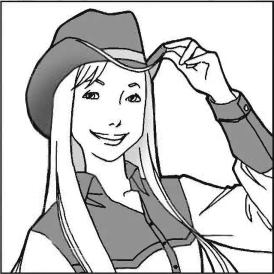
Tandy McCormick
The stereotypical Texan (minus the right wing views) and Elementalism; Horseback and Broom Riding; and Cryptozoology teacher. She grew up on her family's cattle ranch and eventually left it to work on a "magical horse-grooming ranch" before being approached by Amora for a teaching position. She takes care of the school's stables which hold the normal horses for the Saturday morning riding class, five cows (one of which was enchanted to produce only chocolate milk), and her companion Twister. Twister is a large, black pegasus with purple eyes and shoes and saddle made out of "silvery moon metal". Her bio says that she's a Rustic, but her sheet says she's an Insider.
Tandy has a D12+1 Magic attribute and D8s in everything except Body (D6). She has the Brave and Flier talents and the Shamaness heritage. She has Elementalism 7; Offensive and Protection 3; and Healing and Divination 2. She has a +2 to Social rolls when dealing with animals, as they are not frightened by her.
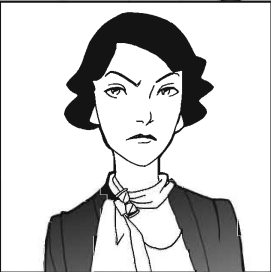
Ursula Scratch
The prim, proper, and obviously evil Alteration, Offense, and Mysticism teacher. Nearly everyone on campus hates her. For the students, it's because she's that one asshole teacher who gives a lot of homework, extends her classes for hours on end using Time magic, and just treats them like shit in general. For the staff, it's because she's an absolute bitch who disrespects everybody and frequently threatens to painfully murder the non-witch staff members... when she actually acknowledges their presence. The guy who was the groundskeeper before Moe? She killed him. ("The last caretaker insulted Ursula Scratch and was reduced to a smoldering stain before he had a chance to scream.") She is very vocal about the fact that she hates how Amora is running the school and often tries to take over and change things when Amora's away. The only thing she enjoys is turning humans into frogs "for little or no reason", and she is responsible for a noticeable rise in the frog and toad population in Willow-Brook. Why was she not fired a long time ago? Your guess is as good as mine.
Also, she was born in 1756, is from England, and is the only witch in her family even though she's part of the Sorceress clique.
Evil Teacher has a D12+3 Magic, a D6 Body, D8 Senses, and D10s in everything else. She has the Devious and Queen Bee talents and the Attuned heritage. She has Alteration 7; Mentalism 6; Offensive and Protection 5; and Conjuration, "Naturalism", and Time and Space 4. As hard as it may be to believe, Ursula is a member of the Highbinders. Along with her membership ring, she gets a +1 to Social rolls when dealing with people in power in the witch community and a +2 to casting spells on mundanes. She also has wards that let her ignore 2 damage and give her +1 Resist Magic and a hourglass broach that lets her add an hour of time to the room she's in when she touches it, with a max of 2 hours a day. (Time moves normally outside of the room.)
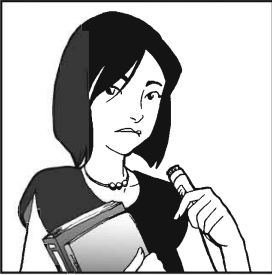
Valerie Grey
The shy as hell Potions and Protection teacher ((I guess those subjects are popular enough to have two teachers covering them) who kisses Ursula Scratch's ass in the hopes that she will get to join the Highbinders one day. (Which will never happen because she's an Outsider.) Even though Ursula bullies her and uses her as a lackey. Tandy and Atlas have been trying to make her more outgoing.
Valerie has D12+1 Magic, two D4s, two D6s, and a D10 for attributes. She has the Meek and Lackey talents and the Warder heritage. She has Protection 6; Mentalism and Curses 4; Conjuration and Time and Space 3; and Cybermancy 1. Her Ward Maker ability lets her spend 5 zap to create a permanent ward that lets the target ignore 1 point of damage and gives +1 Resist Magic, provided she succeeds on a Very Hard Enchantment roll. This ability is completely useless since anyone can do the exact same thing as a Rank 1 Protection spell at a much lower cost and difficulty... using a skill that actually makes sense for that kind of roll.
Her wand, which she uses all the time because she's insecure about her own abilities, gives her +1 Casting to all spells and +2 to protection spells and wards, along with a -1 zap cost to all spells.
Up next: 19 of Willow-Mistt's terrible students, including Lucinda.
The Students of Willow-Mistt, A to L
Original SA post
Witch Girls Adventures: The Students of Willow-Mistt, A to L
More NPC sheets, this time for a little under half of the students of Willow-Mistt.
The girls with the color portraits are from the supplemental material in Pirates of Buccaneer Hill and are mostly meant to be used as PCs. I figured I would include them for completion sake.
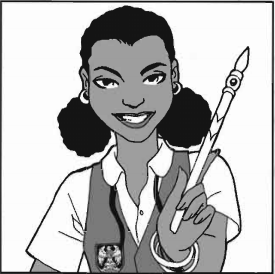
Amber Davis (15)
The same Amber from the intro comic and chapter fluff. She's really good at Conjuration and frequently uses it to make her own clothes out of sunlight, rainbows, moonbeams, and other fantastical materials.
Amber's attribute spread is what you would expect a starting Insider character her age to have. (The optional rules give 14-15 year olds a +1 Will die increase, which I assume was used to turn her D4 Will into a D6.) She has the Tough and Urban talents and the Conjurer heritage. She has less magic ranks than a starting character her age would have though (14-15 year olds get +4 ranks). She has Conjuration 4; Alteration and Protection 2; and Curses and Divination 1. She gets a +2 to making clothes, and can create physical material out of the above elements at a rate of 5 feet every 2 to 3 hours for 1 zap. The material is "far more durable, beautiful, and easier to work with than mortal fabric" and cannot be conjured. She has an ankh choker that lets her ignore 1 damage and a wand that gives -1 zap to all spells, -2 zap to Conjuration spells, and +1 to casting rolls.
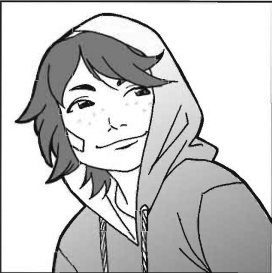
Amy Olson (13)
The tomboy daughter of Sam Olson, Willow-Brook's sheriff. She originally lived in "Digahol" Idaho before Sam got the sheriff job, and no one knew she was a witch until Lillian told Amora about her. Before then, she learned how to do simple spells herself. She's technically part of the main group of characters, but is shown less for some reason.
Amy has a D8+1 Body, a D6+1 Will, and an even smattering of D6s and 8s for everything else. (No D4, which she should have since she's a Rustic.) She has the Jock and Unshakable talents and the Shamaness heritage. She has Elementalism 4; Divination and Illusion 2; and "Protect" 1. She used her shamaness abilities to "awaken" her broom, allowing her to control it from a distance and call it telepathically for free. She also has a soccer ball that can return to her on command and does 5 damage when used as a weapon, and her "dryad wand" gives her -1 zap to all spells, +1 to casting rolls on wooden objects, and can be used as a compass and dowsing rod for finding water.
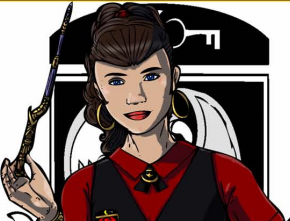
Andromeda Aquero (13)
Smart, curious, observant, subtle, and keeps to herself. That's pretty much it.
Andromeda has a D8+1 Mind and a normal Insider pool of die types. She has the Brainiac and Devious talents and the Wand Waver heritage. She has Illusion, Mentalism, and Time and Space 2; and Cybermancy and Divination 1. Unlike the NPCs in the core, the sheets in Pirates have signature spells. Hers is a Mentalism 2 spell called "Blarny Stone" that grants +1 to Fib rolls. Her custom wand is gold coated and gives +1 to Spell Breaker skill rolls and Illusions and Mentalism casting rolls, and regenerates 2 zap a day.
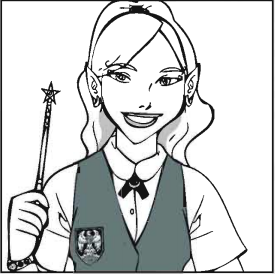
Ashley White (16)
A Canadian half fae. When her high fae lord father died of unknown causes, her mother and her moved from Prince Edward Island's magical town to the mundane side of Halifax, with her mother thinking that the change of scenery would do her good. She's still adjusting to the mundane world, which is "an assault on her with sensibilities", and tends to be stand-offish in the presence of mundanes. Despite that, she's in training to join the Godmother's Guild "to honor her father", but doesn't like the whole "don't be a complete shithead to mundanes" rule that they have and is very big into perpetuating karma. As a result, she's having trouble earning her license. The fact that she likes to practice her magic on her mundane step brother probably doesn't help matters either. No telling when or if she herself will be godsmacked with some bad karma for treating her brother like that. Knowing this universe, probably not.
Ashley has a D10+1 Magic, a D10 in Mind, and D6s and D8s in everything else. She has the Mary Sue (I don't see it) and Trickster talents along with her Half-Otherkin heritage. She has Alteration 4; Conjuration, Cybermancy, and Mentalism 2; and Divination, Protection, and Time and Space 1. She gets +1 to casting spells to teach someone a lesson and said spells are considered to be one rank higher. She also instantly knows when someone has done something wrong and the right spell to use to teach them a lesson. She has a star bracelet from her father that lets her ignore 1 damage and gives her +2 Resist Magic against fae spells.
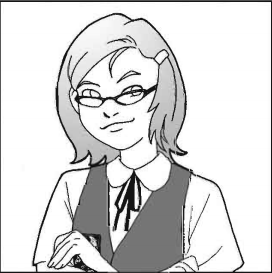
Barbara Goldstein (15)
You can't tell from the picture, but "Babs" is fat and was made fun of constantly for that and her glasses until she learned how to "strike back with the words and phrases of a girl with an obviously superior intellect". (There's a picture near the front of the book that portrays her better and makes her look less smug.) If you couldn't tell from her name, she's also Jewish and was tutored in a "traditional mystical program" before enrolling in Willow-Mistt at 10. She's the editor of the school newspaper and occasionally uses it, along with her gossiping habits, to get back at other students who are mean to her.
Babs has a D10 Mind and D4s, 6s, and 8s in everything else. She has the Busy Body and Urban (she's from Scarsdale, New York, which looks like a suburb to me) talents and the Warper heritage. She has Time and Space 4; Alteration 3 (I guess to use on the bullies when they outsmart her); "Elementals" and Offensive 2; and Conjuration and Mentalism 1. She gets +1 to Enchantment, Potions, and Spell Breaker "casting rolls" when they require an incantation, because her tutoring made her good at it. Her glasses apparently give her night vision capabilities and her wand gives her -1 zap for casting, +1 to all casting rolls, and can shoot lightning.
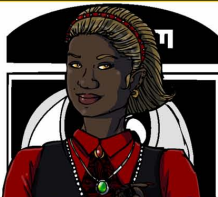
Beauty Vincent (13)
Beauty grew up in a funeral home "and the dead were her play things". One of her favorite pastimes is making animal corpses perform tricks. Not a lot of people want to be friends with her. I can't imagine why.
Beauty has the usual Gothique attribute spread; the Creepy and Friendly talents; and the Warder heritage. Her signature spell is "Shadow Shield", a Protection 3 spell that protects against 10 points of damage from undead and Necromancy and 1 from everything else. Her black bone wand gives her -1 zap for casting, +1 to Necromancy rolls, and can levitate objects that weigh a pound or less.
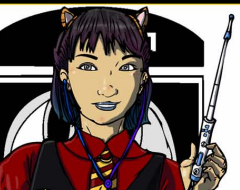
Chantavi Tseng (12)
Chantavi loves video games. As a result, she blows most of her substantial allowance (her parents are rich) on them and thinks life is one big MMORPG. Oh, and she likes to be smug about the fact that she can get video games that mundanes can't. So basically a really smug version of that kid from your elementary school who claimed to have an uncle who worked at Nintendo.
Chantavi also has the basic Gothique spread; the Geek and Rich talents; and the Hypnotic heritage. She has Cybermancy and Mentalism 3; and Curses and Offensive 2. Her signature spell is "Mii over Matter", a Mentalism 3 spell that lets her control a person's movements, like a video game character. Her "witch wand" gives her +1 to Mentalism and Offensive spells and functions as an MP3 player, flashlight, and game controller.
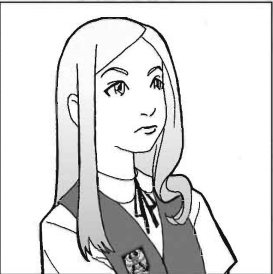
Circe Woodsworth (12)
Draco Malfoy with breasts, a Highbinder, and Ursula Scratch's favorite pupil and accomplice. Circe comes from a family of smug, racist southern assholes who supported the Confederacy during the Civil War. The fact that that's mentioned alone should tell you that she's meant to be a villain. According to that comic I linked a few posts back, Rosa has the misfortune of being her roommate, and the only reason she and Lucinda aren't thick as thieves as you would expect them to be is because Lucinda being friends with the other girls annoys her.
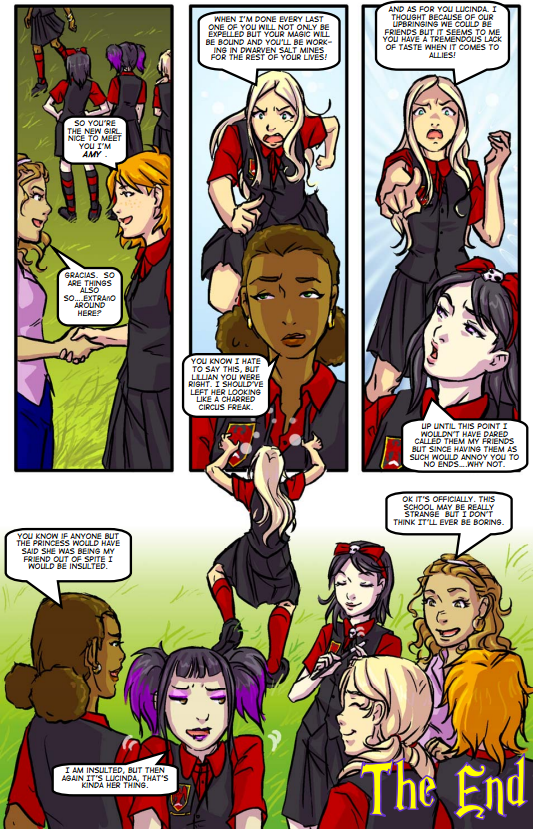
I'm also surprised that Circe hasn't been murdered by the adult Circe for simply having her name and forcing her to hear it constantly.
Circe has only a D8 in Magic, despite the fact that she's a Sorceress, three D8s, a D6, and a D4 for her attributes. She has the Snob and Rich talents and the Hypnotic heritage. She has Mentalism 4; Alteration and Time and Space 2; and Offensive 1. She can perform telepathy and telekinesis without having to use zap points and is immune to Divination magic from anyone with a Magic attribute lower than or equal to hers (so almost every kid on this list since D8 is the default for every clique except Sorceress) due to a ring that her mother gave her. Her wand gives her -1 zap points to casting, raises the duration and range of spells by one rank, and gives targets a -1 Resist Magic penalty. She doesn't get the Social bonuses that Ursula has for being a Highbinder, just the ring.
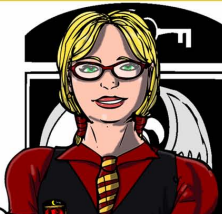
Gretchen Ericson (12)
Nancy Drew if Nancy Drew were a witch. Her father is a detective and she herself loves puzzles and mysteries.
Gretchen has a normal Outsider attribute spread; the Brave and Goody-Goody talents; and the The Sight heritage. She has Divination 3; Cybermancy 2; and Conjuration, Elementalism, and Healing 1. Her signature spell is "Clue Finder", a Divination 3 spell that gives her "insight" on clues.
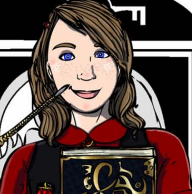
Kathy Liberman (12)
A crazy bitch who will probably be voted "Most Likely to Summon Cthulhu" when she graduates. Her family are followers of Echidna, but unlike regular followers, she and her family just think Echidna was misunderstood and that she really just wanted to bring order to the world.
Kathy has a regular Insider spread; the Eccentric and Unshakable talents; and a heritage from Pirates called "Echidnist", which gives her +2 to rolls when dealing with Hates and other creatures that are connected to Echidna, and any spells where they invoke her name are treated as being one rank higher. However, they have -2 Social when dealing with everyone else and the spells where they invoke Echidna's name cost an extra zap. She has Time and Space 2; and 1s in Alteration, Conjuration, Divination, Illusion, and Mentalism. Her signature spell is "View the Void", a fairly useless Time and Space 2 spell that opens a window to the Lovecraftian hell dimension that stuns anyone except the caster who fails a Hard Will roll.
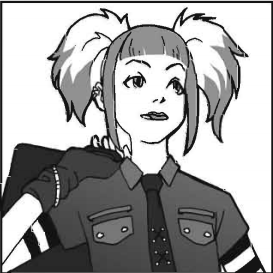
Lillian Tamako (13)
There's nothing I can say that you don't already know, aside for the fact that she's from San Francisco and one of her pastimes is making zombies.
Lillian has a regular Gothique spread minus the D4, which has been turned into a D6. She has the Mysterious and Ruffian talents and the Persephone heritage. She has Curses and Necromancy 3 and Cybermancy and Protection 1. (So she doesn't take advantage of that free rank in Necromancy that she gets for her heritage.) Along with being able to see ghosts, she gets a +2 Social for dealing with them. She has a skull ring that lets her ignore 2 damage and gets +2 Resist Magic to attacks from ghosts; and her wand gives her -1 zap, +1 to Necromancy rolls, and any Necromancy attacks do +2 damage.
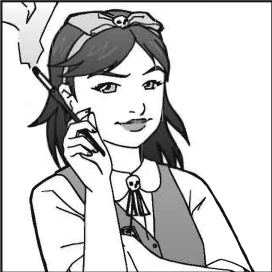
Princess Lucinda Hexxina Nightbane, Princess and High Enchantress of the Empire, and Lady of the Dark Isle of Corbus (12)
Fuck putting everything into my own words, here's a really lengthy bio on Lucinda written by Harris. Some highlights of that article include:
xbuilder posted:
Their second child (and daughter) Lucinda was a magical prodigy, so much in fact when the royal physician doctor slapped the new born princess on the rear after birth to induce breathing and crying Lucinda instinctively banished the physician to a pocket dimension of torment and destruction.
and
xbuilder posted:
An academic and magical prodigy she was raised under the watchful eyes of her parents and older sister Millicent. Her daily routine and caretaking however were the responsibilities of a royal nanny whom usually met an unfortunate magical end thanks to the precocious princess. By the time she was twelve Hundreds of Nanny’s had met such a fate, the bulk of them turned into animals or objects by the girl.
And here's her sheet.
WGA posted:
Princess Lucinda Nightbane
(Witch-Sorceress)
Age: 12
Job: Student (Apprentice)
Place of Birth: Bruja, The Dark Spire
Motivation: To get back to Bruja, avenge her parents, and rule the world.
Body: D4
Mind: D10
Senses: D6
Will: D8
Social: D6
Magic: D12
Life Points: 8
Reflex: 7
Resist Magic: 15
Zap Points: 24
Skills:
Bargain +2
Basics +5
Computers +1
Games +2
Leader +4
Instrument +4
Mundane Etiquette +5 [So she knows she's doing something wrong. She just doesn't care.]
Mythology +4
Plucky +6
Scare +6
Casting +8
Broom Riding +2
Cryptozoology +6
Herbalism +6
Magical Etiquette +3
Potion +5
Spell Breaker +6 [39 mundane points, 36 magical]
Traits: Temper, Wicked, Princess of Bruja
Abilities
Change!: Lucinda is potentially the most powerful Transmuter on the planet. All her Alteration spells are at -2 Zap (instead of -1) and are considered permanent unless Lucinda decides otherwise. [Meaning the normal duration rules are ignored and people only get turned back when she decides to turn them back or a certain condition is met. (e.g. someone's true love kisses them.) This is one of the possible Augmentations listed for Alteration spells.] If Lucinda's bonuses reduces the Zap of an Alteration to 0 or less it costs 0 Zap. Lucinda may also cast 2 Alteration spells in a single action but the second one doesn't get any of her Change bonus's (sic). To take advantage of this magic bonus, Lucinda must be able to invoke her single Alteration incantation: "Change!"
Princess of Bruja: Lucinda is from another reality. She has special powers unique to her and her older sister. Lucinda brought with her enough money to live comfortable (sic) for a few centuries during her exile and is considered Rich. Lucinda is also so naturally magical; all her spells are at -1 Zap and cast as if the MTR for range and duration was one higher. The three powerful knights of the forces of good (Lady Wulf, Lord Lyon, and Sir Behr) are also hounding Lucinda for crimes on her planet. Lucinda sees herself as being superior to all just about everyone because after all, she is a princess. She is -2 to all Social rolls when dealing with non-royals.
Magic
Alteration 7, Conjuration 3, Curses 3, Elementalism 3, Mentalism 3, Necromancy 3, Offense 3, Protection 3, Time and Space 3. [That's 31 ranks!]
Equipment
Skull Bow: Lucinda's Skull bow was a gift by her murdered mother. With it, Lucinda ignores 2 points of mundane damage and 1 point of magic damage.
Background: Princess Lucinda is an honest to goodness Princess and can be a real brat. She wants everything to go her way and has no qualms about changing things (and people) to suit her needs. Lucinda is the kind of friend you wouldn't want as an enemy and whom you keep in hopes of make her a better person.
Lucinda was born on another world where her parents ruled with absolute power. Being typical evil despots, they were eventually overthrown by the forces of good. Before they were executed for various crimes against the people of their land, they managed to send Lucinda and her older sister to Earth. Lucinda's sister thought of it as a new beginning away from their parents "questionable rule,", while Lucinda thought it was a punishment, as earth to her is a backwater world where she's treated like a child instead of a princess. [I didn't know the two were supposed to be mutually exclusive, but okay...]
Lucinda is a witch prodigy and is skilled at all manner of magic. But as good as she is at magic in general, she's a true virtuoso at Alteration. Lucinda loves nothing more than turning things into other things... especially people who annoy her. Many a time (some would estimate well over a hundred) has Lucinda been forced to turn a student or Willow-Brook resident back from an animal or object.
Likes: Being treated like a princess, turning people into things, and classical music.
Dislikes: Turning people back, not being treated like a princess, and being treated like a child.
How does she compare to other characters? Well, she has much higher attributes, way more skill points, and way more magic ranks than a normal Sorceress her age would have. She has a higher Magic attribute than all of the other named students in the school, and way more skill points (most have numbers within the teens) and magic ranks than they do (the next highest student only has 14). Hell, she has more ranks in magic than most of the teachers , and even some of the other adult witch NPCs. (Most of them have total magic ranks in the 20s. If you're curious, Circe has the highest with 69. Go figure.) Plus, her unique ability lets her ignore the usual rule of a spell always having to cost at least one zap if it is affected by a cost bonus. That cold iron weakness that the wiki claims she has is obviously not on the sheet nor taken into account in the game.
Lucinda reminds me of a terrible roleplay I was in when I was a kid. Everybody's characters were students in a fantasy vocational school where they were taught how to be [insert generic RPG classes here]. One guy made a student who was already an accomplished hero and already knew about every single topic that the teachers taught. Lucinda is that guy. There is no reason for her to even be in the school as she probably isn't gaining much academically, and everyone in the school would be better off if she wasn't there. Was she enrolled to learn social niceties? It's obvious that she doesn't care and probably won't listen to you if you tried to teach her how to not be an asshole. Was she enrolled to learn the WWC's flimsy rules? Again, you can just as easily tell them to her, not that she would obey them.
I mentioned a while back that Lucinda could give Samuel Haight, the old World of Darkness' premier overpowered character, a run for his money. I actually consider Haight to be the better character. Say what you will about Sam, he worked his ass off to earn his powers, and he didn't get them all when he was a little kid. He also seems to have more complex character motivations and I doubt he was created as a revenge fantasy against all of the people who made fun of whoever came up with him in middle school and as spank material for people with a certain fetish.
I'll get the rest of the NPCs later.
The Students of Willow-Mistt, M to W
Original SA post
Witch Girls Adventures: The Students of Willow-Mistt, M to W
The last batch of NPCs.
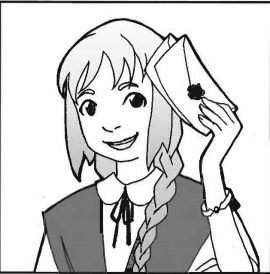
Melody Kroft (9)
Derrick and Susan's daughter and Amora's goddaughter. When Amora needs to talk to a student, she usually sends them a formal letter through Melody. (Why not just use magic or an intercom system?) She will also do odd jobs for any students who are nice to her for toys and candy. Aside for the fact that she has ranks in Alteration, she's kind of adorable.

Melody has a D2+1 Body, a D6+1 Magic, and a normal Insider spread for everything else. (Going by the optional aging rules, her Magic should be higher. But it's pretty obvious that Harris is just pulling stuff out of his ass for all of these characters.) She has the Friendly and Mischievous talents and the Protected heritage. She has Alteration, Illusion, and Mentalism 1; and no special abilities. Her wand, which is stripped like a candy cane and smells like peppermint, gives her -1 zap to spells, +1 to all casting rolls, and can make anything smell like peppermint for 1 zap. (The best power in the game by far.) Like every neophyte in the school, she has a special bracelet that lets the intern dorm mother and her real mother locate her.
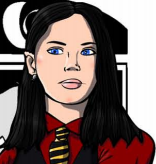
Mildred Dahl (12)
Another tomboy and one of Willow-Mistt's best athletes. She's good at pretty much any sport you let her play. Unfortunately, her family are kind of embarrassed by her because they're all sophisticated and stuck-up.
Mildred has the normal Sorceress spread; the Drama Queen and Jock talents, and is half-immortal. She has Offense 3; Conjuration 2; and Curses, Healing, and Mentalism 1. Her signature spell is "Sword of Minerva", a Offense 3 spells that turns her wand into a sword. She has a pet lizard named Scales who can turn invisible and a dragon bone wand.
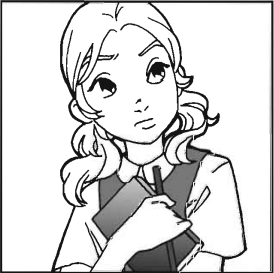
Monica Green (13)
Another character from the main group. She's at the top of her class and is a "rare" Cybermancy master. She also has a friend named Barley who isn't mentioned anywhere else. Harris once tried making a movie out of her step brother, Chaz, trying to deal with her being a witch.
Monica has a D10 Mind, a D4 Body, a D8 Magic, and D6s for everything else. She has the Brainiac and Geek talents and the Oracle heritage. She has Cybermancy 4; Protection 3; and Illusion and Mentalism 1. She has no special abilities. She has a cell phone that acts as her wand (-1 zap and +1 to Cybermancy rolls) and a laptop that she has named "Boo", which "is twice as powerful as the best laptops built by mortals". Boo can turn into a bracelet when it's not in use and gives her +2 to Computer rolls.
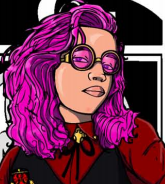
Olivia Saks (12)

Thanks to her parents' constant praise, Olivia has a very inflated sense of self-worth and can be very vain at times. So much so that she views her "Evil Eye disability" as a positive trait. (Uh, it kind of is.) Olivia has the Mary Sue talent, because apparently being a narcissist with fairly average abilities and pink hair makes you a Mary Sue and not, say, being able to murder the doctor who birthed you when you were only a few seconds old for doing a routine procedure, and then going on to routinely murder people at the snap of a finger and get away with it.
Olivia has a normal Sorceress spread and the Beautiful talent to go with the Mary Sue talent and Evil Eye heritage. She has Alteration 3; Conjuration and Offense 2; and Cybermancy and Divination 1. Her signature spell is "Liquefy", a Alteration 2 spell that turns inanimate objects into "multicolored goo of the object's original color".
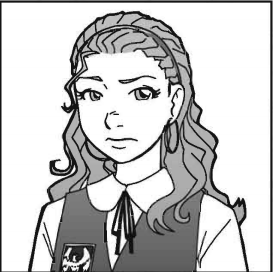
Rosa Montoya (12)
The new kid that likes to spout random, possibly google translated Spanish words because she's Mexican, who will always have your back. That's pretty much it.
Surprisingly, Rosa has a normal Outsider attribute spread. She has the Brave and Temper talents and the Hypnotic heritage. She has way less magic ranks than other witches her age; Mentalism 2 and Alteration and Divination 1. She has no special abilities. Her wand, which was Lucinda's training wand from when she was a toddler, which Lucinda gave to her as a gift, gives her -1 zap, +1 to all casting rolls, and stores 5 zap that regenerates at 1 per hour.
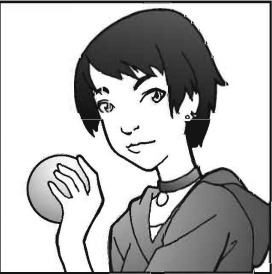
Wilma Strauss (17)
The current dorm mother for the neophytes, the "Magical Basics" teacher, and the official greeter for new students. (Where was she in that comic I posted?) Wilma loves and takes her jobs seriously and will cut you if you try to hurt any of the neophytes in her care. She also tends to be the go-to person for when the other students need the teachers to do something, as she is well respected by them. She has a mundane boyfriend named Doug, and she hates Lillian for some reason.
Wilma has a normal Insider spread for a character her age. She has the Goody-Goody and Brave talents and the Hex Breaker heritage. She has Divination and Protection 3; Conjuration, Healing, and Mentalism 2; and Alteration and Cybermancy 1. She has no special abilities. She has a witch water orb that lets her locate the neophytes and teleport to their side when they're in trouble, and her "spun willow" wand gives her -1 zap to all spells, +1 to Protection and Healing casting spells. She also owns a vespa scooter named Raspberry that can drive itself and communicate with her via beeps and its lights.
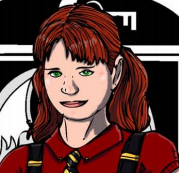
Winifred Scott (13)
Winifred comes from a family of Appalachian hicks who are in a Hatfield-McCoy style feud with another Appalachian hick family, except somebody from her family turned someone from the other family into a pig, and that's pretty much how they duke it out with each other. She's down to Earth and laid back, and she'll turn you into a pig if she doesn't like you.
Winifred has a normal Rustic spread; the Green Thumb and Scrappy (which isn't mentioned anywhere else but gives her +1 to rolls in combat) talents and the Hexer heritage. She has 3s in Alteration, Curses, and Elementalism. Her signature spell is "Suuuuueeeeee!". It's Alteration 3. Guess what it does.
By the way, if you're a stickler for following game canon, Willow-Mistt only has room for one more initiate. 14 of the characters on this list are initiates.
And that's it for all of the chapters! Time for another...
 HORRIBLE PICTURE ROUND-UP!
HORRIBLE PICTURE ROUND-UP!

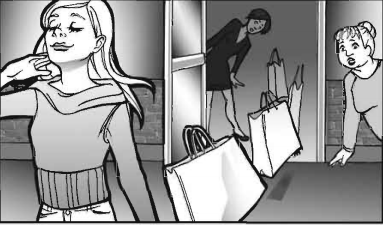
Okay, this one isn't that bad. It's just incredibly smug and a very blatant violation of the flimsy masquerade.
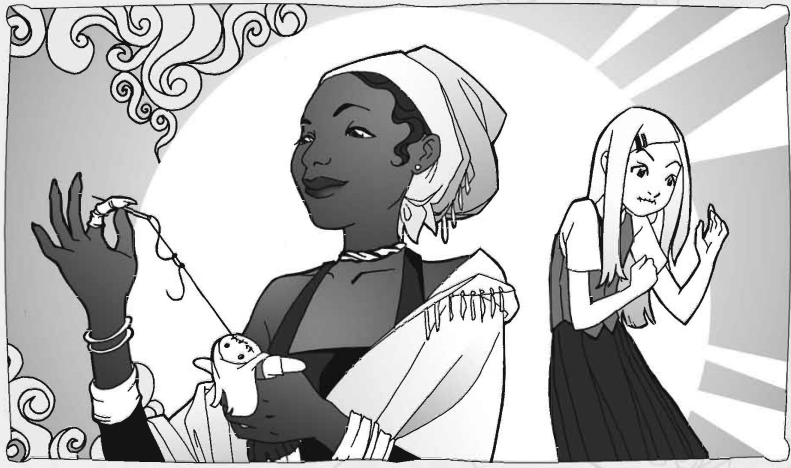
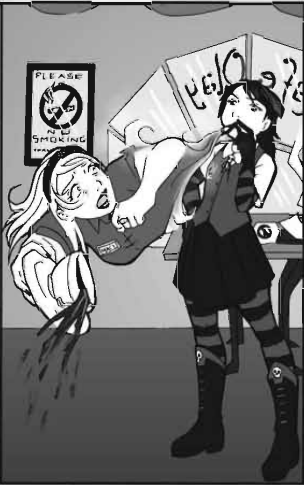
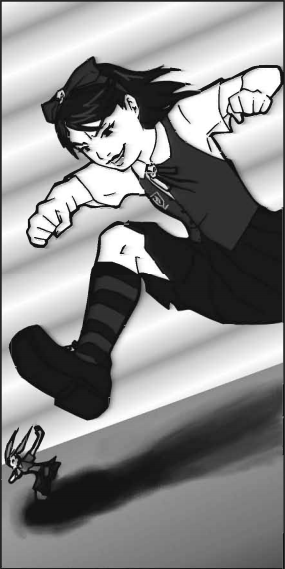
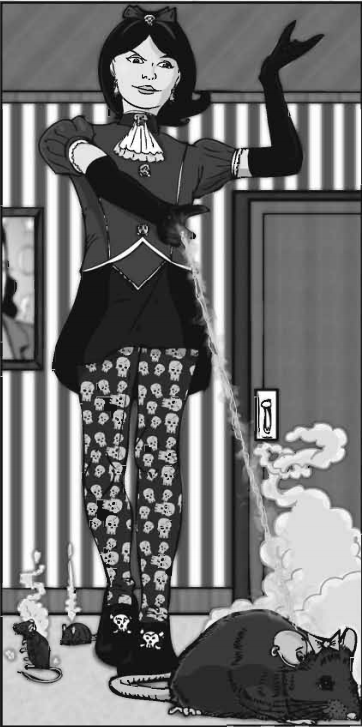
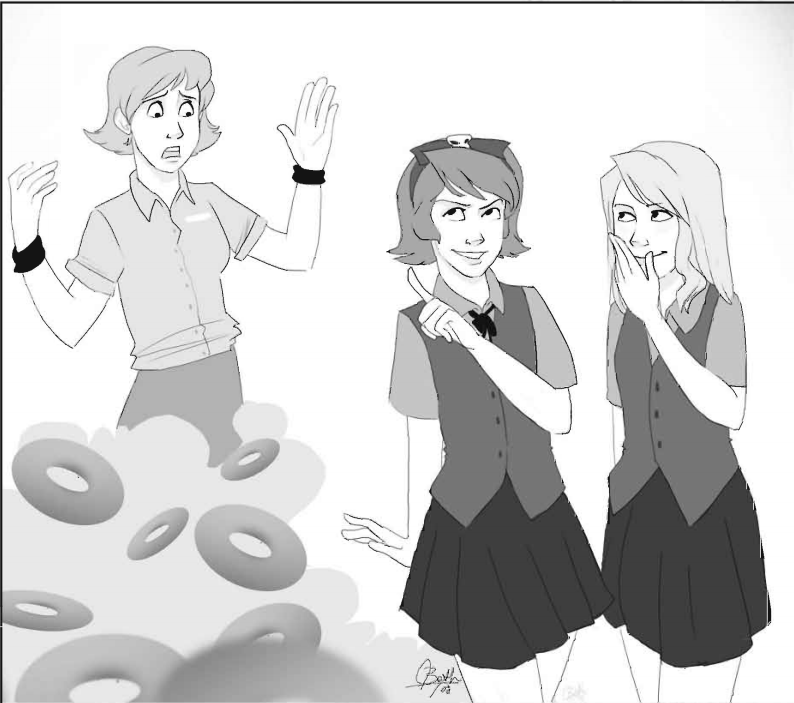
And here's two pictures that I found on the game's Facebook page that didn't make it into the book.
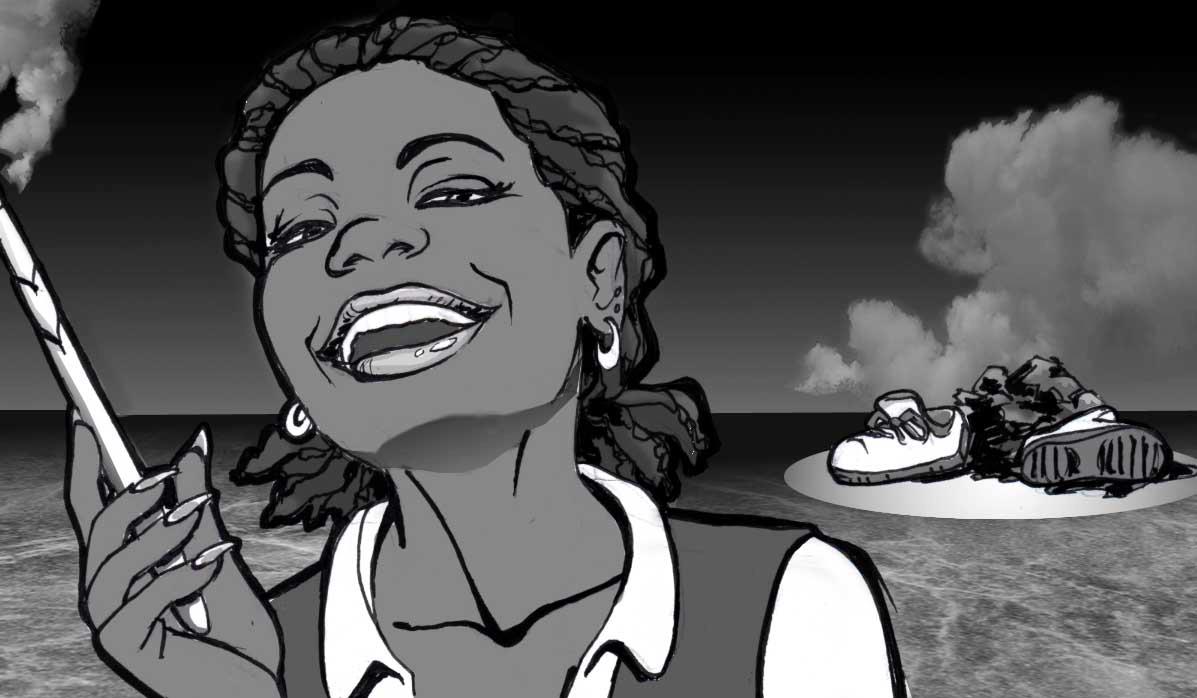
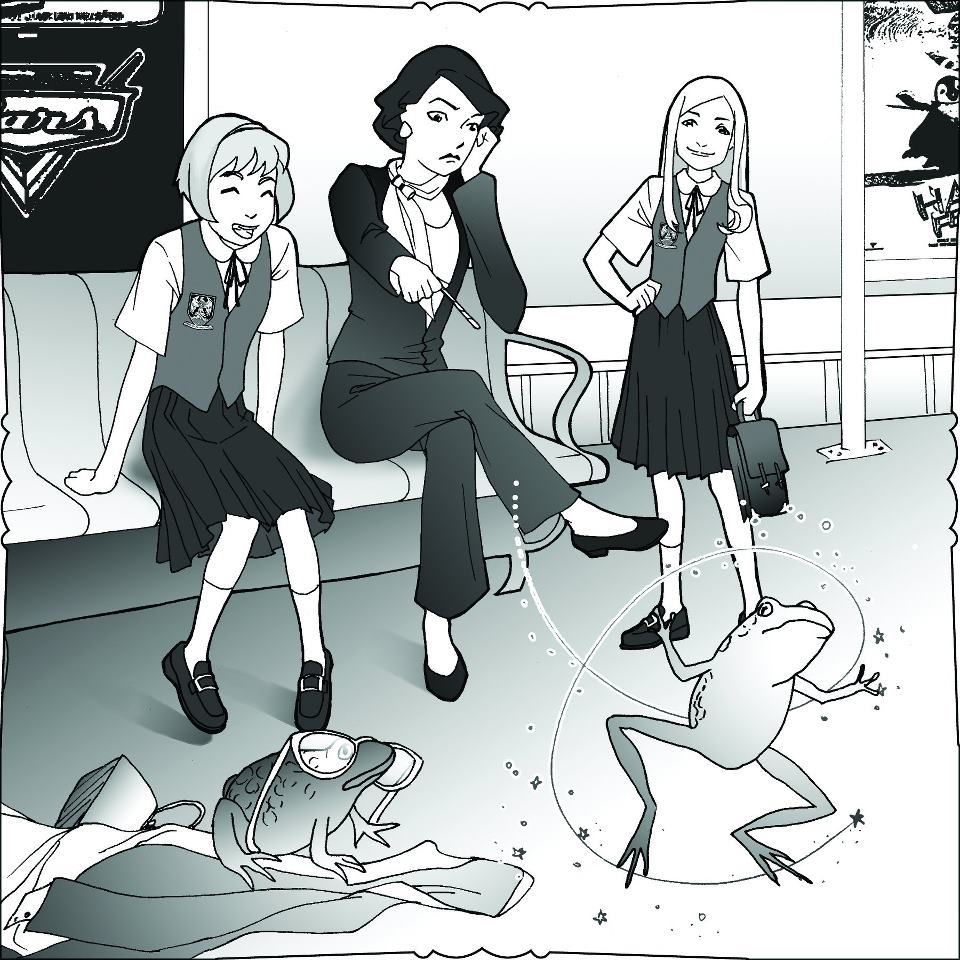
Up next: The appendixes.
Sample Game and Lexicon
Original SA post
Witch Girls Adventures: Sample Game and Lexicon
I was going to put this at the end of my last post, but I forgot. All of the typos are his.
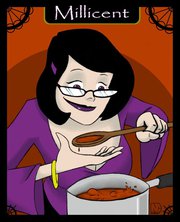
Princess Millicent Areiana Nightbane
The WGA Facebook page posted:
Clique: Sorceress
Location: New York, New York, USA
Age: 19
Job: Culinary Arts Student at City College.
Place of Birth: Darkspire of the Empire [Dude, write a fucking series bible and stick to it.]
Motivation: Live a normal life, Keep her sister Lucinda from causing to much trouble. Keep her sister from finding out the truth about what really happened on the day of their exile.
Attributes:
Body: D6
Mind: D10
Senses: D6
Will: D8
Social: D10
Magic: D12
Life Points: 12
Reflex: 9
Resist Magic: 15
Zap Points 14
Skills:
Art: 3
Bargain 6
Basics 6
Computers 1
Dancing 6
Fighting 2
First Aid 6
Games 4
Gossip 6
Gourmet 8
Instrument 9
Leader 7
Mundane Etiquette 6
Plucky 7
Singing 5
Broom Riding 6
Casting 7
Cryptozoology 7
Focus 5
Herbalism 6
Magical Etiquette 6
Mysticism 7
Potion 7
Spell Breaker 8 [84 mundane/59 magical. An 18 year old starting Sorceress PC gets 16/20.]
Traits: Friendly, Guardian [doesn't show up in any of the books], Princess of the Bruja
Abilities:
Big Sister: +2 to all rolls when protecting her sister Lucinda [This is a separate talent in one of the supplements and applies to witches 4 years old and over who aren't teens.]
Lucinda Bane: +2 to Spell Breaker when undoing Lucinda’s spells
Wards: Millicent has cast several magical wards on herself that allows her to ignore a point of any kind of damage, +1 to Resist magic against harmful spells, +2 Resist magic against divination spells to find her or anyone within 20 feet of her.
Magic:
Alteration 4, Conjuration 4, Divination 4, Elementalism 4, Healing 4, Illusion 5, Mentalism 6, Necromancy 1, Offense 6, Protection 6, Time and Space 4 [48 ranks. A starting 18 year old Sorceress would have 16.]
Equipment:
Glasses: +2 to Look based rolls, is -4 to look based rolls without them.
Allowance:
Special : Millicent and Lucinda brought enough gold and gems with them in magical holding bags equal to several vast fortunes. Millicent controls the money and limits it to about Allowance 7 unless there’s an emergency.
Background:
Born on the throne world of the Empire Millicent grew up as a pampered and princess. In fact in may ways as a child she was just as callous and imperious as her little sister. But that changed the day she almost died.
At age 13 she was traveling with her father on diplomatic mission when their airship was attacked by Pirates. Millicent was separated from the Emperor and taken prisoner. The Pirates threatened to kill if a ransom of 1 billion gold sovereigns was not paid. The Pirates however were just all talk and treated the girl with kindness teaching her games and telling her the truth about her parents evil subjugation of the worlds they ruled over.
When the time came to pay the Ransom the Emperor and Empress came in person along with two air ships full of gold to pay the ransom. When the Pirates appeared the royal couple slaughtered them, raised them from the dead and made them return to their hide out , kill their friends and free Millicent.
Millicent now curious about her families policies started to investigate and over the years learned the pirates were right. Millicent used her position in the court to curb as many of her families policies as possible and came to be known among her people as Millicent the kind. Her parents thought her “kindness” was just a phase and ignored it and treated their daughter with the same love and care as always.
Then came the day everything changed. The Empire fell to the forcers of good and light and Millicent and her sister Lucinda was sent to earth to live in hiding. On earth Millicent found a world where she could be who she always wanted to be. No royal duties and no expectations. After establishing and Identity for herself and her sister she enrolled in City college as a culinary arts student (She loves to cook) and joined the school orchestra (First chair violin).
She now lives a normal life avoiding the politic of earth’s magical world and trying to live as mundane as possible. She also does her best to curb her sister’s wickedness and teach her to be a better person.
The world has no idea the debt they owe Millicent because despite the havoc Lucinda still causes it would be many times worse without her.
Millicent Gossip- (Things about Millicent characters may hear about through Gossip)
Millicent is a pacifist unless you threaten Lucinda
Millicent is dating a mortal named Adam. Adam goes to college with her.
Millicent is actually not a Princess of the empire but is in fact the Empress after her parent’s death.
Millicent was somehow involved in her parents death,
Millicent has cast Spells on Manhattan Island to keep her and Lucinda from being found and to detect spells Lucinda has cast.
Millicent is nearly blind without her glasses.
Story Hooks
Periphery
Millicent has lost her crown and can’t find it. The Crown is a powerful magical artifact and in the wrong hand could lead to untold horror. The Star- Characters are asked by Millicent to help.
Casting: Millicent, Government agents and scientist (Exceptional Mundanes)
Resolution: The Crown has fallen into the hands of a FBI division that deals with the strange and unusual. They think the Crown may be an alien energy source or part of an alien weapon. The Star Characters find the Crown and get it back.
Hide and Seek
Millicent has gone camping with some friends from school and knows Lucinda would not approve. [Why do you need to get her permission to hang out with your friends? You're 19, she's 12. Tell her tough shit, bind her magic or something, and go anyway.] So she didn’t tell her. Lucinda comes home and finds her sister missing and thinks the worse and sets out to find her leaving a path of destruction.
Its up to the Star-Characters to occupy Lucinda, Find Millicent and undo as much of Lucinda’s destruction as possibly.
Cast: Millicent, Lucinda, lots of Mortals (Average Mundanes)
Resolution: The Star Characters follow a set of clues and find Millicent who calms down her sister.
Millicent is the only person that Lucinda will listen to and respects. Not out of sisterly love so much, but because Millicent is the future queen and she is her vassal.
Comicvine posted:
Lucinda is very protective of her sister and sees her as the current Empress of the empire and often sees her duty to her as that of a Vassal and as a Sister.
While there are whole websites for Lucinda, I had to dig to find any information on Millicent other than "she's Lucinda's sister who is a stereotypical boring goody two shoes princess yaaaaawn why aren't you reading about Lucinda?
 ". I figured it would be a nice to take a look at the character that's apparently keeping Lucinda from turning Earth in a transformation fetishist's version of "
It's A Good Life
".
". I figured it would be a nice to take a look at the character that's apparently keeping Lucinda from turning Earth in a transformation fetishist's version of "
It's A Good Life
".
Anyway, the core book ends with five appendixes, an index, and a blank character sheet. (Though the chapter header only lists 4 appendixes.) The first appendix is a sample game that takes place in Willow-Mistt (though the book notes any school can be used) called "Cry Monster!". The game starts with Monica Green calling the 2 to 6 PCs to her dorm room. She's moved all of the furniture to the sides of the room and drawn a rotating "ornate circle" in glowing moonlight paint on the floor.
WGA posted:
Monica greets the characters in her normal, polite but matter-of-fact manner: "I know I'm not the most social of people. My therapist says I have trust issues, or at least he said it until I made him disappear. And though you may feel inclined to say no, I really need your help." Monica pauses and tries to gather the strength to make her request.
"I have made perfect grades since I was four in school, [What kind of preschool gives out grades?] but Mr. Kroft thinks my lack of willing class participation in his silly Literature class theatrics is grounds for a less than satisfactory report. [It is. He obviously bases part of his grades on participation and you're not participating. Ergo, you're getting a lower grade. It's not rocket science.] This week, however, he gave us an assignment on epic poems and said for extra credit we can make a presentation, magical or mundane, as long as said presentation has to do with our poem."
Long story short, she's going to summon Grendel from Beowulf for her project. (There's a dimension in WGA where the imaginaries hang out called the "Marches of Imagination" which sounds pretty much like the Temenos from Mage: The Awakening .) If any of the PCs refuse, she will keep asking them and eventually start bribing them with different magical items and tutoring until they do agree. Once everyone agrees, they keep making rolls until the summoning works. Wisps of smoke leave all of their mouths, and then they're all knocked unconscious, losing 2 health and getting a -1 Body roll penalty. (There is no way to resist it.) At this point, anyone who didn't need to be convinced to help Monica gets a voodollar.
When the PCs come to, Monica's missing, there's slime near the room's balcony, and claw marks everywhere. If they succeed a Hard Mysticism roll, they learn that the creature needs life force to enter the real world, hence the mouth smoke. If it gets "enough" it becomes "truly evil and harder to stop".
The writeup then prompts the GM that the characters need to somehow remember that unsupervised summoning is against school rules and they will be looking at some of those dreaded demerits if the monster gets traced back to them. Whoever figures that and the life force thing out first gets one voodollar.
Next, the characters have to start finding Grendel. The book gives the GM a few suggestions for how to light the fire under the butts of any stragglers. (Ms. Kroft comes in, having left the summoning energies; a PC with The Sight gets a vision of Grendel attacking them or them cleaning cauldrons, etc.) There's no hard directions for this part, just some stuff about tracking rolls, some helpful spells, and the book coaxing the GM to bring Circe Woodsworth into the game to add some extra tension (she could be acting as Ursula's spy and tattle on the PCs). They get bonus voodollars for using tracking or spells to find it and for covering the situation up if need be.
However they go about doing it, their search leads them to the kitchen. The players are attacked by seven poltergeists, who they eventually learn are the remains of Molly after the creature tore her apart, because apparently one friendly ghost equal seven evil ones when you divide it up. They're clearly the angry sun from Mario 3.
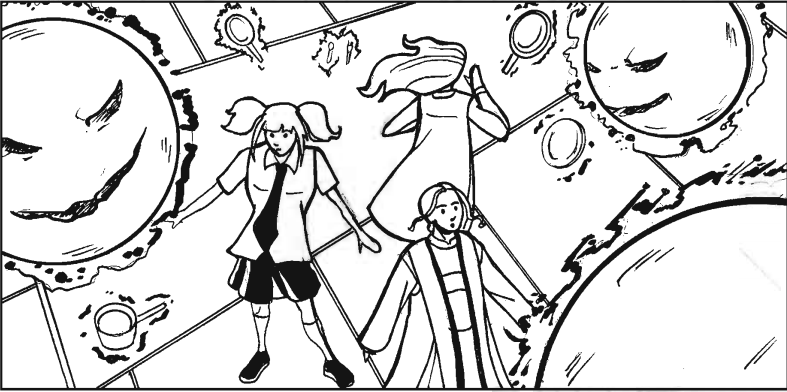
When Molly is reformed, she tells the PCs that Monica came into the kitchen, transformed into the monster (by turning inside-out), tore her apart, and then ate a shitload of food before leaving. Whoever figures out it's Molly and thinks to put her back together gets one voodollar each.
The PCs follow the creature out the back door and into the woods. In the woods, they come across a frightened Melody Kroft, who was "collecting fairy fire for an art project" when Grendel came across her. Grendel tried to sniff her out, but she made everything smell like peppermint. She tells them that the monster headed towards the lake. After while crossing the lake, via a swan paddleboat on the docks or magically, they come across a few fishermen searching the water with flashlights. When they listen in, they hear them talking about a massive "catfish" that might be Moan 'n' Groan, heading toward the Kings' farm. Just as that's mentioned, the PCs hear gun shots from the south shore of the lake.
Located on the south shore is a farm belonging to a bunch of rednecks.
WGA posted:
"I told ya that was a bear!"
"Looks like a big dog, but it ain't getting our pumpkins!"
"There it goes!" (Gunshot)
"Vance, that's me ya idget!"
"Sorry, Luther!"
Meet the King Boys: Troy, Vance, and Luther. They're 13, 14, and 15 years old (which is which is anyone's guess) and are the proud sons of "Ma and Pa King". Their bio claims that they're thieves and troublemakers and once tried to vandalize W-M's school bus on a trip to town. They got teleported to the top of Buccaneer Hill for their efforts, and since then, they think W-M students are aliens.
The boys will immediately attack the PCs, not because they're Willow-Mistt students, but because they're dumb hicks and think they're the monster. All three boys have the same stats: D2 Mind, Will, and Social, D4 Magic, and D6 Body and Senses. They each have a rifle that does 12 damage, but the book notes that any attacks with it will always miss (because they're just bad shots). Surprisingly, the book doesn't encourage the use of Alteration spells or outright murder. Any character that beats or outsmarts them without magic gets one voodollar. They'll eventually give up once things get too "dangerous or weird", but don't know where the monster went.
After some more blind tracking and magicing, the PCs come across some monster tracks leading into a cave in the hills. The cave is at the top of a steep cliff, which can be climbed for flown up while Grendel hurls rocks down at the characters. (Body vs Reflex; target must make a Easy Athletics roll if they're not hit or a Hard one if they are to not fall.) When they get up there, Grendel has turned into Monica and pretends to be pinned under a rock. He attacks regardless of whether or not they fall for it.
Grendel is an imaginary. His Body attribute (D10) is listed twice due to a typo, and he has a D6 in everything except Mind (D4). He has Legendary Strength 3; is immune to Alteration and Illusion spells; only takes half damage from all other spells; and has +1 Resist against all spells. He can attack using his teeth and claws, a scorpion tail (10 foot range, 10 damage and a Hard Body roll to resist being poisoned, which gives a PC -3 to all rolls and halves her Reflex and movement speed), and by spitting slime that sticks anyone who fails a Very HardBody or Athletics roll to the ground. He can also climb the walls of the cave. He doesn't have any of the usual abilities that imaginaries have.
The book notes that the PCs can either defeat Grendel in battle, unsummon him with a Conjuration 3 spell, or separate him from Monica using a Mentalism 2 or Alteration 2 spell, ignoring the fact that it mentions on Grendel's sheet that he's immune to Alteration spells. Separating the two will presumably unsummon Grendel. If a PC researches such spells, they get a +3 to cast it. Once Monica is free, the Body penalties and lost health from earlier will be returned to the PCs. Separating Monica gets the PCs one voodollar each.
The last bit involves covering up the entire incident and bribing anybody who might talk into shutting up. (If Circe is involved, whether or not it works is up to the GM, even if the PCs threaten her like the book suggests). If they fail to do so, Amora will call them all into her office, commend them for trying to cover up their own mess and showing some "maturity" in doing so, and put them on dorm suspension and cauldron cleaning duty for a week. (Monica gets two weeks since she started the whole thing.) If they do succeed, they will have one day of kitchen cleaning detail with Molly, since that's what it would take to get her to not talk. The final reward is two voodollars each.
The appendix ends with a picture of Amber trapping Gollum in a cage for some reason.
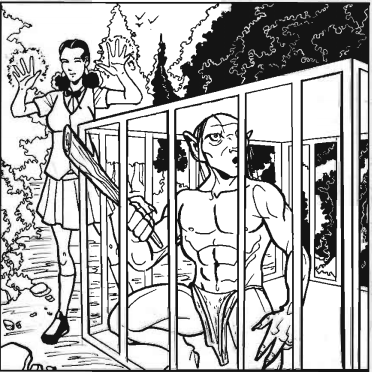
Appendix 2 is a lexicon of words that don't appear anywhere else in the book to support the fact that they are actually used in witch society. They're kind of dumb and just make witch society look even more hypocritical since most of them are taken from mundane culture.
WGA posted:
Ajaxium: Noun. Proper term for an immortal. Often used as a term of respect for an immortal.
Brooming (Broom'n): Verb. To run away really fast. To travel very fast on a broom.
Conjure Woman: Noun. A witch who has had a less than proper education or a witch close to nature. Almost always derogatory.
Darren: Noun. A mundane husband or boyfriend of a witch.
Elf: Noun. A fae or a witch who takes on fae-like mannerisms.
Endora: Noun. An older witch known for her wickedness or flamboyant nature.
Familiar: Noun. A magical pet.
Hag: Noun. An insulting name for a witch and/or a witch with Hags Syndrome. Very insulting. [So it's the N Word of the witch world?]
Imp: Noun. Any small, mischievious, and annoying magical creature, including witches' pets.
Kitchen Witch: Noun. A lower class witch born and raised in magic society.
Lilly: Noun. A witch who tries to follow the old ways and refuses to change with the times.
Maga: Noun. A proper title for an older witch or a witch teacher or instructor. Not commonly used but can be used to replace Miss, Mrs., or Ms.
Merlin: Noun. Warlock.
Morticia: Noun. A witch who is into the gothic sub-culture.
Mundane: Noun. Human. Especially a human living a boring, nonspectacular life.
Nosferatu: Noun. A common term for vampires favored by older vampires.
Outlander: Noun. Creature or being from an alternate reality.
Sabrina: Noun. A young witch trying to hide who she is.
Samantha: Noun. An adult witch trying to hide who she is and living among mundanes.
Thena: Noun. Short for Athena. A slang term for a witch who is also a great athlete. A witch who seems good at everything she tries.
Toad: Verb. To transform a mundane into someone else.
Toadies: Noun. A mundane who knows witches are real. Derogatory for a mundane friend or servant of a witch.
Wand-Witch: Noun. A witch who uses a wand. Also can be used as an insult for a witch who must use a wand to cast most or all their spells, despite her age.
Whoo-doo: Noun. Magic. Can be used as a verb as the act of doing magic.
Witch Girl: Noun. A witch under the age of 19.
Zap Happy: Adjective. Casting lots of spells.
Up next: Story ideas and some other odds and ends.
Story Ideas, Witch Names, and Class Schedules
Original SA post
Witch Girls Adventures: Story Ideas, Witch Names, and Class Schedules
Appendix 3 is a list of 10 story ideas that GMs can use to make their own games.
Aliens! - A UFO is sighted over the PC's town. Gary Reed and all of the other conspiracy nuts (represented using freelance witch hunter sheets) converge on it, threatening the flimsy masquerade. Oh, and the aliens are real. The game ends with the PCs convincing the nuts to go home.
The Dance - The big school dance is coming up and the PCs need to find dates among the mundane populous. Oh, and there's mean girls trying to stop them too.
Discovered - A mundane finds out about the PCs being witches and blackmails them into doing shit for them. Surprisingly, the ending does not involve killing or transforming the mundane, but convincing them otherwise.
Lord of That Thing - Lord of the Rings , only Frodo is a fae named Bippo, the ring is a golden egg, and the epic journey to throw it into the fires of Mount Doom is replaced with a trip to the magical forge under the warlock Clarion's house.
Mistaken Identity - Some witch who looks just like one of the PCs is causing trouble. The PCs try to stop her.
My Fair Witch - A mundane friend of one of the PCs comes to visit. They all try to convince everyone that the friend is a witch. The book suggests using Lucinda and Circe as villains if the game is set in Willow-Mistt.
Shrunk - Honey, I Shrunk The Kids with magic and fetish undertones. Next.
The Gnomes are Coming! - A group of gnomes are kidnapping people and putting them to work as slaves in their mines. The PCs have to save them.
Vampire, The Musical - A vampire goth band consisting of a sire and his childer (not in those words, of course) comes to town and wants to eat the PCs. I think I saw a plot hook similar to this one in one of the Vampire: The Requiem books, only without the wanting to eat a specific group of people part.
Wacky Cousin What's-her-name - One of the PCs' idiot witch cousins shows up for a visit and starts causing trouble, which may lead to the all-important masquerade being broken. She ends up saving the day instead somehow.
Appendix 4 is a list of names for PCs.
WGA posted:
In the world of Witch Girls your name is power. A witch with a name that's seen as weak or common will in turn be a very weak and common witch. Through out the history witches have used not only powerful names but particular naming conventions.
The list is full of pop culture references (Samantha, Sabrina, Prue, Piper...) and any special snowflake girl names Harris could think of. Oddly enough, "Ashley", "Jennifer", and a couple of other common names are in there. I guess that thing about weak name = weak witch was bullshit. But then, it's a bullshit idea to begin with, in my opinion.
And yes, "Circe" is on the list too.
The last appendix is the school schedule generator for Willow-Mistt students. Like I said earlier, you roll a D4 and consult charts that are given for each period. The book messes up and says that there's a homeroom class from 8 to 9:30 on Mondays, Wednesdays, and Fridays, but then says that the first class starts at 9, allowing the students to sleep in or eat breakfast. Also, there's apparently no homeroom on Tuesdays and Thursdays for some reason. Lunch is from noon to 1, with a study period going from 1 to 2 on Tuesdays and Thursdays because of the long classes. At the end of the day on Tuesdays and Thursdays is also an odd free choice that runs until after 4 pm.
The next part lists all of the extracurricular activities. These are: Ariel Expertise Team (sic), Choir, Circe Team (who compete in Alteration competitions), Cooking Club, Drama Club, Equestrian Training, Hex Scouts, Highbinders, the student paper, Orchestra, Martial Arts, Mundane Sports Team (who are apparently a soccer, baseball, or track and field team depending on the season), Spelling Bee (as in casting spells), WHAM, and Tutors.
The last part is rules on how a PC's class schedule can affect voodollar costs. Taking classes in subjects can lower the voodollar cost to purchase or raise the corresponding skills and magic types by 5. Most mundane classes lower the cost of the Basic skill. Phys Ed corresponds to the Athletics skill and team sports lower the cost of the Sports skill. Choir and Orchestra lower the Singing and Instrument skills cost. The rest apply to their corresponding magic skill or type.
The only other thing of note in the core is the ads near the back. Most are for the other WGA supplements while two are for some proto Monster High franchise thing that only consists of abandoned blogs, and this thing, which I'm pretty sure is committing copyright infringement by using actual anime characters.
So that's WGA. All in all, it's a very good example of what NOT to do when making a tabletop game, especially one for kids. In my opinion, it is not worth any amount of money that Channel M asks for it, especially not 20 bucks, which is what the hard cover version went for before he pulled it from the site. Even without the creepy and mean-spirited undertones to it, it's still a sloppily edited mess. Being an indie company is not an excuse for putting out a half-assed product.
In conclusion, use another game, or tweak this one's system and use the setting from Harry Potter or some other magical school series instead.
Now, for the supplement books. I'm not really up to doing all three of them at the moment and from what I've seen during my quick scans, they're not as bad as the core in terms of smug, creepy fetish shit. (But it's still there.) But I am willing to go over anything from them that you guys are interested in. All of them introduce new talents, heritages, spells, items, and NPCs along with their main subjects.
The Pirates of Buccaneer Hill - Pre-made campaign. Zombie pirate ghosts have been spotted in Willow-Brook and it's up to the PCs to figure out what's going on and save Amora Mistt, who gets kidnapped at one point. It includes another intro comic with the five girls and some smaller story ideas that can be used alone or as side quests. It's fairly inoffensive, but does feature Lucinda's one other appearance in the game material: A subplot where she holds the entire student body of Willow-Mistt hostage because she lost a god damn ring.
Pirates of Buccaneer Hill posted:
Ring Toss
Where: Willow Mistt academy
Contact: Princess Lucinda
Description: Princess Lucinda has lost a ring. It once belonged to her now dead father and means a lot to her. Her considerable magic power has been unable to find it. Unless someone uncovers it soon she'll turn every student into something one at a time until the ring shows up or there are no students left.
Cast: Princess Lucinda and Chuckles the Clown (Imaginary)
Resolution: Chuckles, an Imaginary created by a neophyte's fear of clowns, is pulling pranks. One of those pranks is stealing Lucinda's ring. The clown must be stopped.
Prize: 2 voodollars plus the voodollars for defeating Chuckles.
All About The Voodollars - Stuff about how to handle exp/voodollars, the ladies on the bills, and how the witch economy works. (They stole the idea of money from us after gawking over the fact that we were able to come up with it without their help.)
13 Magazine: Issue 1 - A mostly in-character magazine featuring a more extensive writeup of the Argus Society, ideas for campaigns about babysitting and dating vampires, and a horrible advice column written by Denora Desade, as well as item and spell lists written as articles. This one seems to have the most smug, creepy shit in it, and nearly all of the art is Soto's traces. If I do a complete writeup of one of these, it will probably be this one.
And with that, it's time for one more...
 HORRIBLE PICTURE ROUND-UP
HORRIBLE PICTURE ROUND-UP

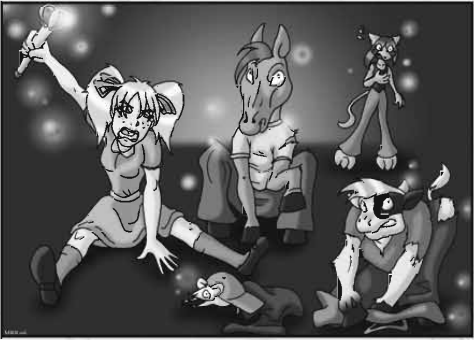
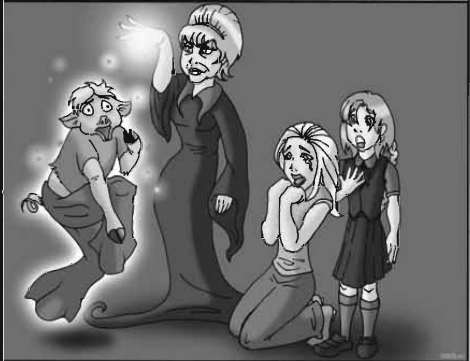
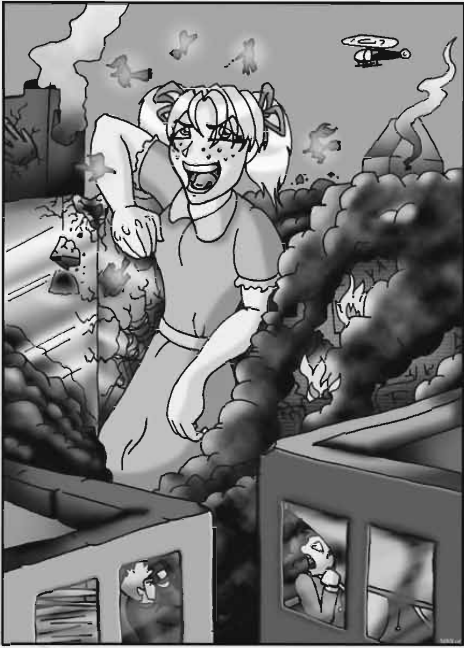
And two more of Lucinda being an asshole for the road.
